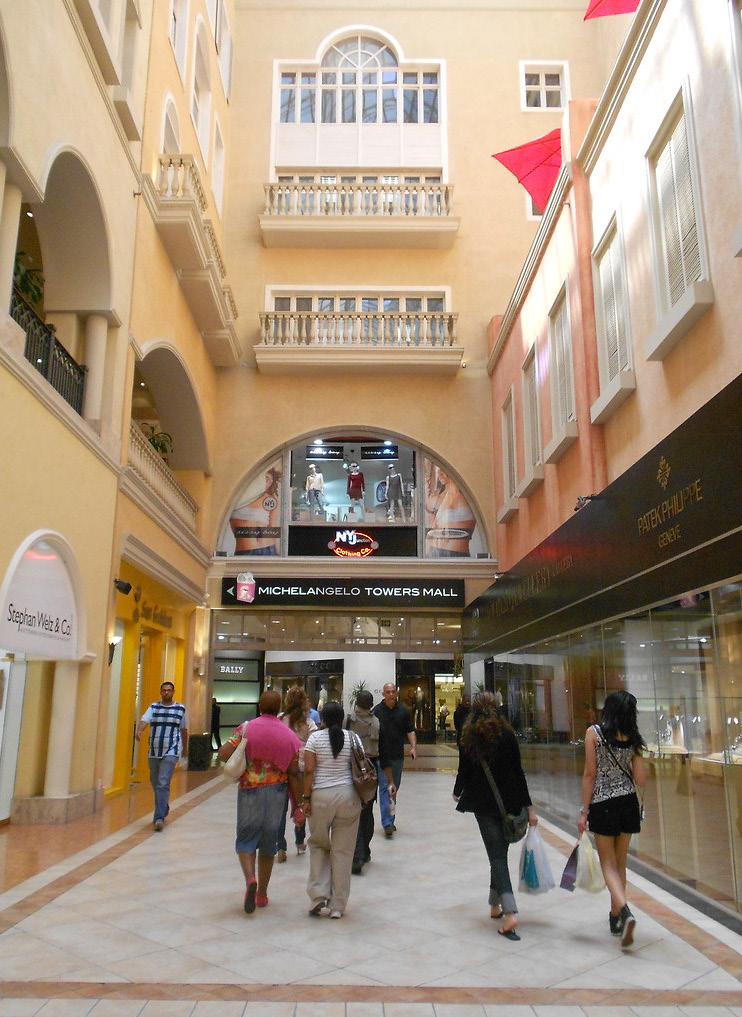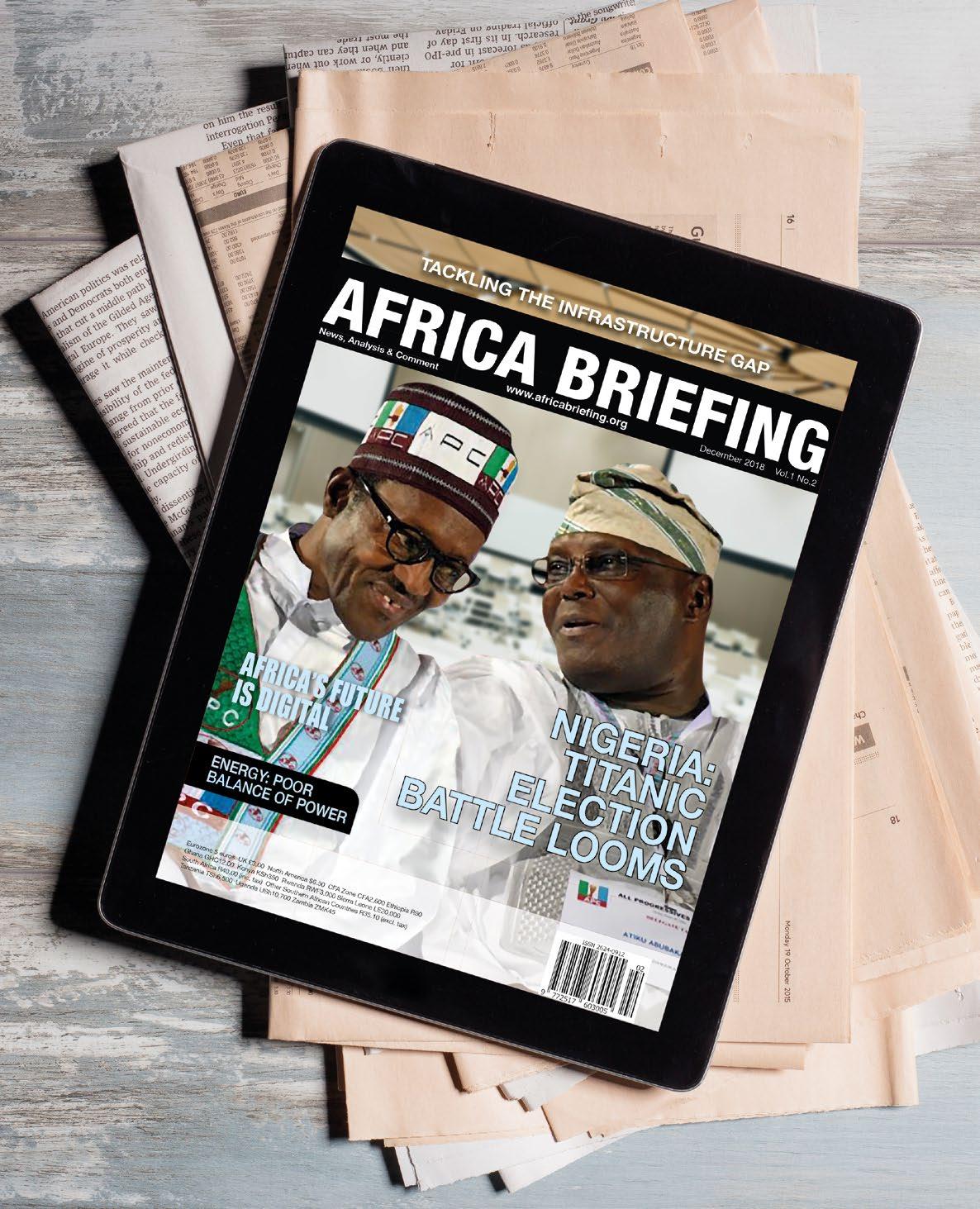
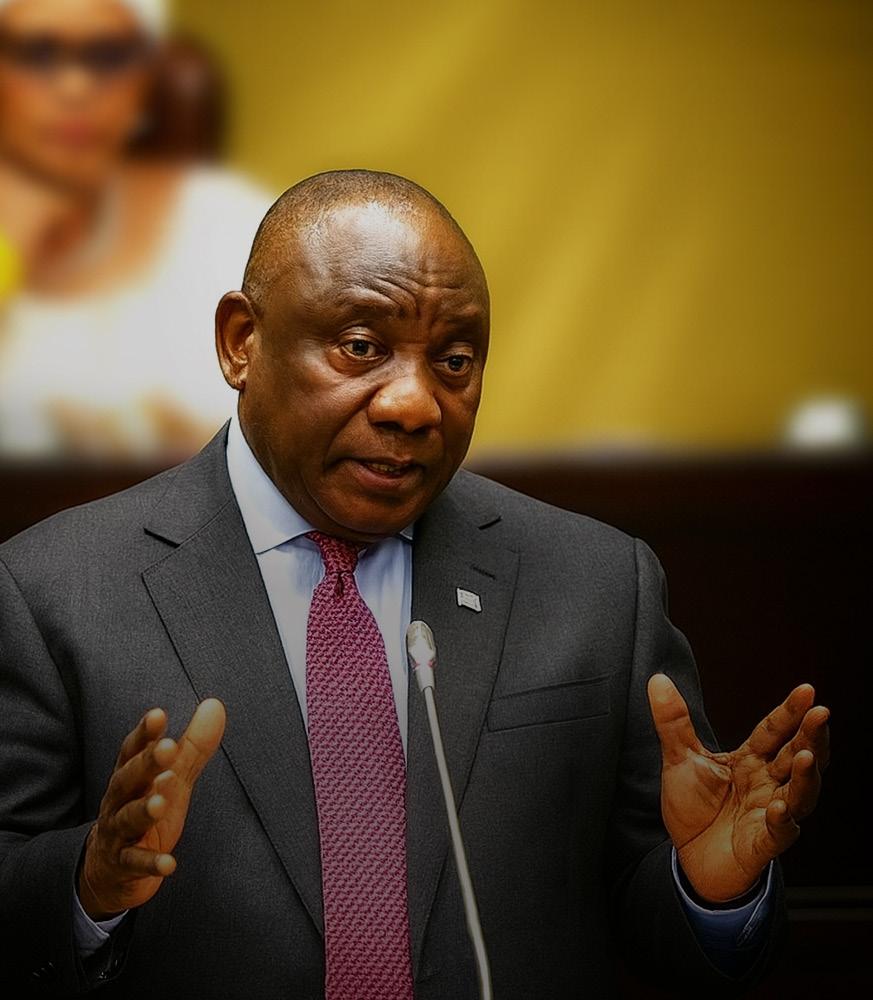

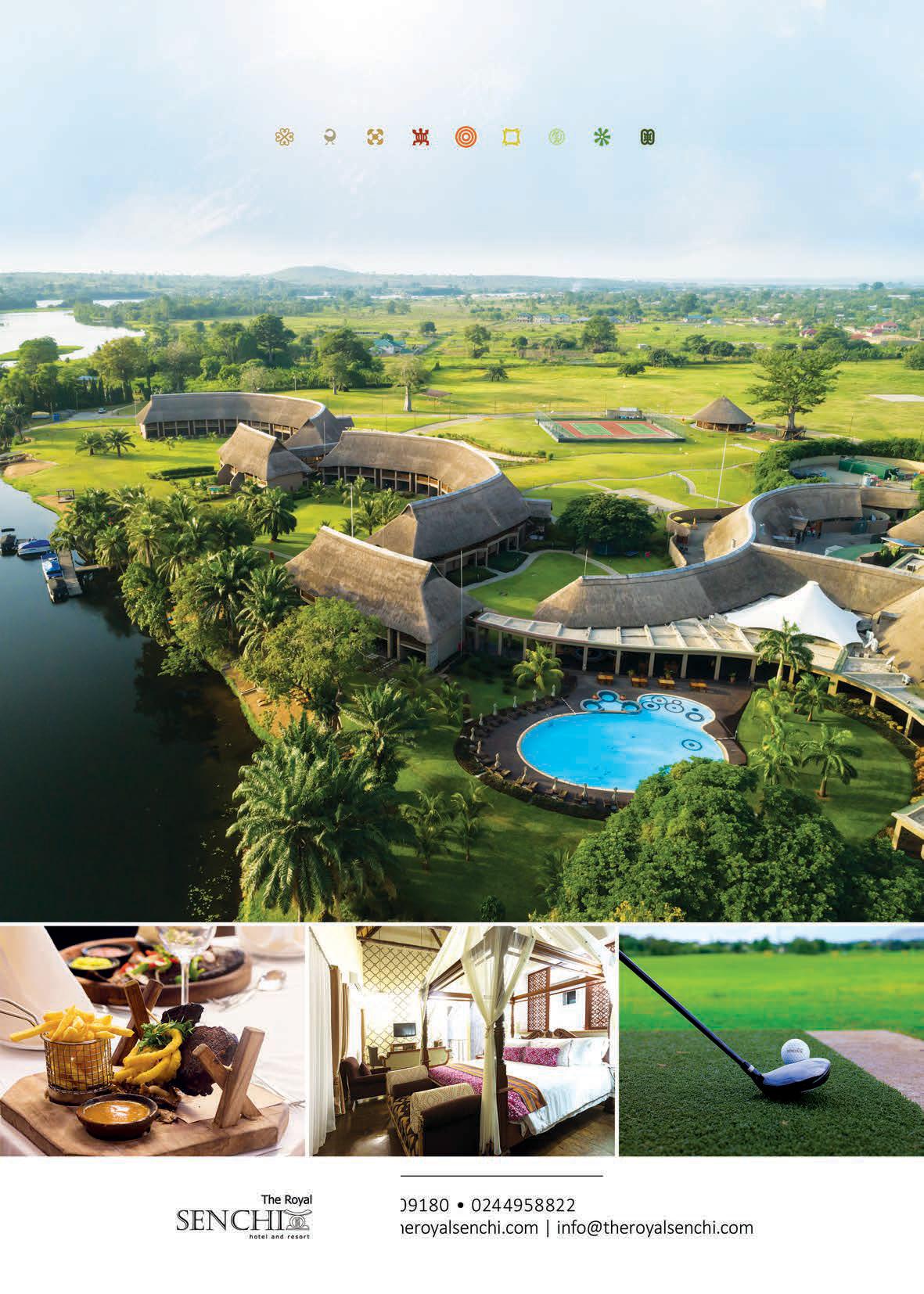









WHEN President Cyril Ramaphosa declared South Africa ‘broken’, he did more than show candour. He exposed the depth of his own political fragility. His proposed National Dialogue— nine months of consultations across provinces to address unemployment, racial inequality, crime and land reform— sounds grand. But for a country crippled by blackouts and staggering joblessness, the idea feels like a costly diversion rather than a credible solution.
A spectacle with shaky foundations
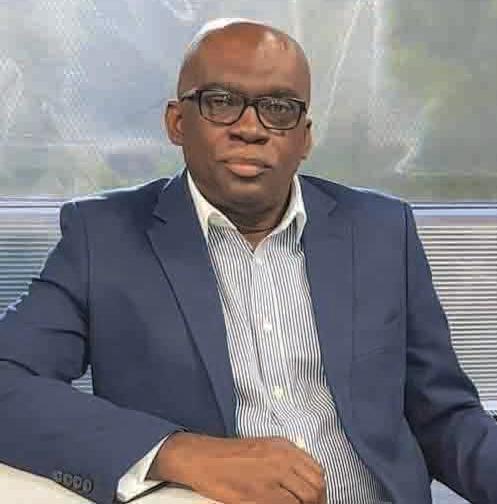
Publisher Jon Offei-Ansah
Editor Desmond Davies
Contributing Editors
Prof. Toyin Falola
Tikum Mbah Azonga
Prof. Ojo Emmanuel Ademola (Technology)
Valerie Msoka (Special Projects)
Contributors
Justice Lee Adoboe
Chief Chuks Iloegbunam
Joseph Kayira
Zachary Ochieng
Olu Ojewale
Oladipo Okubanjo
Corinne Soar
The ‘Eminent Persons Group’ of public figures such as rugby captain Siya Kolisi, actor John Kani and former Constitutional Court judge Edwin Cameron gives the project star power. Yet key voices have already walked away. The Democratic Alliance, Ramaphosa’s uneasy coalition partner, dismissed the effort as hollow. The uMkhonto weSizwe Party is boycotting. Even the Thabo Mbeki and Desmond Tutu foundations—pillars of democratic moral authority—have withdrawn, citing rushed planning and a price tag of R700 million ($38.5 million). In a nation where millions live in poverty, the symbolism is hard to justify.
Reputation management, not reform
IJon Offei-Ansah Publisher
Kennedy Olilo
Gorata Chepete
Desmond Davies Editor
ANC decay and structural failure
n 2018, six of the 10 fastest-growing economies in the world were in Africa, according to the World Bank, with Ghana leading the pack. With GDP growth for the continent projected to accelerate to four per cent in 2019 and 4.1 per cent in 2020, Africa’s economic growth story continues apace. Meanwhile, the World Bank’s 2019 Doing Business Index reveals that five of the 10 most-improved countries are in Africa, and one-third of all reforms recorded globally were in sub-Saharan Africa. What makes the story more impressive and heartening is that the growth – projected to be broad-based – is being achieved in a challenging global environment, bucking the trend.
Deputy Editor
Angela Cobbinah
The timing betrays another motive. With Donald Trump back in the White House and reviving inflammatory claims about land seizures and farmer killings, South Africa again faces a hostile international narrative. Ramaphosa’s dialogue doubles as soft-power theatre, meant to reassure the world that democratic consensus still thrives. Yet no amount of town-hall debate will restore investor confidence while power cuts, crime and policy drift persist.
Stephen Williams Contributing Editor
Director, Special Projects
Designer
Simon Blemadzie
Country Representatives
South Africa
Edward Walter Byerley
Michael Orji
In the Cover Story of this edition, Dr. Hippolyte Fofack, Chief Economist at the African Export-Import Bank (Afreximbank), analyses the factors underpinning this performance. Two factors, in my opinion, stand out in Dr. Hippolyte’s analysis: trade between Africa and China and the intra-African cross-border investment and infrastructure development.
Much has been said and written about China’s ever-deepening economic foray into Africa, especially by Western analysts and commentators who have been sounding alarm bells about re-colonisation of Africa, this time by the Chinese. But empirical evidence paints a different picture.
Despite the decelerating global growth environment, trade between Africa and China increased by 14.5 per cent in the first three quarters of 2018, surpassing the growth rate of world trade (11.6 per cent), reflecting the deepening economic dependency between the two major trading partners.
South Africa’s crisis predates Ramaphosa, but his party bears heavy blame. The African National Congress rode its liberation legacy into complacency, then corruption. The Zuma era entrenched ‘state capture’, draining state coffers and weakening institutions. Ramaphosa inherited a hollowed-out government, but his own hesitation has deepened cynicism. High-level prosecutions remain rare. Eskom’s blackouts worsen. Youth unemployment exceeds 50 percent.
Justice Lee Adoboe
Chuks Iloegbunam
Joseph Kayira
Zachary Ochieng
Olu Ojewale
Oladipo Okubanjo Corinne Soar Contributors
Gloria Ansah Designer
These failures collide with historic inequities. Apartheid’s economic design privileged a minority, leaving the post-1994 state to spread opportunity without spooking investors. Three decades on, land reform is stalled, schools remain unequal and South Africa ranks as the world’s most unequal nation. Growth hovers below one percent—far from enough to reduce poverty or absorb millions of job seekers.
Country Representatives
South Africa
Dialogue is no substitute for action
Empirical evidence shows that China’s domestic investment has become highly linked with economic expansion in Africa. A one percentage point increase in China’s domestic investment growth is associated with an average of 0.6 percentage point increase in overall African exports. And, the expected economic development and trade impact of expanding Chinese investment on resource-rich African countries, especially oil-exporting countries, is even more important.
Supporters hope the National Dialogue might rebuild trust and generate a shared vision. But without binding outcomes and real policy commitments, it risks becoming another glossy report gathering dust. Citizens need functioning power grids, reliable policing and job creation, not speeches in church halls.
The resilience of African economies can also be attributed to growing intra-African cross-border investment and infrastructure development. A combination of the two factors is accelerating the process of structural transformation in a continent where industrial output and services account for a growing share of GDP. African corporations and industrialists which are expanding their industrial footprint across Africa and globally are leading the diversification from agriculture into higher value goods in manufacturing and service sectors. These industrial champions are carrying out transcontinental operations, with investment holdings around the globe, with a strong presence in Europe and Pacific Asia, together account for more than 75 per cent of their combined activities outside Africa.
Edward Walter Byerley Top Dog Media, 5 Ascot Knights 47 Grand National Boulevard Royal Ascot, Milnerton 7441, South Africa
Tel: +27 (0) 21 555 0096 Cell: +27 (0) 81 331 4887 Email: ed@topdog-media.net
Ghana
Nana Asiama Bekoe
Ramaphosa presents himself as the reformer who will heal a fractured nation. Yet this dialogue suggests a leader buying time, projecting activity while avoiding hard decisions. True renewal requires decisive action: prosecuting corruption at the highest levels, fast-tracking land and education reforms, and crafting an industrial strategy to tackle unemployment and energy insecurity.
A survey of 30 leading emerging African corporations with global footprints and combined revenue of more than $118 billion shows that they are active in several industries, including manufacturing (e.g., Dangote Industries), basic materials, telecommunications (e.g., Econet, Safaricom), finance (e.g., Ecobank) and oil and gas. In addition to mitigating risks highly correlated with African economies, these emerging African global corporations are accelerating the diversification of sources of growth and reducing the exposure of countries to adverse commodity terms of trade.
Kingdom Concept Co. Tel: +233 243 393 943 / +233 303 967 470 kingsconceptsltd@gmail.com
Nigeria Taiwo Adedoyin MV Noble, Press House, 3rd Floor 27 Acme Road, Ogba, Ikeja, Lagos Tel: +234 806 291 7100 taiadedoyin52@gmail.com
Kenya
Top Dog Media, 5 Ascot Knights 47 Grand National Boulevard Royal Ascot, Milnerton 7441, South Africa
Tel: +27 (0) 21 555 0096
Cell: +27 (0) 81 331 4887
Email: ed@topdog-media.net
Ghana
Nana Asiama Bekoe
Kingdom Concept Co. Tel: +233 243 393 943 / +233 303 967 470 kingsconceptsltd@gmail.com
Nigeria
Nnenna Ogbu #4 Babatunde Oduse crescent Isheri Olowora - Isheri Berger, Lagos Tel: +234 803 670 4879 getnnenna.ogbu@gmail.com
Kenya
Patrick Mwangi Aquarius Media Ltd, PO Box 10668-11000
Nairobi, Kenya
Tel: 0720 391 546/0773 35 41
Email: mwangi@aquariusmedia.co.ke
This makes me very bullish about Africa!
Until such measures are taken, South Africa’s democracy will endure more strain than any dialogue can mend. Ramaphosa’s legacy now hinges not on the number of meetings held, but on whether he proves that leadership is about delivery, not performance.

Naima Farah Room 22, 2nd Floor West Wing Royal Square, Ngong Road, Nairobi Tel: +254 729 381 561 naimafarah_m@yahoo.com
Africa Briefing Ltd 2 Redruth Close, London N22 8RN United Kingdom
Tel: +44 (0) 208 888 6693 publisher@africabriefing.org
©Africa Briefing Ltd 2 Redruth Close, London N22 8RN
United Kingdom
Tel: +44 (0) 208 888 6693 publisher@africabriefing.org
Multinationals must pay their fair share in Africa
Africa must look after its own health
Reality finally dawns on South Africa
When the South African leader launched a National Dialogue this September to try to put things right in the country, it was the wake-up call millions of citizens have long been expecting as they watched things going downhill while their leaders buried their heads in the sand, writes Desmond Davies
Is xenophobia’s shadow a threat to South Africa’s future?
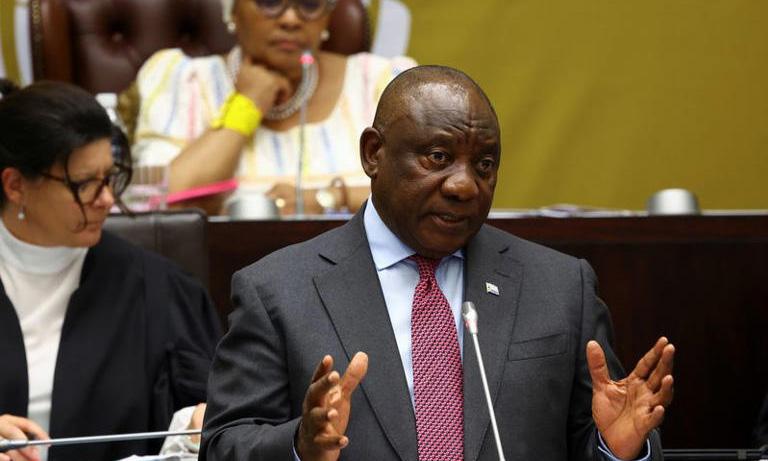
Violence, unequal access to opportunities, health care and education, as well as migrant and refugee policies targeted at foreigners are having a negative impact on South Africa’s post-apartheid vision of an inclusive, non-racial democracy, while also tarnishing its international image, writes Stephen Ndoma
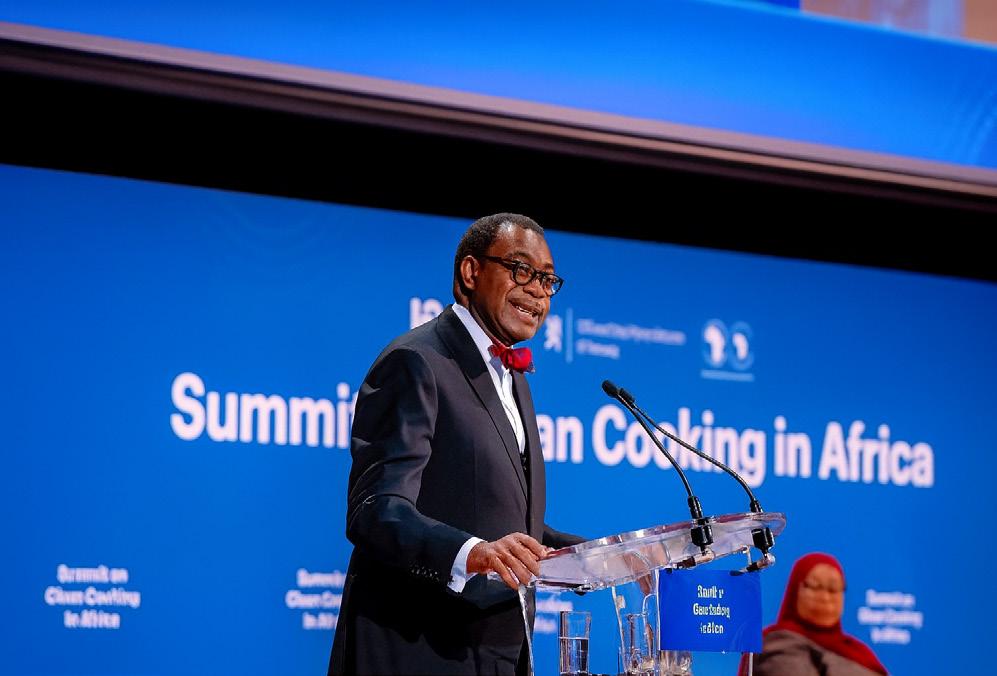
Africa must do better on the rule of law
Evidence suggests that foreign direct investments move more to countries that have political stability, stable democracies, transparency and low levels of corruption, says Akinwumi Adesina
UN at 80 needs mutual collaboration to move forward
As the world body turns 80 in September, Ibrahim A. Gambari offers strategies for taking the Pact of the Future from paper to practice, using Nigeria as an example
Roads to unite Africa’s trade future
In this in-depth analysis, Jon Offei-Ansah examines how a fully connected network of continental highways could unlock the African Continental Free Trade Area’s vast potential—lifting millions from poverty and reshaping regional trade
28 30 18 22
Sahel states test West Africa’s economic order
Jon Offei-Ansah examines how Burkina Faso, Mali and Niger have upended West Africa’s economic order, leaving ECOWAS and forming the Alliance of Sahel States in a bold bid for sovereignty that could redefine the region— or deepen its fractures
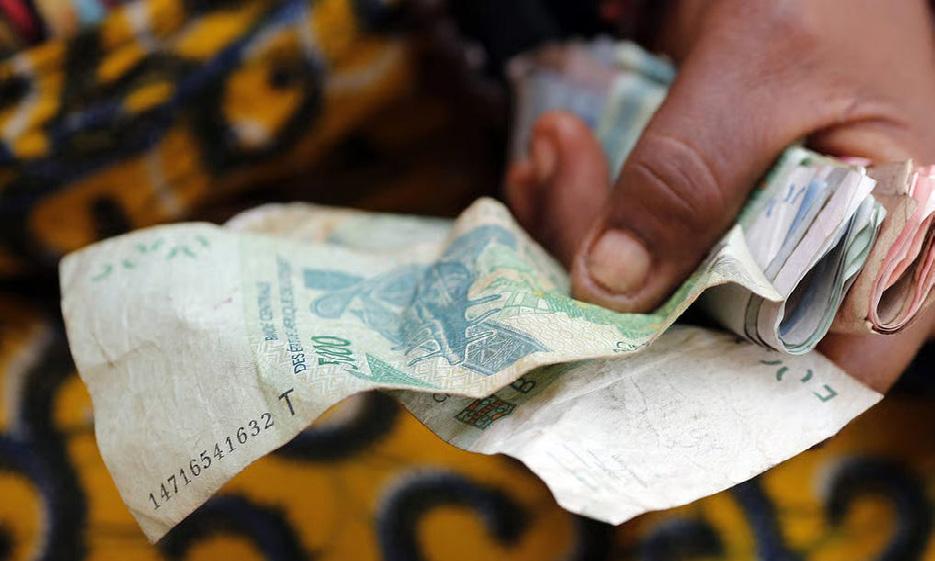
Africa’s AI crossroads of risk and reward
Christopher Burke analyses how artificial intelligence could reshape Africa’s economy, jobs and sustainability, weighing the continent’s vast opportunities against rising risks
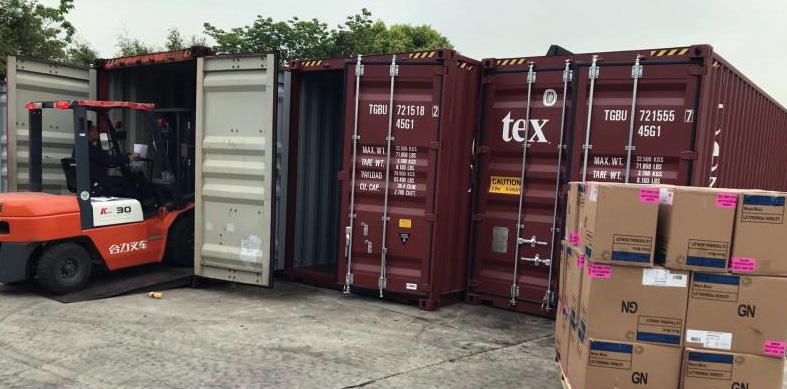
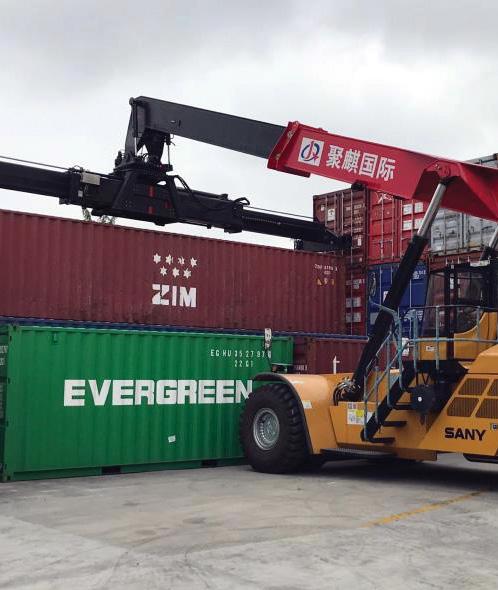
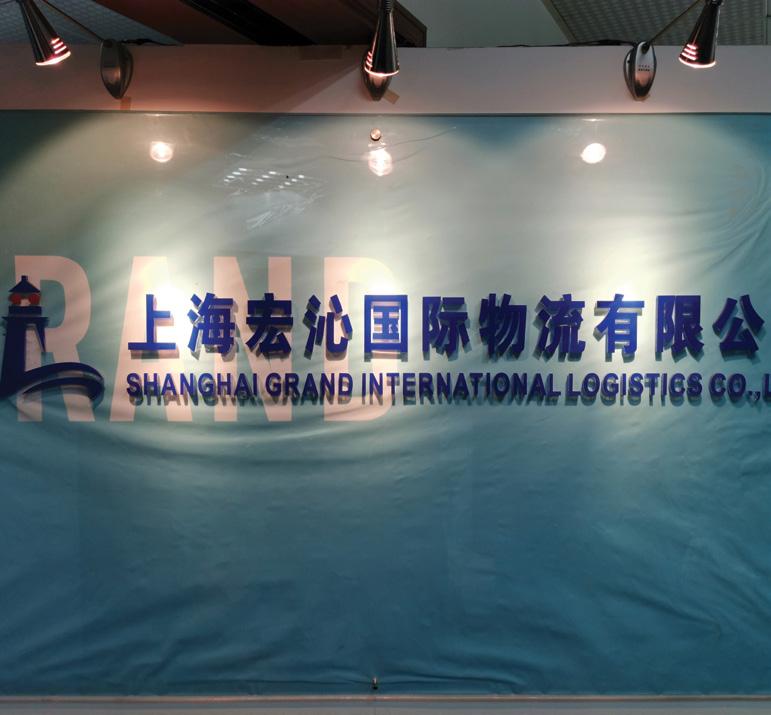
Established in 2002, Shanghai Grand International Co., Ltd. offers a variety of shipping and transportation options via air, sea and ground. Our company is based in Shanghai, China, with branches across the nation. Ranging from customs declaration, warehouse storage, containers and consolidated cargo shipping we have a large array of options to meet your needs.
In addition to being approved and designated by the Ministry of Transportation of China as a First Class cargo service provider, we have also established excellent business relations with major shipping companies including Maersk, CMA, ONE, SM line, and
C.E.O President.
Mr, Felix Ji
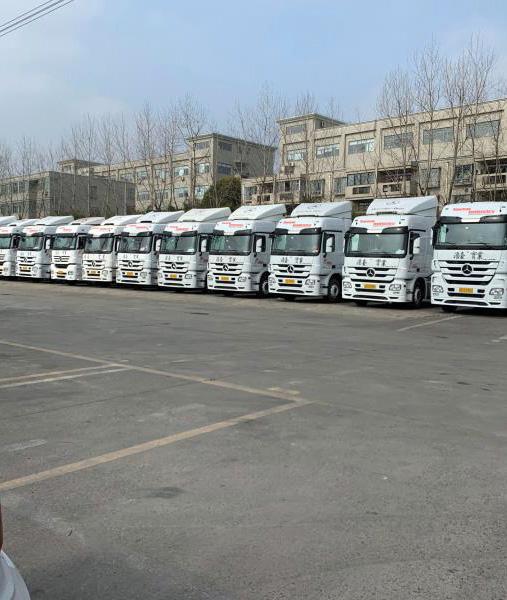
EMC over the past 15 years. In addition we have also built long term business relations with major airline cargo departments. In order to expand our global operation, we are looking for international partnerships to work together in this industry. Should you ever import any goods from Peoples Republic of China please ask your exporter and shipper to contact us. We will provide our best service to you.
Room 814, 578 Tian Bao Lu, Shanghai, Peoples Republic of China
E-Mail: felix@grand-log.net phone: 86-13501786280
FOREIGN aid to Africa is shrinking, with many donor countries citing domestic pressures, austerity measures and changing geopolitical priorities. Yet, even as aid contracts, multinational corporations continue to reap vast profits from Africa’s natural resources, consumer markets and labour force, often while contributing next to nothing to the public purse.
Africa now needs, more than ever before, sustainable revenue streams to fund development. But those most capable of paying are actively avoiding their obligations.
At the heart of the problem lies the weakness of Africa’s taxation systems. For decades, many countries have struggled to build robust tax administrations.
Corruption is another major issue. But corruption and weak tax systems do not explain the scale of the challenge. Structural imbalances, archaic legal frameworks and the dominance of transfer pricing abuse – where companies shift profits across borders to low-tax jurisdictions – all sap governments of their rightful dues.
The situation is compounded by the fact that commercial disputes involving African assets or contracts often play out in European or American courts. Oil concessions in Nigeria, mining deals in the Democratic Republic of Congo, or telecom licences in Kenya are routinely litigated in London, Paris, or New York.
This reflects both the lack of trust in African judicial systems and the legal muscle that Western firms bring to bear. But it has a pernicious consequence: decisions that affect African revenues are made far from the continent, under laws and norms designed for foreign investors, not African citizens.
If Africa is ever to retain a fair share of its wealth, it must strengthen both its tax courts and its contract enforcement mechanisms so that disputes are settled on African soil.
The Organisation for Economic Cooperation and Development’s Convention on Combating Bribery of Foreign Public Officials was meant to address some of these distortions by criminalising the bribery of officials abroad. It is one of the rare instruments
that recognises the corrosive impact of corruption not only on governance but also on development financing.
Yet, enforcement has been patchy. Some countries take the obligations seriously, prosecuting firms that bribe their way into contracts. Others treat it as a boxticking exercise.
The Trump administration’s calls to weaken or bypass this convention were particularly troubling. If the US – which has the capacity to enforce corporate accountability through its own Foreign Corrupt Practices Act – signals that bribery abroad is acceptable, it sets back global efforts by decades. American companies may be prevented from bribing officials at home, but if they are free to corrupt systems in Africa, the damage to fragile democracies and treasuries will be catastrophic.
Western tax institutions themselves provide a cautionary lesson. Corporations like Amazon, Starbucks and Google have all at various times exploited loopholes such as profit-shifting techniques and complex corporate structures, to avoid paying tax even in economies with sophisticated enforcement systems. The difference, however, is that public outrage and investigative journalism in Europe and the US have forced governments to act.
Starbucks was shamed into voluntary tax payments in the UK; the European Union has levied billions in back-tax
countries must act collectively, through the African Union and regional blocs, to legislate against such practices and push for stronger international rules that prevent profiteering from poverty.
So, what can be done? First, African governments must modernise their tax administrations, adopting digital tools to monitor profit-shifting and collaborating with each other to close the loopholes multinationals exploit. A united front, especially in extractive industries, can prevent countries from being played off against each other in a race to the bottom on tax incentives.
Second, civil society and investigative journalists must be empowered to expose tax avoidance and corruption. Just as outrage in Europe forced Starbucks and Amazon to back down, public opinion can pressure African governments and corporations into fairer practices.
Third, Africa’s courts need strengthening. If foreign investors know they cannot simply bypass local justice and appeal to London, they will think twice before structuring deals that exploit weak oversight.
Finally, global cooperation is essential. Rich countries cannot cut foreign aid while simultaneously allowing their corporations to drain Africa of revenue. If the West truly wants to see African self-reliance, it must enforce anti-bribery laws, close tax havens and support African efforts to
aid while allowing their corporations to drain Africa of revenue
claims against Apple. The lesson for Africa is clear: transparency, strong institutions and political will can make even the most elusive corporations contribute.
But Africa also faces uniquely rapacious actors: vulture capitalists. These are firms that buy distressed African debt cheaply, then sue governments for full repayment plus interest in foreign courts. Zambia, Congo and Liberia have all fallen prey to such predators. These firms siphon away scarce public funds meant for health, education and infrastructure. African
recover stolen assets.
’
The drying up of aid need not spell disaster for Africa; but only if the continent captures the wealth that it already generates. Taxation, fairly enforced, is the cornerstone of sovereignty.
It is time that multinational corporations paid actual taxes to the nations whose resources and markets enrich them, and not just lip service to “corporate social responsibility”.
Anything less is exploitation dressed up as partnership. AB
THE other day, the US government announced its new plans to address global health issues after the Trump administration slashed billions of dollars earlier this year from America’s aid budget. NGO-types, who were already up in arms after the cuts, are now even more irate by what they see as another major blow to development assistance.
The “America First Global Health Strategy” released by the State Department marks a dramatic shift in US engagement with international health. It calls for US health assistance to flow directly to countries through multi-year bilateral agreements tied to clear performance benchmarks and co-investment requirements.
For me, the most crucial point is the pledge to ensure that funding goes directly to “frontline health workers and medical commodities”, while technical assistance and overhead costs are sharply reduced.
According to the State Department, “less than 40 per cent of health foreign assistance goes to frontline supplies and health care workers” under current programmes. Therein lies the rub. Whatever happened to the more than 60 per cent of funding?
Is it any wonder that health projects in Africa take so long to deliver? At the same time African governments place their faith in NGOs to sort out health problems that the people elected them in the first place to resolve.
This dependency syndrome has led to Africa’s political leaders sitting on their hands while foreign members of the Third Sector rule the roost on the continent. This does not mean that the NGO-types are better financial managers either.
Take, for example, the Ebola outbreak in West Africa (2013-2016). Financial mismanagement of health funding was on both sides: governments and donors.
When MPs of the British parliament’s International Development Committee visited two of the three West African countries that were in the throes of the
deadly Ebola virus, Liberia and Sierra Leone, in 2014, they were in for a shock
The politicians said they were surprised to discover that only $3.9 million out of $60 million given by the European Union to support Liberia’s health sector was passed on by the country’s Ministry of Finance over a two-year period. Apparently, the $56 million or so had gone walkies.
In Sierra Leone, financial mismanagement was down to the UK’s Department for International Development, the MPs discovered. They just could not make head or tail of DFID’s accounting procedures, prompting the delegation to note: “The Committee was appalled that the Department could not provide an overall figure for its total spend in Sierra Leone.”
Given this and countless similar circumstances, one can understand where the Trump administration is coming from. For the American leader, it is just money down the drain.
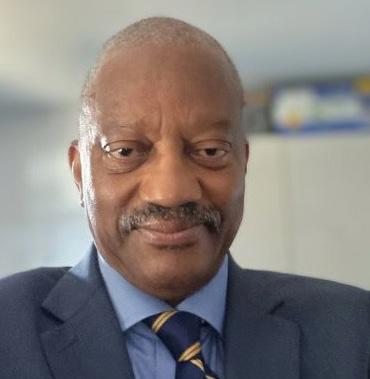
Excellence stands as proof that Africa is ready to compete with the best in global healthcare.
“Our vision for the African Medical Centre of Excellence is not just to provide top-notch healthcare but to serve as a catalyst for the transformation of the African health sector, making a bold statement to the world that Africa is finally taking its destiny into its own hands in healthcare sovereignty and global standards.”
Oramah is spot on. The AMCE is the largest specialised private hospital in Nigeria and West Africa focusing on cardiovascular services, haematology, comprehensive oncology and general medical services. It currently boasts of 170 beds with a plan to expand this to 500 beds upon completion. Positively, the plan is to replicate ACME Abuja across the continent.
This initiative should help to stem the flow of health professionals from Africa to Europe and North America. According to
‘ ’
Africans spend a whopping $10 billion annually on health
It is not that there is no money in Africa to easily fund health facilities. According to the African Export-Import Bank (Afreximbank), Africans spend a whopping $10 billion a year on health tourism, with Nigeria accounting for $1 billion.
But the indefatigable President of Afreximbank, Professor Benedict Oramah, will have nothing to do with this flagrant waste of money. Under his influence, his institution has opened a world-class $300 million African Medical Centre of Excellence (AMCE), in partnership with King’s College London, to cut down on the continent’s dependency on foreign health systems.
At the opening of AMCE Abuja in June this year, Oramah said: “We are making a bold, collective statement: we will no longer accept medical vulnerability as destiny. The African Medical Centre of
the Africa Centres for Disease Control and Prevention, an estimated 16,000 Nigerian doctors got jobs abroad in the past seven years.
In the case of nurses, according to the UK’s Nursing and Midwifery Council, between 2022 and 2024 more than 42,000 nurses emigrated from Nigeria to the UK. In 2024 alone, the Council registered 13,656 Nigerian nurses, up 28 per cent from 2023.
This is the same Nigeria that had a sterling healthcare sector in the 1960s and 1970s. Institutions such as University College Hospital in Ibadan and Lagos University Teaching Hospital held their own globally. Indeed, Nigeria was a destination for medical tourism.
Now, with Trump’s massive aid cuts, things might change for the better so that Africans look after their own health. AB

When the South African leader launched a National Dialogue this September to try to put things right in the country, it was the wake-up call millions of citizens have long been expecting as they watched things going downhill while their leaders buried their heads in the sand, writes
Desmond Davies
ELECTRICITY blackouts, crumbling infrastructure, staggering unemployment and an uncertain political climate have become part of daily life for millions of South Africans. These are the realities that have forced President Cyril Ramaphosa to declare that South Africa is “broken”. Yet for a sitting president to use such blunt language by admitting this signalled more than candour: it suggested desperation.
The question is why now. Is this initiative an honest attempt to revive South Africa’s flagging reputation in the face of global criticism, particularly Donald Trump’s renewed assaults on the country’s stability? Or is it primarily a survival tactic for a president cornered by coalition partners and an increasingly sceptical electorate?
The issue is not only Ramaphosa’s political predicament but also the structural conditions that have brought South Africa to this moment – weighed against the promises and pitfalls of national dialogue.
The National Dialogue, according to Ramaphosa, will run for six to nine months, spanning all nine provinces. Citizens will meet in town halls, churches, schools and online forums to debate
South Africa’s most urgent challenges: unemployment above 33 per cent, persistent racial inequality, rampant crime and the unresolved land question.
To lend credibility, an “Eminent Persons Group” has been assembled, featuring figures like captain of the national rugby team Siya Kolisi, actor John Kani and former Constitutional Court judge Edwin Cameron. Their diversity mirrors the Rainbow Nation ideal: a reminder of a time when dialogue was not just symbolic but transformative.
But scepticism abounds. The Democratic Alliance, now Ramaphosa’s coalition partner, has dismissed the initiative as meaningless. The uMkhonto
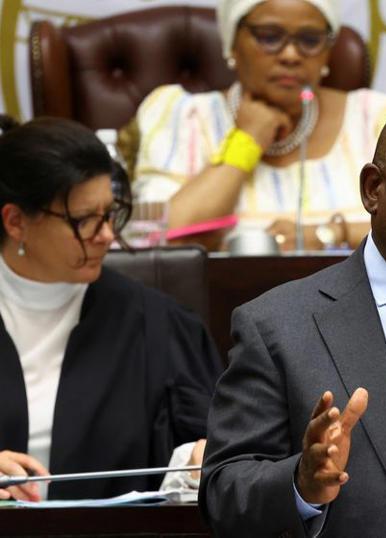

weSizwe (MK) Party has boycotted it outright. The Thabo Mbeki and Desmond Tutu foundations – institutions that embody the moral gravitas of South Africa’s democratic journey – have withdrawn, citing rushed planning and spiralling costs, estimated at R700 million ($38.5 million). The scepticism is understandable: can a cash-strapped state, struggling to provide basic services, justify such an expensive talking shop?
South Africa has long prided itself on punching above its weight internationally. It has hosted peace negotiations, driven African Union initiatives and cultivated a reputation as a champion of multilateralism.
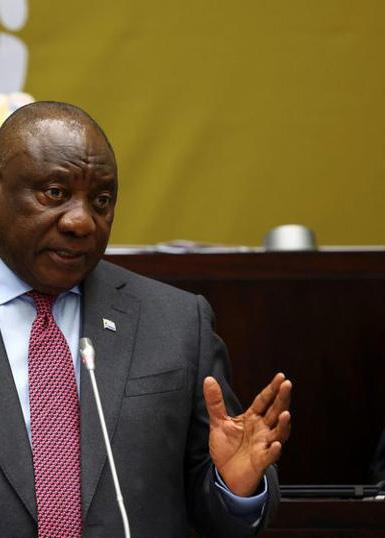
Yet in recent years, that standing has eroded. Zuma-era corruption (“state capture”) was the final straw. The Indian Gupta brothers ensconced themselves within the government, wielding immense influence.
They were later accused of salting away hundreds of millions of dollars from the country. While the rapacious brothers are now settled in Dubai, South Africa must contend with recurring blackouts and declining investment ratings.
Enter Donald Trump. During his first term, he infamously accused South Africa of “land seizures” and “largescale killings” of white farmers, echoing narratives popular among the global far-right. The South African government dismissed those claims, but the damage lingered. With Trump back at the White House and his rhetoric returning, South Africa is once again portrayed internationally as a nation on the brink.
When Ramaphosa turned up at the White House in May this year, the US leader waylaid the South African president. Trump performed a three-card trick: with a sleight of hand, he contrived the impression that, under the ANC, the 3rd Boer War had begun in South Africa –confounding Ramaphosa.
In this light, the National Dialogue looks partly like a reputational strategy. By showcasing a consultative, inclusive process, the government hopes to reclaim the moral high ground: a reminder that South Africa still believes in democratic consensus-building. In essence, it is soft power politics for a domestic crisis.
The dialogue is also a move by Ramaphosa for political survival. Once hailed as the pragmatic reformer who would clean up Zuma’s mess, his presidency has been defined instead by hesitation and half-measures. Efforts to root out corruption have been slow;

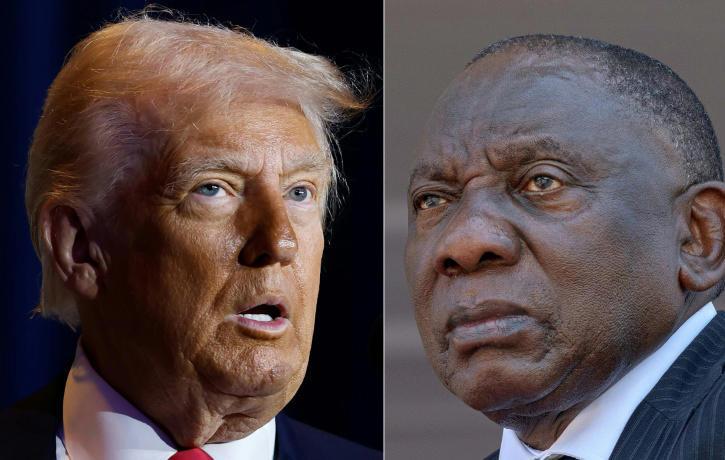
Eskom’s rolling blackouts remain unresolved; and unemployment, especially youth unemployment, has reached catastrophic levels.
Worse, the ANC itself is in decline. In the 2024 general election, for the first time since 1994, the party lost its outright majority, winning just over 40 per cent. Ramaphosa was forced into a fragile coalition with the Democratic Alliance and smaller parties. This arrangement constrains his manoeuvrability: every major decision must now balance competing interests, limiting bold action.
Launching a national dialogue allows Ramaphosa to project leadership at a moment when his power is contested. It creates the illusion of momentum, even if concrete policy shifts remain elusive. Critics argue it is a distraction tactic, a way to shift public attention from daily crises to a grand narrative of healing.
Why has South Africa reached this stage? For a start, it goes beyond the current administration. The roots lie in both the failures of the ANC and the structural burdens of South Africa’s socio-economic system.
For decades, the ANC enjoyed neartotal dominance, built on its liberation credentials. But over time, power bred complacency and corruption. The Zuma years (2009–2018) institutionalised “state capture,” with billions siphoned off through corrupt contracts. Infrastructure decayed, public trust evaporated, and the party lost its moral authority.
Ramaphosa inherited a hollowed-out state. His inability – or unwillingness – to prosecute high-level offenders has
reinforced public cynicism. For many, the ANC is no longer the vehicle of liberation but of misrule.
At the same time, South Africa’s economic system is uniquely burdened by history. Under apartheid, the economy was designed to serve a privileged minority white population. By 1994, South Africa had a modern industrial sector, but one overwhelmingly skewed towards the needs of a small elite.

Post-apartheid governments faced the near-impossible task of redistributing opportunity to a majority long excluded from land ownership, education and capital access – without scaring away investors or destabilising growth. Two decades later, land reform has stalled, the education system remains unequal, and unemployment is entrenched.
The failure is dual: an ANC weakened by internal rot and an economic system whose structural inequalities are too deep for incremental reform alone.
The apartheid South African economy, by the late 1980s, was under sanctions, facing capital flight and suffering from sluggish growth. The economy was unsustainable precisely because it excluded the majority.
Yet there are contrasts worth noting. In terms of growth rate, in the early 1990s South Africa averaged modest growth despite sanctions. Post-1994, the country experienced a “boom” in the 2000s, peaking around five per cent growth under Thabo Mbeki. Today, growth hovers below one per cent, barely keeping pace with population increases.
Employment has always been a problem. Under apartheid, official unemployment rates were artificially low, but only because black South Africans were systematically excluded from formal statistics and forced into subsistence or informal labour. Today, with universal measurement, unemployment sits at over 33 per cent, with youth unemployment above 50 per cent.
South Africa remains the most unequal country in the world. While a black middle class has emerged, wealth distribution is still overwhelmingly skewed. Land ownership remains concentrated in white hands, and many townships look much as they did in 1994.
Members of the black middle class have diverted attention from themselves
by pointing their fingers at the millions of African refuges and migrants in South Africa. It is not surprising that the country is witnessing high incidences of xenophobic violence (see following article).
In this toxic mix, the post-apartheid government must manage an economy for all, not just a minority. That is an ethical imperative, but it comes with immense structural pressures.
Some argue that the task was always impossible: no government could take a deeply unequal society, integrate millions into the formal economy and achieve prosperity in one generation. Others counter that the ANC squandered its best opportunities.
In the early 2000s, when growth was
is less about whether South Africa’s burdens are “too much” and more about whether its leadership has been equal to the task.
So, what can the National Dialogue achieve? South Africans remain remarkably committed to democracy, even as institutions falter. A genuine process of listening could rebuild trust, provide consensus on difficult issues like land and generate a new social contract.
’
At worst, it risks becoming a costly diversion. Without binding outcomes, the dialogue could end in a glossy report gathering dust while the state continues to fail at basic delivery. The very act of spending nearly R700 million on a symbolic process could deepen resentment in a country where millions live in poverty.
The National Dialogue is both an attempt to rescue Ramaphosa’s presidency and to revive South Africa’s tarnished reputation. Yet the deeper truth is that South Africa’s predicament cannot be solved by dialogue alone.
The ANC’s failures, combined with the structural inequities inherited from apartheid, have brought the country to the brink. South Africa is not ungovernable, but it is trapped in a cycle where bold reforms are endlessly deferred. Dialogue can provide cover, but not solutions.
strong and state coffers healthy, bold reforms could have accelerated land redistribution, improved education and reduced reliance on extractive industries. Instead, resources were mismanaged or stolen. Shades of many African countries after independence,
Thus, while the challenge is undeniably vast, it is not insurmountable. The issue
For Ramaphosa, the stakes are personal. His legacy will depend on whether this initiative produces more than symbolism. For South Africa, the stakes are existential: whether a nation once celebrated for its miracle transition can find renewal before despair hardens into permanent decline.

Violence, unequal access to opportunities, health care and education, as well as migrant and refugee policies targeted at foreigners are having a negative impact on South Africa’s post-apartheid vision of an inclusive, non-racial democracy, while also tarnishing its international image, writes Stephen Ndoma
SOUTH Africa is an economic giant of Southern Africa and stands out as a preferred top destination for migrants from within and beyond the region. In 2023, South Africa had an estimated total of 2 ,60,495 officially recognised immigrants.
Due to its socio-economic and political status, South Africa attracts foreign migrants for economic, safety and security reasons. It is also home to many refugees and asylum seekers from various African countries.
The UN High Commission for Refugees (UNCHR) reports that there were over 250,000 refugees and asylum seekers in South Africa, although the figures may be inaccurate due to the presence of many undocumented refugees. These refugees and asylum seekers are driven away from their countries of origin due to poverty, political violence and war. These countries include Burundi, the Democratic Republic of Congo, Rwanda, South Sudan, Somalia and Zimbabwe.
Some of the benefits that accrue to destination countries due to migration include the filling of labour gaps, while countries of origin can also benefit from remittances. However, destination countries normally face unbearable pressure due to the influx of foreign migrants, and South Africa has not been spared from this. The country faces several challenges due to a burgeoning number of immigrants, including those seeking political refuge.
A parliamentary monitoring group highlighted some of these challenges, including xenophobic violence, unequal access to opportunities, health care, and education, as well as migrant and refugee policies. To buttress this, three foreign nationals were killed in the Eastern Cape province in May of this year following violent revenge attacks, while hundreds of women and children were driven from their homes.
With a long and bloody history, xenophobia in post-apartheid South Africa often leaves a trail of destruction. Xenophobic attacks in May 2008 saw about 62 people killed and thousands displaced. Similar clashes between South Africans and foreigners in 2015, mainly in Durban and Johannesburg, forced several foreign immigrants to close their business operations and request voluntary repatriation to their home countries.
Reports of foreign migrants being denied healthcare services also abound. These attacks partly stem from local perceptions that foreign immigrants place pressure on already strained resources. Groups like Operation Dudula have made calls for prioritising South Africans and
have blamed migrant workers for rampant crime and for contributing to the country’s high unemployment rate by taking jobs away from locals.
These episodes have a negative impact on South Africa’s post-apartheid vision of an inclusive, non-racial democracy, while also tarnishing its international image. To compound matters, discrimination, particularly against African immigrants, casts a dark shadow on the country, strains diplomatic relations, and threatens regional cooperation and economic integration initiatives.
Speaking at a recent summit of liberation movements in Southern Africa, President Cyril Ramaphosa called for a rejection of xenophobia, and emphasised
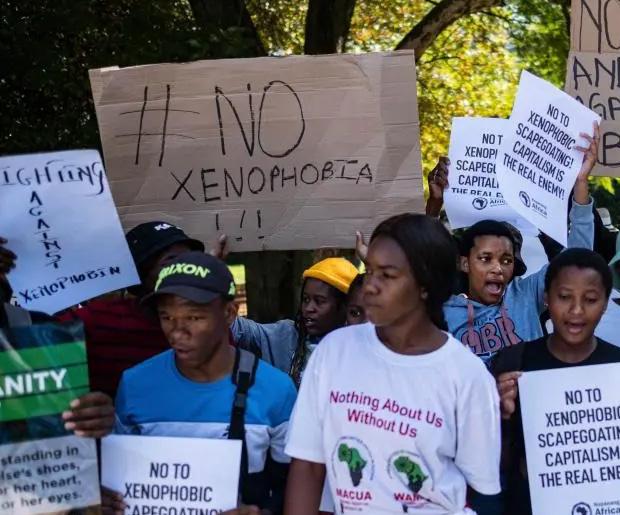

that migration is “a consequence of underdevelopment, war and global inequality, and not a moral failing of those who migrate in search of hope”. He also urged liberation movements to advocate for “people-centred regional migration policies that affirm dignity, rights, and solidarity as well”.
While citizens who engage in xenophobia may have their reasons, how tolerant is South African society towards immigrants and foreign workers? Public opinion data can help unpack this puzzle. To better understand the scope and implications of this issue, Afrobarometer survey data is used to gain valuable insights into public perceptions on tolerance and their potential impact on xenophobic tendencies.
This was gauged through questions measuring citizens’ attitudes towards immigrants or foreign workers and their acceptance of refugees and asylum seekers.
Survey data shows that the South African society is generally tolerant to immigrants or foreign workers, a view shared by 58 per cent who said they do not care or at least like having them as neighbours, while 39 per cent disliked it. On the downside, above half (53 per cent)
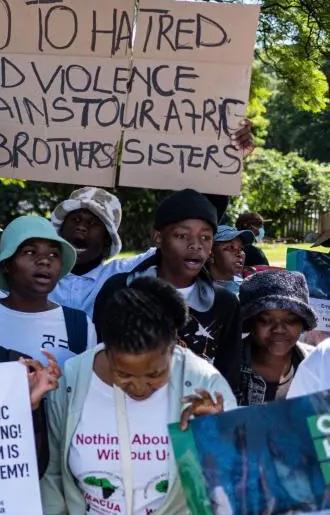
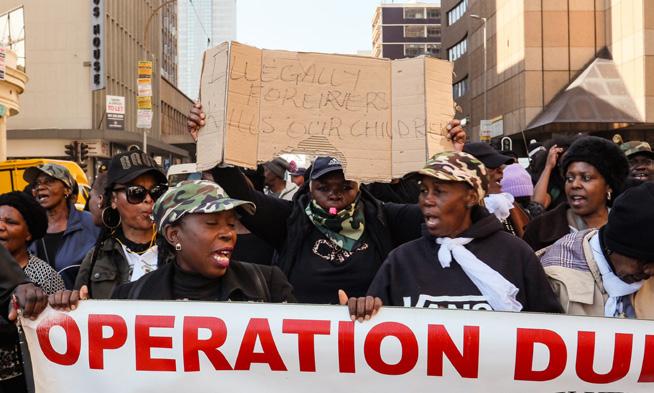
expressed opposition to a scenario where asylum seekers are accepted and protected in South Africa, while 24 per cent endorsed such a scenario.
and
are scarce and feel that the government is underperforming in that respect. The South African government is therefore urged to handle the matter in a delicately, with the aim for a win-win outcome that benefits both locals and foreign immigrants in order to ensure stability and social cohesion.
The following measures could be key in the fight against xenophobic tendencies:
• Promoting cultural exchange and education through organising cultural events, workshops and programmes that showcase diverse cultures and traditions.
• Supporting inclusive language and media representation – this can be achieved through advocating for
About seven out of 10 adult citizens (71 per cent) agreed that employers should prioritise locals when job opportunities are scarce, while 62 per cent had negative assessments about government’s performance in terms of ensuring that this is respected.
These findings provide evidence that South African society can be susceptible to xenophobia given what the data shows about citizens attitude towards immigrants and foreign workers, and the reluctance to accept asylum seekers. Calls for locals to be considered first when job opportunities are scarce and perceptions that government is not doing enough in terms of giving preference to those born and bred in South Africa are also likely to fuel xenophobic attitudes.
South Africa is undoubtedly an economic hub that will continue to attract migrants from beyond its borders, as people flock to the country in search of opportunities to improve their socioeconomic well-being. This will continue to place pressure on the resources that are already under strain. Citizens have made their voice heard: while there is general tolerance towards immigrants or foreigners, there is low acceptance of the protection of asylum seekers.
Many believe that employers should prioritise locals first when job opportunities
inclusive language and representation in the media, highlighting the contributions and experiences of diverse communities.
• Fostering community engagement by encouraging community-led initiatives that bring people together, with the ultimate goal of promoting social cohesion and building trust between diverse groups.
• Provision of social support services for migrants and refugees to help them integrate into their new communities.
• Supporting research and data collection on xenophobia in order to inform evidence-based policies and interventions.
• Review of immigration and refugee policies to ensure they are fair, humane and aligned with international human rights standards.
• Prosecuting politicians and influencers who incite xenophobia and alleviation of root causes of xenophobia, e.g. inequality.
• Stepping up diplomatic roles within the region through helping to resolve problems in neighbouring countries, which often compel foreign nationals to flock to South Africa and exert pressure on resources.
Throughout Southern Africa, from South Africa to Mozambique and beyond, the press faces a barrage of threats that make statutory protections seem little more than paper promises, write Tambudzai Gonese and Melusi Simelane
AS outlined in international human rights treaties and most African constitutions, freedom of expression is a fundamental right. Article 19 of the International Covenant on Civil and Political Rights and the Universal Declaration on Human Rights affirm that every individual has the right to hold opinions and to impart and receive ideas.
This Article has served as the basis for recognising this right in the constitutions of most African states. This freedom is essential in a democratic society because it allows people to participate civically and promotes accountability.
The foundation of this is what is known as a ‘free press’. Freedom of expression provides the necessary basis for the media to deliver important information that helps citizens stay informed about and engage in governance, which is vital for accountability.
The Zimbabwean Constitution, for example, explicitly recognises the freedom of expression for the media, even stating that everyone has the right to media freedom, including protections for journalist sources.
The Zimbabwe Constitutional Court, in Chimakure v Attorney General, affirmed that freedom of expression is sacrosanct, regardless of whether the information conveyed is false or offensive, provided it does not incite violence or spread hate speech.
Although the right is not absolute, any restrictions must be proportionate and reasonably justified within a democratic society. When criminal law is employed to silence the media, it is concerning, especially when charges are based purely on exercising freedom of expression rather than on accusations of inciting violence or hate speech.
Sedition offences and insult laws are such statutes that have no place in a democratic society, particularly when they seek to suppress political speech or critical views about the state. Zimbabwe has a troubled history of using criminal law to silence dissenting voices. With the adoption of a new Constitution in 2013, it was hoped that this practice would cease.
However, recent events such as the arrests of journalists for broadcasting interviews with critical voices or publishing satirical articles that critique the state have cast doubt on that. This is possible because laws that undermine freedom of expression, like criminal insult laws, still exist.
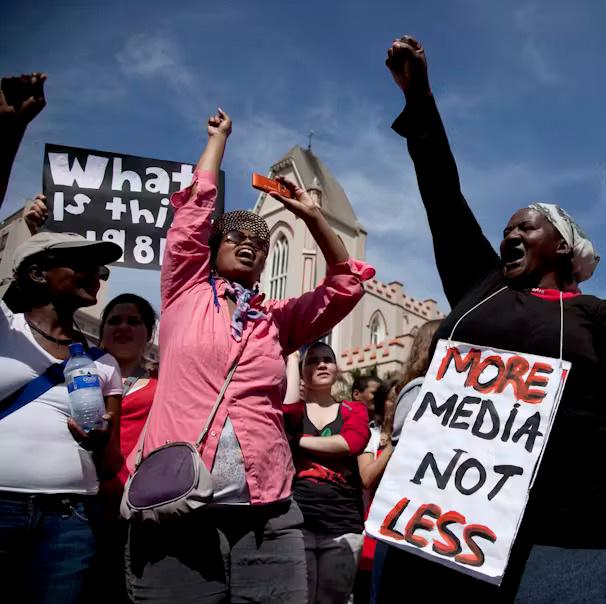
Yet, Zimbabwe is not alone in this struggle. Throughout Southern Africa, from South Africa to Mozambique and beyond, the press faces a barrage of threats that make constitutional protections seem little more than paper promises.
Despite these enshrined values, freedom of expression remains an illusion for the media, undermined by restrictive laws, physical attacks and systemic intimidation that hinder accountability and democratic debate.
In South Africa, once seen as a beacon of media freedom on the continent, concerns are mounting about the decline of press independence due to state actors. Concerns have been voiced about the role of the State Security Agency in undermining journalistic integrity, including harassment and threats against reporters covering corruption or political unrest.
The 2025 World Press Freedom Index by Reporters Without Borders identifies economic instability as the primary threat.
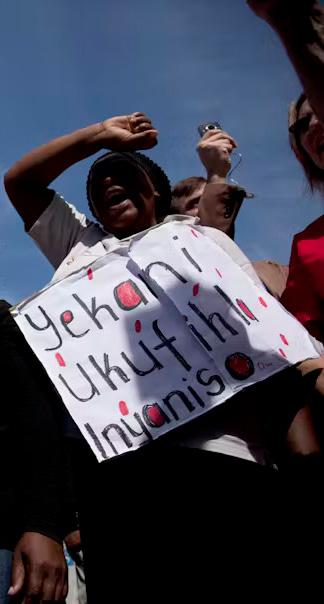
Nonetheless, in South Africa, this is worsened by verbal attacks from political leaders and activists, which weaken the media's capacity to scrutinise those in power.
Recent incidents, such as the targeting of SABC's head of news following leaks critical of the ANC, exemplify how state mechanisms are being utilised against dissenting voices.
In Mozambique, press freedom violations nearly tripled during the 2023 municipal elections, increasing from 11 cases in 2022 to 28 the following year, according to the Media Institute of Southern Africa (MISA). Journalists such as Bongani Siziba and Sbonelo Mkhasibe
Centre (SALC), led in challenging these injustices.
In a historic victory on July 16, 2025, the Malawi High Court declared criminal defamation unconstitutional, a ruling SALC supported and celebrated for its potential to dismantle laws that create a chilling effect on public debate and media freedom. This decision not only strengthens protections for journalists in Malawi but also serves as a model for the region, demonstrating how strategic litigation can reclaim rights eroded by authoritarian tendencies.
As member states of the Southern African Development Community (SDAC) like Zimbabwe, South Africa and Mozambique continue to violate
were detained while reporting on events, highlighting a pattern of arbitrary arrests that suppresses coverage of electoral irregularities and corruption.
Similarly, in Botswana, reporters faced assaults while covering ruling party primaries, raising safety concerns in a tense political climate. Generally, we have seen a bleak picture across East and Southern Africa, documenting widespread intimidation, harassment and detention of journalists, with authorities escalating attacks to stifle the flow of information.
These violations are not isolated; they form a regional crisis where governments exploit outdated laws and extra-legal measures to suppress criticism. The 2025 State of Press Freedom in Southern Africa report by MISA states that physical attacks on journalists have decreased slightly.
However, the environment remains “problematic” due to restrictive legislation, harsh working conditions and increased risks during elections or corruption investigations. Online threats, including AI-enhanced harassment of women journalists, further deepen the chill on free expression.
Amid this gloom, there are glimpses of hope through civil society initiatives. Our organisation, the Southern Africa Litigation
democratic norms through attacks on freedom of expression, the SADC must focus on stronger accountability mechanisms.
SALC and other civil society actors have highlighted the urgency of defending democratic values, especially the fourth estate’s role in ensuring transparency and justice. Without regional enforcement, such as binding protocols on media protections and sanctions for violators, the false impression of press freedom will endure, enabling corruption and abuse to flourish unchecked.
Southern African countries’ constitutions may declare lofty ideals, but the reality for journalists is danger and censorship. The SADC must rise above rhetoric, demanding tangible reforms to decriminalise defamation, protect reporters from state harassment and foster an environment where the press can genuinely hold power to account.
Civil society, led by organisations like SALC, shows the way forward. Still, it requires collective political will to turn freedom of expression into a realisable goal rather than a distant hope. The moment for stronger regional accountability is now before the voices of truth are silenced forever. AB
A landmark report warns that punitive laws across the Commonwealth are suffocating press freedom and free expression. With over 200 journalists killed in member states in the past two decades, reform is urgent – but will governments act on their own promises?
THE Commonwealth likes to style itself as a community of nations bound by a shared commitment to democracy, human rights and the rule of law. Yet a damning new report released this September suggests that, when it comes to free expression, the organisation’s rhetoric has long outstripped reality.
The report, Who Controls the Narrative? Legal Restrictions on Freedom of Expression in the Commonwealth, published by the Commonwealth Human Rights Initiative (CHRI), the Commonwealth Journalists Association (CJA) and the Commonwealth Lawyers Association (CLA), paints a sobering picture: restrictive national laws in dozens of member countries are being used to muzzle dissent, intimidate journalists and criminalise legitimate public debate.
Of the Commonwealth’s 56 members, 41 retain criminal defamation statutes, 48 enforce sedition provisions and 37 still apply blasphemy-like legislation. Most of these laws are relics of colonial legal systems.
Yet instead of being consigned to history, they have been repurposed by modern governments to stifle scrutiny. “Too many Commonwealth countries continue to enforce colonial-era laws that criminalise speech and silence dissent, in clear violation of their international obligations,” said Sneh Aurora, Director of the CHRI.
This is not merely a matter of restrictive texts on the statute books. These laws are actively wielded against journalists, human rights defenders and political critics. Their very existence fuels a climate of fear and self-censorship,
particularly in states where judicial independence is fragile.
Legal restrictions are compounded by violence. According to UNESCO figures cited in the report, 213 journalists were killed in 19 Commonwealth countries between 2006 and 2023. In a staggering 96 per cent of cases, the killers have never been brought to justice.
For William Horsley of the CJA, this impunity is both scandalous and corrosive. “The almost complete failure of Commonwealth countries to prosecute and punish those responsible for the killings of over 200 journalists in 20 years is shameful. This culture of impunity must be swept away,” he said.
The danger is clear: when journalists are murdered with impunity, entire societies are deprived of the information they need to hold power to account.
There is, however, a glimmer of hope. At their 2024 summit in Samoa, Commonwealth leaders adopted the Commonwealth Principles on Freedom of Expression and the Role of the Media in Good Governance – an 11-point framework that recognises the centrality of free media to democracy.
This was the product of an eight-year campaign by grassroots organisations and advocacy groups. But while its adoption was hailed as a breakthrough, the real test lies in implementation.
The new report makes clear that unless governments move swiftly to repeal or amend punitive laws, the Samoa Principles risk becoming yet another unfulfilled declaration.
The CHRI, CJA, and CLA are urging the Commonwealth Secretariat and member states to:
• Develop concrete action plans to scrap criminal defamation, sedition, and other “speech crimes.”
• Strengthen protection for journalists and civil society watchdogs.
• Reform the Commonwealth Ministerial Action Group (CMAG) and appoint a dedicated Envoy on Freedom of Expression.
• Work with civil society and UNESCO to monitor implementation of the Samoa Principles.
The stakes are high. As misinformation spreads globally and authoritarian tendencies gain ground, the ability of journalists and citizens to speak truth to power is more essential than ever.
The Commonwealth is often dismissed as a talk shop, more comfortable with symbolism than substance. But advocates argue that the Samoa Principles and the new report provide a genuine opportunity for reinvention.
If the organisation can help its members dismantle laws that criminalise dissent and protect those who risk their lives to inform the public, it might yet give meaning to its lofty ideals. Failing that, the gap between its stated values and lived realities will only grow wider.
As Horsley warned, “A genuine Commonwealth engagement to protect the truth-tellers from threats and reprisals would give the organisation a vital new sense of purpose at a time when the concept of truth is under fierce attack.”
The question now is whether Commonwealth leaders will seize the moment – or allow colonial ghosts to continue dictating the terms of free expression in the 21st century.

Press freedom in the Commonwealth: Africa highlights
• ACROSS Commonwealth Africa, constitutional guarantees of freedom of expression are frequently undermined by broad legal exceptions relating to national security, public order, and morality – routinely enforced through defamation, sedition, and cybercrime laws, as well as intrusive regulatory regimes, to suppress dissent and stifle debate.
• Journalists in Cameroon, Nigeria, Rwanda, Sierra Leone and Uganda face intimidation and violence for exposing corruption and abuse of power. Judicial failures to hold perpetrators accountable perpetuate a climate of impunity.
• Ghana, Lesotho, Seychelles, Sierra Leone and South Africa have decriminalised defamation, while courts in Malawi, The Gambia and Kenya have ruled it unconstitutional. Yet 14 of 21 Commonwealth African states still retain criminal defamation laws, enabling authorities to silence critics.
• Blasphemy laws remain in force in 14 of 21 countries, targeting dissenting religious views and restricting
freedom of belief. In some Nigerian states governed by Sharia law, blasphemy offences may carry the death penalty.
• Sedition laws remain in force in Botswana, Cameroon and Nigeria, though reforms have been undertaken in Malawi, Sierra Leone, and Uganda.
• National security laws are widely used by authorities across Commonwealth Africa to suppress dissent. In Cameroon, Rwanda and Uganda, enforcement is particularly harsh, often targeting journalists and activists. Similar patterns exist in The Gambia, Togo and the Kingdom of eSwatini, where such laws are leveraged to maintain political control, especially during elections and protests. Although less frequent, in Botswana, South Africa and Ghana these laws are still used to silence critical voices.
• Cybercrime and cybersecurity legislation are increasingly used to police online speech. High-profile cases such as Stella Nyanzi in Uganda and Agba Jalingo in Nigeria show how vague provisions are weaponised to penalise dissent in digital spaces.
• Media independence remains under pressure. In Cameroon, Gabon, Rwanda, Seychelles and Uganda, state control of media outlets fuels self-censorship. Journalists in Botswana, Malawi and Mauritius enjoy greater press freedom, but they still face harassment covering sensitive issues. Ghana and South Africa have relatively more open media spaces, yet both struggle with political interference and concentrated media ownership. SLAPPs [Strategic Lawsuit Against |Public Participation] have risen in South Africa, while violence against journalists has increased in Ghana.
• Access to Information (ATI) laws are in place in 15 of 21 countries, but weak implementation – particularly in Botswana, Cameroon and the Kingdom of eSwatini – undermines transparency and limits public engagement. Even where laws exist, enforcement is hindered by bureaucracy and broad national security exemptions.
• Botswana, Ghana and Sierra Leone are members of the Global Media Freedom Coalition, committing to promote media freedoms and support initiatives such as the UN Plan of Action on the Safety of Journalists.
Source: Who Controls the Narrative? Legal Restrictions on Freedom of Expression in the Commonwealth
Evidence suggests that foreign direct investments move more to countries that have political stability, stable democracies, transparency and low levels of corruption, says Akinwumi
Adesina
THE Global Rule of Law Index from 1996-2023 shows that the topmost six countries are Finland, Denmark, Norway, Switzerland, Austria and Luxembourg.
African countries ranked very low on the global rule of law index, starting in the 60th position with Seychelles, Botswana (70th), Rwanda (80th), South Africa (85th), Ghana (97th) and Morocco (111th), while Nigeria ranked in the 151st position.
Africa must do better on the rule of law index.
That is because the rule of law, which also includes the sanctity of contracts, is an important factor in attracting investments to countries.
So important is the rule of law in attracting foreign direct investment that the American Bar Association has in place a rule of law initiative to “promote justice, human dignity and economic opportunity through the rule of law”, which it considers a “necessary condition for robust economic development”.
To fill financing gaps, nations turn to foreign direct investment. Africa faces an annual foreign direct investment financing gap of over $100 billion.
Evidence suggests that foreign direct investments move more to countries that have political stability, stable democracies, transparency and low levels of corruption.
Other important drivers include independent and transparent judiciary, strong regulatory frameworks, public accountability, efficient public service, competition policy, as well as respect for intellectual property rights.
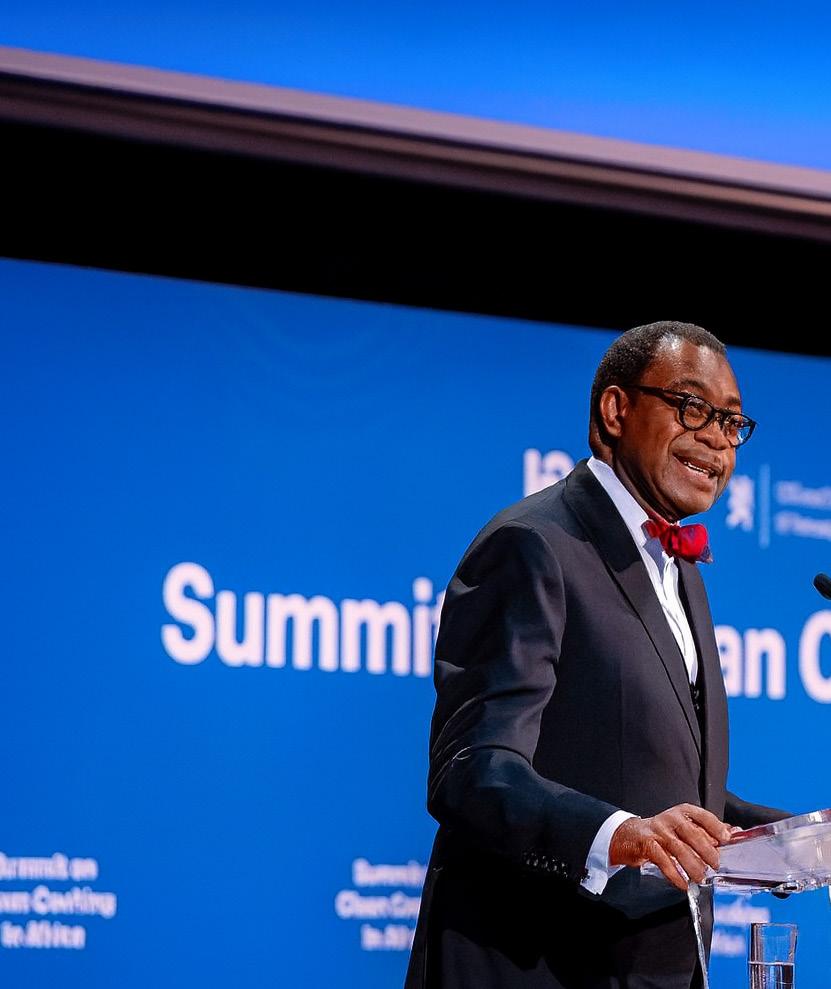
These factors are especially important for Africa, where many countries rely on revenues from natural resources to finance their economies. However, this richness in natural resources has not always translated into economic prosperity.
At the heart of the dissonance is the issue of governance and rule of law over natural resources. Africa’s natural resource-rich countries should learn from successful experiences of countries that have turned their natural resource wealth into prosperity for their populations.
Norway, which relies largely on oil and gas, has in place strong and transparent natural resource laws that guide concessions, acquisition and exploration of natural resources, while protecting biodiversity and securing the prosperity of future generations.
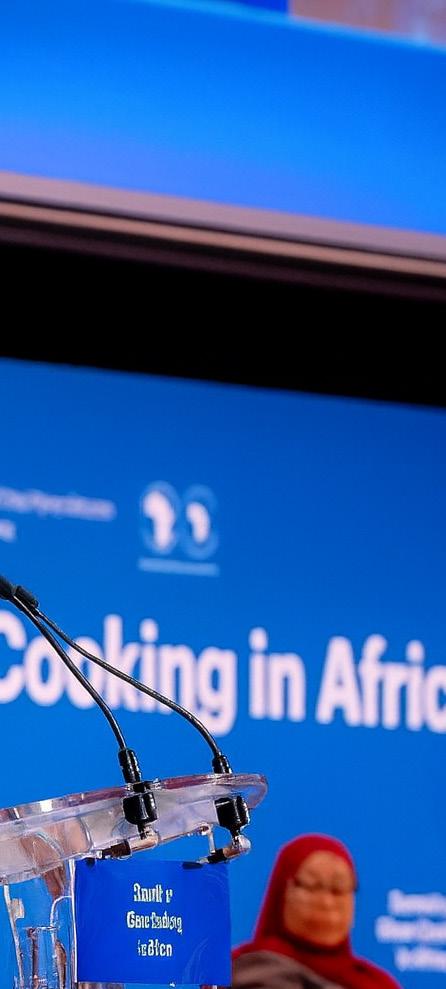
Through such laws and regulations, Norway has been able to establish the largest sovereign wealth fund in the world, worth about $1.9 trillion from revenues from its oil and gas for the benefit of generations. Norway is a AAA-credit rated country.
Saudi Arabia, which relies on oil and gas for its economy today, has its national oil company, Aramco, with a market capitalisation of over $1.6 trillion.
What lessons can African countries learn from this? First, there is nothing really called ‘natural resource curse’; how could what makes some nations rich end up making some poor? The difference lies on governance, transparency and public accountability over natural resources.
Second, natural resources of countries should be targeted for the benefit of the people; avoiding rent-seeking, rentgrabbing, and elite-driven state capture or corruption.
Third, communities should be involved in the management of natural resources; and strong efforts should be made to ensure that multinational corporations are held accountable for environmental externalities based on the polluter pays principle.
Fourth, the judiciary should play a greater role in development of natural resource laws that ensure good governance over the nation’s natural resources. The judiciary should also play a greater role in ensuring compliance with these laws.
Fifth, nations should have a longerterm perspective on their natural resources.
I would also like to propose that the judiciary should get involved on the issue of rising public debt for developing countries, especially in Africa. Today, Africa’s public debt has exceeded $1.3 trillion. The structure of debt has changed over time, as traditional concessional debt from multilateral and bilateral creditors are declining and being overtaken by reliance on Eurobond debt to commercial creditors.
The change in the structure of Africa’s debt which has led to a greater reliance on commercial creditors has raised a lot of challenging legal issues for many African countries.
While restructuring of debt of nations, official and commercial creditors are required to agree on comparative debt treatment to bring debt to manageable levels. However, the framework has always been undermined by uncooperative private creditors. By refusing to sign on to the debt restructuring frameworks, the holdouts devise legal plots to rip countries off.
‘Vulture funds’, backed by hedge funds, buy off the debt of countries on secondary markets at a discount. Then taking advantage of the lack of a legally binding framework or global institution for dealing with bankruptcy of nations, they turn around to sue debtor nations for full payment of the discounted debt, including backdated interest payments and legal fees.
Africa has not been spared. The vulture funds take advantage of legal jurisdictions in creditor countries where they always secure favourable judgements.
‘ ’
Earnings from natural resources should be invested in building human capital, social development and infrastructure, which will ensure the sustainable development of their economies.
Nations should guard against wasting windfall revenues from natural resources by simply ramping up public expenditure. Rather, they should establish and grow their sovereign wealth funds and pension funds. These funds are important to secure the prosperity of future generations.
What lessons can African learn and what roles can the African legal profession play? First, the practice where debt agreements are signed and subject to law in jurisdictions that have been known to always favour the creditors not the debtor nations should be reviewed to ensure fair hearings, equity and justice before the law.
Investors choice of foreign jurisdictions suggests preferences for legal systems they know and trust, and their belief that there is rule of law, judicial
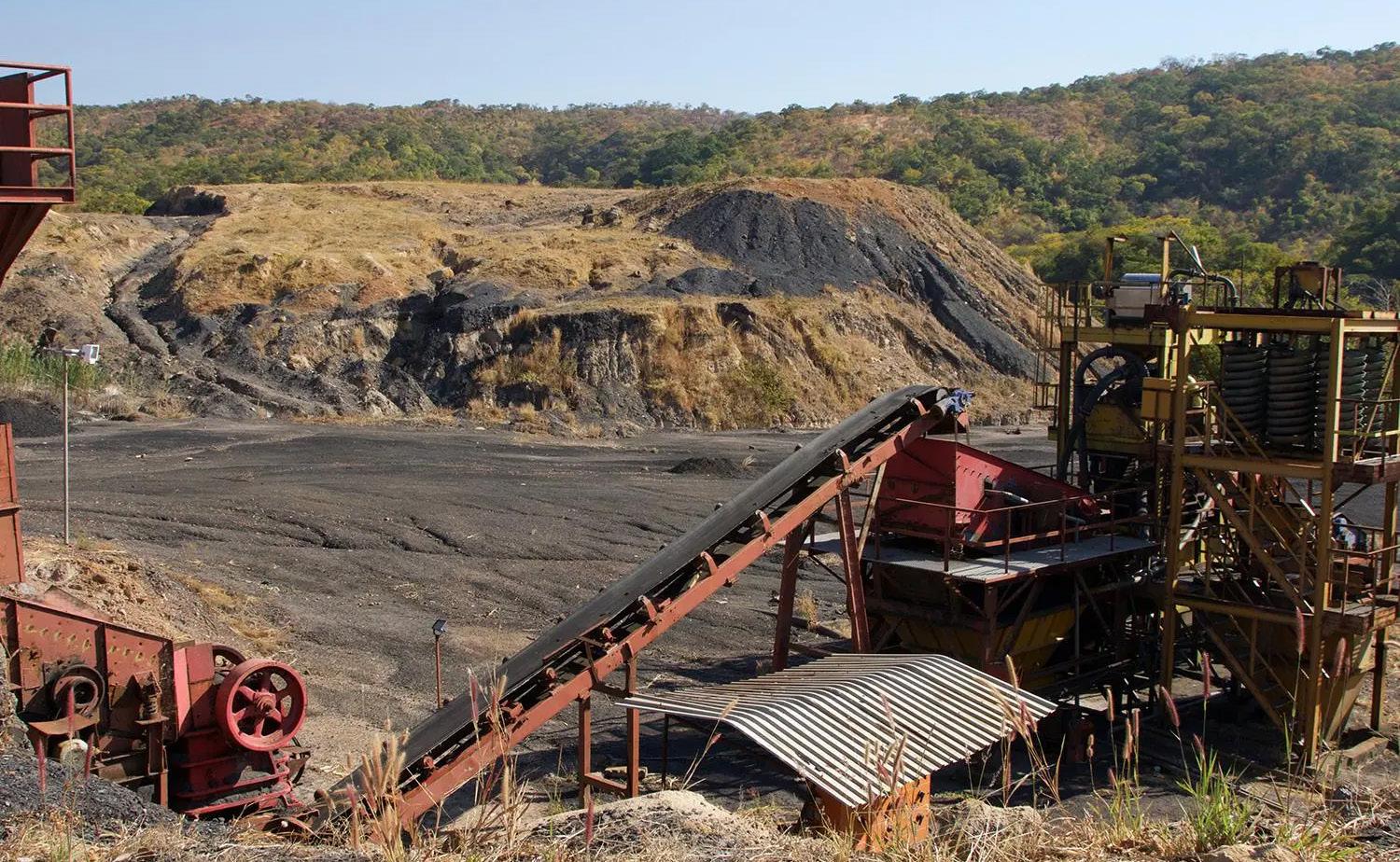
independence and transparency in their nations.
By implication it suggests that they do not trust the judicial systems in African countries. They should rise to this challenge. They must assure judicial independence that engenders trust and confidence of foreign investors in dealing transparently, justly and fairly with disputes – essentially, assure the rule of law.
This will be further enhanced through greater ethical standards and reduction of perceived corruption in the judiciary. There is no substitute for a very transparent, capable, fair, just and independent judiciary to curtail currently existing moral hazards in the global debt arbitration systems.
Second, African countries should also prioritise legal arbitrations in their jurisdictions. Equally important is building and strengthening of the capacity of African arbitral institutions.
The establishment of the African Arbitration Academy, to train young arbitrators, is a good development. Such efforts should also deepen and strengthen partnerships at the national and regional level arbitral institutions, while aligning with international arbitral institutions and treaty agreements.
Third, investors should use Africabased arbitration systems for loans and agreements signed with African
governments and corporate entities. This will avoid the inherent biases, cultural differences and loopholes often existent in legal systems of the creditor countries, as well as lack of sensitivities to local contexts of nations.
Fourth, the judiciary should get more involved in the development of their countries and move beyond the text-based interpretations of law and the constitution, as important as those are.
When, for example, vulture funds take advantage of legal loopholes in
debt, where they can be easily bought at discounts on the secondary debt market and used for subterraneous financial motives.
Many African countries lack the capacity to properly negotiate public contracts. Yet, these contracts will shape the future of economies.
That is why the African Development Bank established the Africa Legal Support Facility, to support African governments to protect their sovereignty, negotiate fairer deals and defend their constitutional and
international debt resolution frameworks, threaten the asset of countries through enforcement of liens on national assets; the judiciary should get involved in safeguarding their countries’ national interest and assets.
Fifth, to prevent the pernicious effects of vulture funds on debtor countries, global debt resolution systems should have enforcement systems that prevent free transferability or assignment of sovereign
economic rights.
Since its inception, the African Legal Support Facility has supported over 50 African countries in negotiating and renegotiating commercial, extractive, infrastructure and sovereign debt contracts.
Through its work, the Africa Legal Support Facility has helped to avert more than $ 4 billion in potential public losses; resources that have been redirected toward national development.
As a public institution, the African Development Bank holds itself to the highest standards of transparency, public probity and accountability.
At the core of this is ensuring that Bank-financed projects do not cause irreparable damages to communities, are inclusive, while providing voice and ensuring compensation for those affected by the projects.
For the African Development Bank Group, strengthening public finance is inseparable from enforcing constitutional safeguards and legal accountability. The Bank has helped countries to improve their systems on governance and the rule of law.
Collectively, these interventions underscore a simple but profound truth: public finance cannot thrive in a vacuum. It must be protected by transparent governance, reinforced by judicial efficiency and anchored in constitutional safeguards.
In essence, public finance, when aligned with constitutional principles and the rule of law, becomes not just a means of managing national budgets. It becomes the foundation for economic sovereignty and sustainable development across Africa.
Parliamentary oversight is the democratic backbone of Public Finance.
At the African Development Bank, public finance is not simply about disbursing funds, it is about anchoring every financial decision in democratic legitimacy and national ownership. This is why, for the

effectiveness of any public sector loan, grant, or guarantee, the Bank requires clear evidence of parliamentary oversight and authorisation.
Public finance without parliamentary oversight is undemocratic and nonsustainable. Democratic scrutiny does not delay development; it protects it. Parliamentary approval is not an obstacle. It is a safeguard that ensures every dollar borrowed serves the public good, not private interest.
With constitutionalism and the rule of law firmly established, it is critical that legal systems and the judiciary be strengthened across the continent. A nation’s legal system serves as its
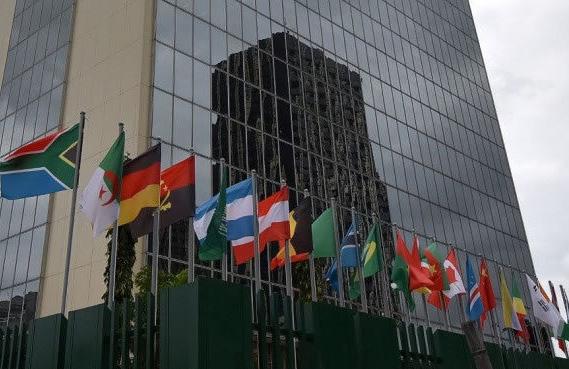
institutional backbone, safeguarding public resources, protecting the rights of citizens and creating the certainty and predictability upon which all economic activity depends.
An independent judiciary, underpinned by constitutional safeguards and protected by the clear separation of powers, ensures that the management of public finances is not left to unchecked discretion, but is bound by clear legal frameworks and subjected to impartial oversight.
Where judicial independence is compromised, courts become vulnerable to political influence, fiscal rules are bypassed, public borrowing escapes scrutiny and public confidence collapses.
One cannot speak meaningfully about constitutionalism, the rule of law and investment in Africa without addressing the foundational issue of access to justice and fair compensation. These are the very conditions that foster public trust and build the confidence investors need to commit capital.
When justice is accessible, and compensation is fair, development becomes inclusive, governance earns legitimacy and economic growth becomes truly sustainable.
And more importantly, laws should be changed to ensure that women have secure property rights. No nation can develop without its women. No bird flies with one wing. It is not just about right. |It is about equity, fairness and justice.
Because we know this truth: justice is not a byproduct of development. It is the foundation of development.
As the world body turns 80 in September, Ibrahim A. Gambari offers strategies for taking the Pact of the Future from paper to practice, using Nigeria as an example
WE gather at a consequential moment: the United Nations has turned 80, and member states have adopted the Pact for the Future with 56 actions and two annexes on the Global Digital Compact and the Declaration on Future Generations. This Pact is ambitious by design; it calls for us to translate multilateral consensus into national progress, especially in the international peace and security sector.
This is taking place at a time when the UN is facing a severe financial crisis, with year-end cash deficits; severe cuts in funding for peacekeeping operations and indeed in resources across the UN system which may shrink by up to 30 per cent compared to 2023. In this regard, UN Secretary General António Guterres had announced on March 12, 2025, UN 80 Initiative aimed at moving “from less with less” to “more with less”.
I want to offer four strategic lenses for taking the Pact from paper to practice in Nigeria – each paired with actionable roles for the UN Country Team (UNCT) and practical examples already moving the needle.
The New Agenda for Peace and the Pact for the Future recentres prevention, politics and people. It calls for anticipatory action, realistic mandates, data-informed decisions and integrated approaches that protect civic space and advance women’s and youth participation. This is not abstract: it’s an operational doctrine for country teams.
The Kaduna State Peace Commission (KSPC) – created by state law in 2017 – offers a homegrown model for institutionalised mediation, early warning and grievance resolution across ethnoreligious and resource tensions. It shows what durable subnational prevention architecture can look like.
The Community Conflict and Dispute Resolution Centre (CCDRC) is an Alternative Dispute Resolution (ADR) relaunched in 2022 by Savannah Centre for Diplomacy, Democracy and Development (SCDDD) in collaboration with Katsina State Government under Governor Aminu Bello Masari. Within just two months of its relaunch and following capacity enhancement training for officials, the CCDRC successfully resolved over 3,000 community disputes out of court.
What can the UNCT do? It can scale state-level peace infrastructures; provide technical support and catalytic funding for state peace commissions, with national standards and peer learning between states.
It can protect and expand civic space; align governance programming with the Pact’s emphasis on rights-respecting prevention; integrate women, peace and security/youth, peace and security
systematically in dialogue platforms and local peace committees.
The UNCT should invest in political diagnostics; use shared political economy analyses to steer UN portfolios toward drivers of conflict: land governance, justice chain bottlenecks, extractives/community relations and climate security hotspots.
The Pact and the New Agenda for Peace emphasise regional prevention and stabilisation. In Nigeria’s northeast, the Lake Chad Basin Regional Stabilisation Facility (RSF) – now in a new 2024–2028 phase – has demonstrated how rapid investments in security, services and livelihoods can create breathing space for governance and social cohesion.
Borno State’s response to mass defections – often referred to as the “Borno Model” – has evolved communitybased reconciliation, reintegration and transitional justice pathways for adults and children associated with non-state
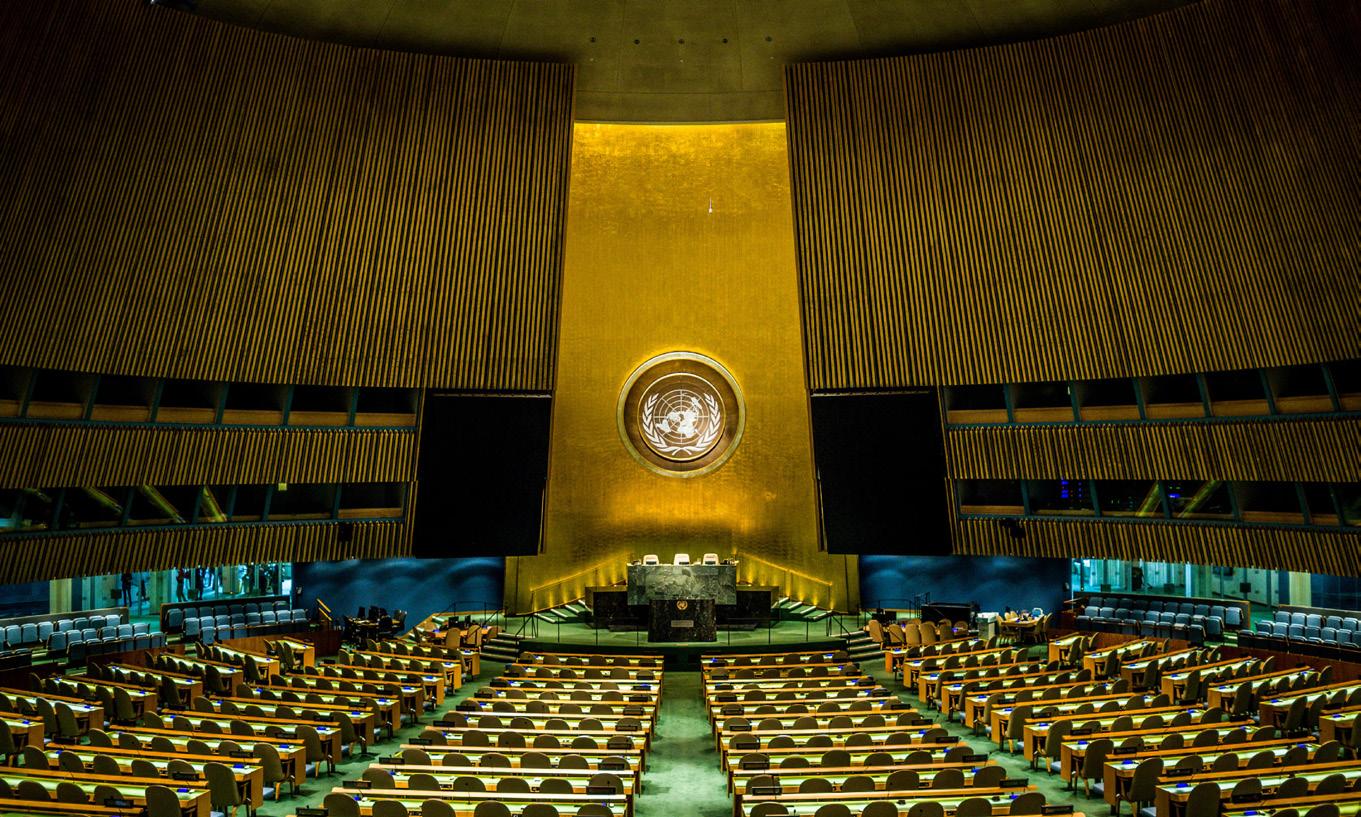
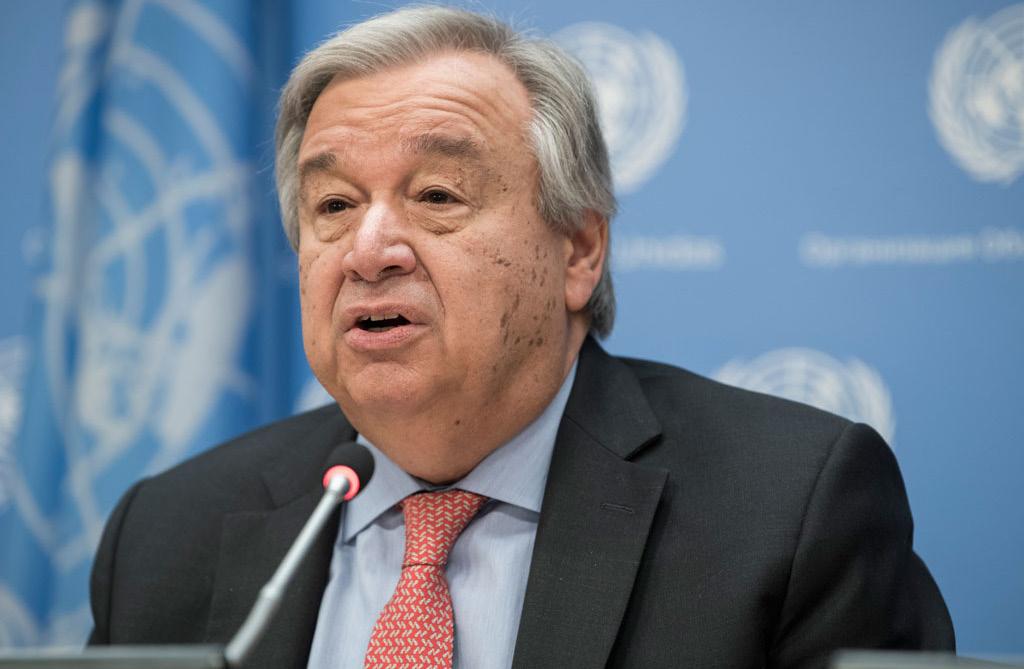
armed groups. These approaches are challenging, but necessary, and they are being documented and refined.
The UNCT can create an Accelerated Stabilisation Stack. This should bundle security-sensitive infrastructure, basic services and livelihoods with community reconciliation and survivor-centred justice, and apply it not only in the northeast, but also in high-risk corridors in the northwest and northcentral zones.
The UNCT should standardise reintegration safeguards; support federal and state partners to adopt codified community-based reintegration standards with independent monitoring.
Stabilisation should be linked to local government performance. For example, SCDDD partnered with the Borno State government to host a fourday capacity-building workshop aimed at raising awareness and improving the implementation skills of the State’s elected 27 Local Government officials and other key stakeholders.
By the end of the workshop, all 27 LGAs led by their Chairmen or Deputies, were able to create a sample strategic development and implementation work plan for a priority project of their choice, using the project development templates that were taught during the training.
Data should be made a frontline asset: from early warning to early action. The Pact’s peace and security track underscores evidence-driven prevention
and smarter use of technology. Nigeria already generates substantial data – from humanitarian assessments to security trendlines to social protection registries. The question is how to fuse and act on it faster.
In Nigeria, the Humanitarian Needs Overview integrates conflict and
‘
mediators or service packages when thresholds are crossed.
The Pact calls for fit-for-purpose financing and a stronger bridge between development, humanitarian and peace efforts. In Nigeria, the returns on prevention financing are visible where small, fast funds unlocked localised stability – then leveraged larger development flows. Financing should be tied to measurable peace dividends.
A practical action agenda for the UNCT in Nigeria is to launch a Nigeria Pact for the Future – Peace Compact. A compact with federal and three pilot states to deliver five measurable peace dividends each; and report quarterly to the UN Resident Coordinator and Governors’ Forums.
In my view, UNSG Guterres’ UN@80 Initiative is not a replacement for the ambitions of the Pact of the Future. It is aimed at the need for and ability of the UN to do more with less financial and other resources, and thereby serve “we the people of the United Nations” better in the three main pillars of the Organisation’s mandate: Peace and Security, Social and Economic Development, and Human Rights and Humanitarian Services.
displacement data for the northeast. The Peace Building Fund (PBF) projects in Borno are building policy frameworks for reconciliation metrics; and the Regional Stabilisation Fund has piloted results tracking across locations. These are building blocks for a national prevention dashboard.
What can the UNCT do now? It should create a joint Risk & Resilience Lab. This is light, interagency cell that blends conflict/event data, climate risk, market signals and social listening into district-level heatmaps; set triggers that automatically move funds and deploy
At 80, the UN’s relevance will be judged not by how eloquently we describe the future, but by how concretely we build it – town by town, budget line by budget line, partnership by partnership. The Pact for the Future has given us a direction of travel and the political authorisation to act. Nigeria has the institutions, talent and lived experience to show that prevention pays, that stabilisation can be people-centred, and that inclusive politics is the surest pathway to peace.
Let us move from commitments to consequences – for the better.
Prof. Ibrahim A. Gambari is a former UN Under-Secretary-General for Political Affairs. He served as Nigeria’s Permanent Representative to the UN from 1990 to 1999. The above is an edited version of his address to the UN Country Team in Abuja in August this year
African leaders used the UN General Assembly’s 80th session to demand sweeping reforms, warning that without a permanent African voice on the Security Council the world body risks irrelevance amid climate shocks, debt crises and persistent conflicts
ON the third day of the United Nations General Assembly’s 80th high-level debate, African leaders delivered a strikingly unified message: the UN must undergo meaningful reform or risk sliding into irrelevance. Their appeal was grounded in a shared frustration with a global order that continues to marginalise developing nations even as it grapples with overlapping crises – from persistent conflicts and climate disasters to crushing debt burdens.
The speakers warned that the UN’s credibility hangs on its ability to adapt to today’s polycrisis. Without reform, they argued, the promise of the UN Charter –to safeguard peace and promote equality among nations – cannot be fulfilled. Across the continent, governments face fragile economies, youth unemployment, and recurring droughts, yet remain excluded from the world’s most powerful decisionmaking bodies.
Adding a powerful new voice to the debate, Ghana’s President John Mahama called for a major overhaul of the United Nations Security Council, insisting that Africa must have a permanent seat and that veto power should no longer rest exclusively with five nations.
Mahama said the council’s post-World War II structure no longer reflects global realities. ‘If the principle of sovereign equality of all members were true, a continent as large as Africa with its numerous UN member states would have at least one permanent seat on the Security Council,’ he declared.
Mahama also questioned the fairness of the council’s veto system, which gives the United States, United Kingdom, France, China and Russia the ability to block any resolution. ‘No single nation should be able to exercise an absolute veto to serve its own
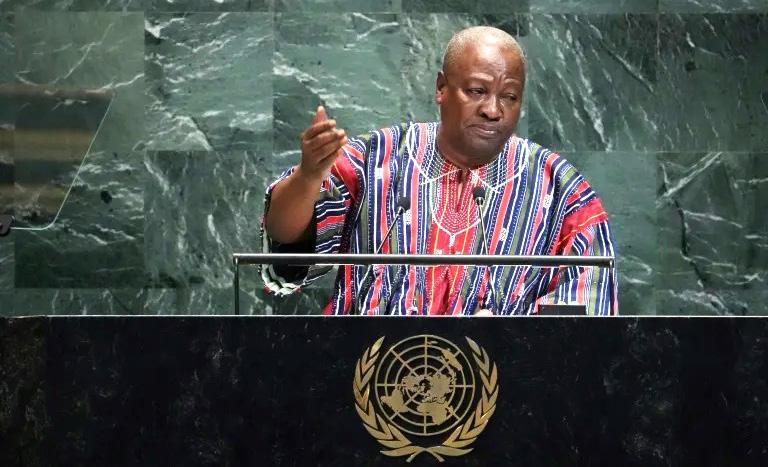
interest in a dispute,’ he said, urging the General Assembly to create a mechanism to challenge or override a veto.
The president noted that Chapter 2, Article 1 of the UN Charter enshrines the principle of sovereign equality. ‘Yet the most powerful post-war nations are still rewarded with near totalitarian guardianship over the rest of the world,’ he argued.
Citing Nelson Mandela’s 1995 call for the UN to ‘redefine its profile and reshape its structures’, Mahama said little has changed three decades later. ‘If not now, then when?’ he asked.
Mahama warned that a world marked by climate crises, conflict and technological upheaval cannot rely on a council designed in 1945. He pointed to current geopolitical tensions and the denial of visas to Palestinian leaders as evidence that multilateralism is under strain.
Analysts say his speech underscores Africa’s growing demographic and
economic weight. By 2050, the continent is expected to account for more than 25 percent of the world’s population and one third of its youth. ‘The future is African,’ Mahama told delegates, framing Security Council reform as essential for global legitimacy.
The Ghanaian leader linked council reform to broader changes in global governance, including a ‘reset of the global financial architecture’ to give Africa a stronger voice in international financial institutions.
‘Africa must have a greater say in the world’s multilateral financial institutions,’ Mahama said, adding that fair representation is key to maintaining the UN’s credibility as the world’s ‘proverbial town square’.
Other African heads of state underscored that today’s global challenges are inseparable from the UN’s structural deficits. They highlighted runaway climate
shocks devastating semi-arid nations, food and energy crises triggered by external conflicts, and the unsustainable debt that throttles growth. Against this backdrop, they warned, the Security Council’s outdated architecture undermines both legitimacy and effectiveness.
Their message was not mere rhetoric. From Guinea-Bissau to South Sudan, leaders gave personal testimony to the consequences of a system in which Africa – home to over one billion people – lacks a permanent seat on the Security Council and remains under-represented in international financial institutions.
President Umaro Sissoco Embaló of Guinea-Bissau reminded delegates that the UN was designed as a forum where all nations, large or small, speak as equals. Yet he cautioned that equality in principle has not meant equality in practice. While agencies such as UNICEF and the World Food Programme provide vital support, he said, their efforts are hampered by a Security Council that excludes much of the Global South.
‘The legitimacy, strength, and future of the UN lie in the inclusion and full participation of all of us in deliberations and decision-making,’ Embaló declared. For him, expanding and democratising the Council is essential to rebuild faith in multilateralism.
Vice President Muhammed Jallow of the Gambia focused on the acute vulnerability of smaller economies to external shocks. Food and energy crises, rising debt and unemployment, he argued, show how international instability lands hardest on the Global South. Jallow urged richer nations to forge partnerships that strengthen food security, infrastructure and Sustainable Development Goal implementation.
He also demanded a more proactive Security Council. ‘We call on the UN Security Council to fulfil its responsibility towards resolving the unrest in Africa and elsewhere,’ he said, insisting that peace and security cannot be selective.
Ethiopia’s President Taye Atskeselassie Amde delivered one of the sharpest critiques of UN inertia. Citing double standards and a lack of impartiality, he warned that military buildups and the retreat from climate and development commitments threaten global peace.
Although Ethiopia has recorded notable development progress, Amde said those gains are constrained by crushing debt and coercive trade measures. ‘There is no shortcut or half-solution to this longstanding pursuit for justice,’ he argued, calling for debt cancellation and full African participation in global governance.
Speaking for the world’s youngest nation, Vice President Josephine Joseph Lagu linked South Sudan’s postconflict fragility to broader international shortcomings. She urged stronger backing for African-led solutions and greater space for countries to consolidate institutions without undue interference.
‘We all know that it is better together. It is better together for us nationally, it is better together for us globally,’ she said, pressing the UN to match words with action in humanitarian support and peacebuilding.
President Duma Gideon Boko of Botswana balanced appreciation for the UN’s founding ideals with a blunt call for change. Pointing to Botswana’s success in using diamond wealth to fund education and health care, he nonetheless warned that resource dependence is perilous and
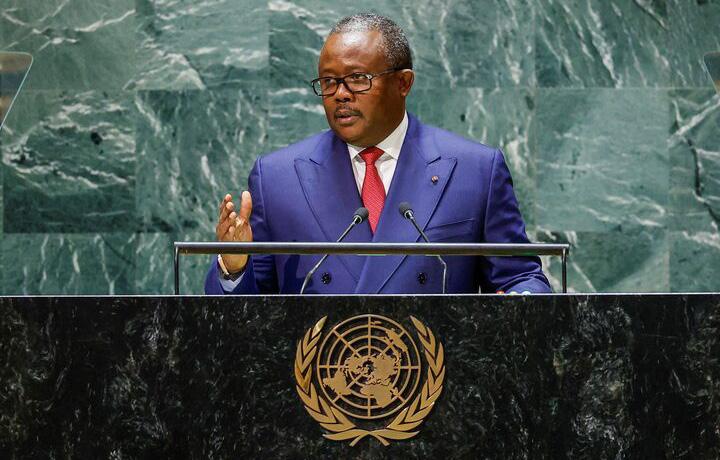
climate change an immediate reality for semi-arid states.
Boko’s strongest demand was for a permanent African seat on the Security Council. ‘Africa’s voice is not heard,’ he said, contending that without genuine African representation the UN cannot claim universality.
The common thread in these interventions is not mere dissatisfaction but an existential warning: if the UN cannot reform, it cannot endure. African leaders are asking for more than symbolic gestures. They seek binding commitments to expand the Security Council, end double standards in peacekeeping and sanctions, and reform international finance to relieve unsustainable debt.
This demand echoes earlier calls from the African Union’s Ezulwini Consensus, which advocates at least two permanent and five non-permanent African seats on the Security Council. Yet year after year, reform remains stalled by the veto powers of the Council’s five permanent members – the United States, United Kingdom, France, Russia and China – whose interests often diverge sharply.
Why should the broader world heed Africa’s plea? Because the same crises threatening African stability – climate change, pandemics, debt shocks – are global. A Security Council that reflects 1945 power dynamics cannot hope to manage 21st-century challenges. Including Africa is not charity; it is strategic necessity.
Moreover, Africa brings solutions. From renewable energy corridors in the Sahel to innovative debt-for-climate swaps, the continent is a source of ideas and resources essential for a sustainable future. Marginalising such a vast and dynamic region weakens the entire multilateral system.
For reform to happen, consensus must emerge among both the UN’s membership and its powerful permanent members. African leaders are betting that global crises – from the war in Ukraine to intensifying climate impacts – may finally create enough pressure for change. Whether that pressure will overcome entrenched geopolitical rivalries remains uncertain.
Still, the message from the General Assembly’s third day was unmistakable: Africa will no longer settle for a seat at the margins. As President Embaló put it, the UN’s legitimacy ‘lies in the inclusion and full participation of all of us.’
The call is clear. The question now is whether the world is listening.
Somaliland’s Berbera port and critical minerals tempt Washington with a Red Sea foothold and supply-chain security, but recognition risks African diplomatic rifts, writes Agnes Gitau
SOMALILAND’S geography is destiny: the port city of Berbera, perched near the Bab el-Mandeb Strait, places the self-declared republic at the centre of global trade and security debates. Hargeisa is mounting a high-stakes campaign to secure United States recognition by offering both military access on the Gulf of Aden and a gateway to critical mineral reserves.
This effort comes as world attention sharpens on Red Sea security, supply-chain resilience and an escalating great-power contest with China. For Washington, the question is whether to rethink its longstanding ‘One Somalia’ doctrine in light of shifting geopolitical and economic imperatives.
Unlike Somalia’s fragile federal government, Somaliland has cultivated a reputation for relative stability. The territory holds its own elections, issues its own currency and maintains functioning security institutions. The African Development Bank has ranked Somaliland among the Horn of Africa’s more capable territories in fiscal management and governance.
Yet this narrative of order is not unblemished. The conflict in Las Anod and the SSC–Khatumo uprising expose deep clan fractures and governance strains, raising doubts over whether recognition might deepen rather than ease domestic vulnerabilities.
Somaliland’s geoeconomic argument rests on minerals. Preliminary surveys point to deposits of lithium, tin, gypsum and industrial gemstones, though largescale extraction remains in its infancy. The US Geological Survey estimates that the Horn of Africa holds untapped lithium and tin resources that could meet up to 3–5 percent of global demand if developed. For Washington, diversifying away from Chinese-controlled supply chains is a national security priority, enshrined in the Defence Production Act’s 2022 criticalminerals amendment.
Berbera, Somaliland’s main port, is its strongest strategic card. According to UNCTAD’s Review of Maritime Transport 2022, more than 30 percent of the world’s container trade—around 12 percent of global trade by volume—passes through the Bab el-Mandeb Strait each year, including about 6.2 million barrels of oil per day in 2021.
Berbera lies just 260 kilometres east of this chokepoint, giving Somaliland pivotal maritime security value. Since 2016, the DP World-funded modernisation has expanded Berbera’s container capacity to 500,000 TEUs annually, with a target of 2 million by 2035. Livestock exports through the port have historically generated over $500 million a year, underscoring its economic importance.
Shipping routes through Bab elMandeb link East Asia and Europe, carrying oil, grain and manufactured goods. Somaliland’s pitch to Washington highlights this geography, offering military access and a secure logistics hub in a region increasingly contested by China.
By the numbers: Bab el-Mandeb & Berbera ports
• 6.2 million barrels a day of oil and petroleum products transited Bab elMandeb in 2021 (US EIA)
• 30 percent of global container trade moves through the Red Sea–Suez corridor annually (UNCTAD 2022)
• 12 percent of world trade by volume crosses the Bab el-Mandeb–Suez route (ICS 2021)
• 500,000 TEUs current annual Berbera port capacity, with a 2 million TEU target by 2035 (World Bank 2022)
• $500 million in annual livestock exports through Berbera pre-COVID (AfDB 2020)
• 260 km — Berbera’s distance from the Bab el-Mandeb Strait
US policymakers increasingly view Berbera as a complement to Djibouti, where congestion and Chinese military presence complicate operations. The Naval War College Review has highlighted Berbera as one of the few viable alternatives for Western deployment in the Red Sea corridor. With Houthi attacks disrupting shipping and al-Shabaab still
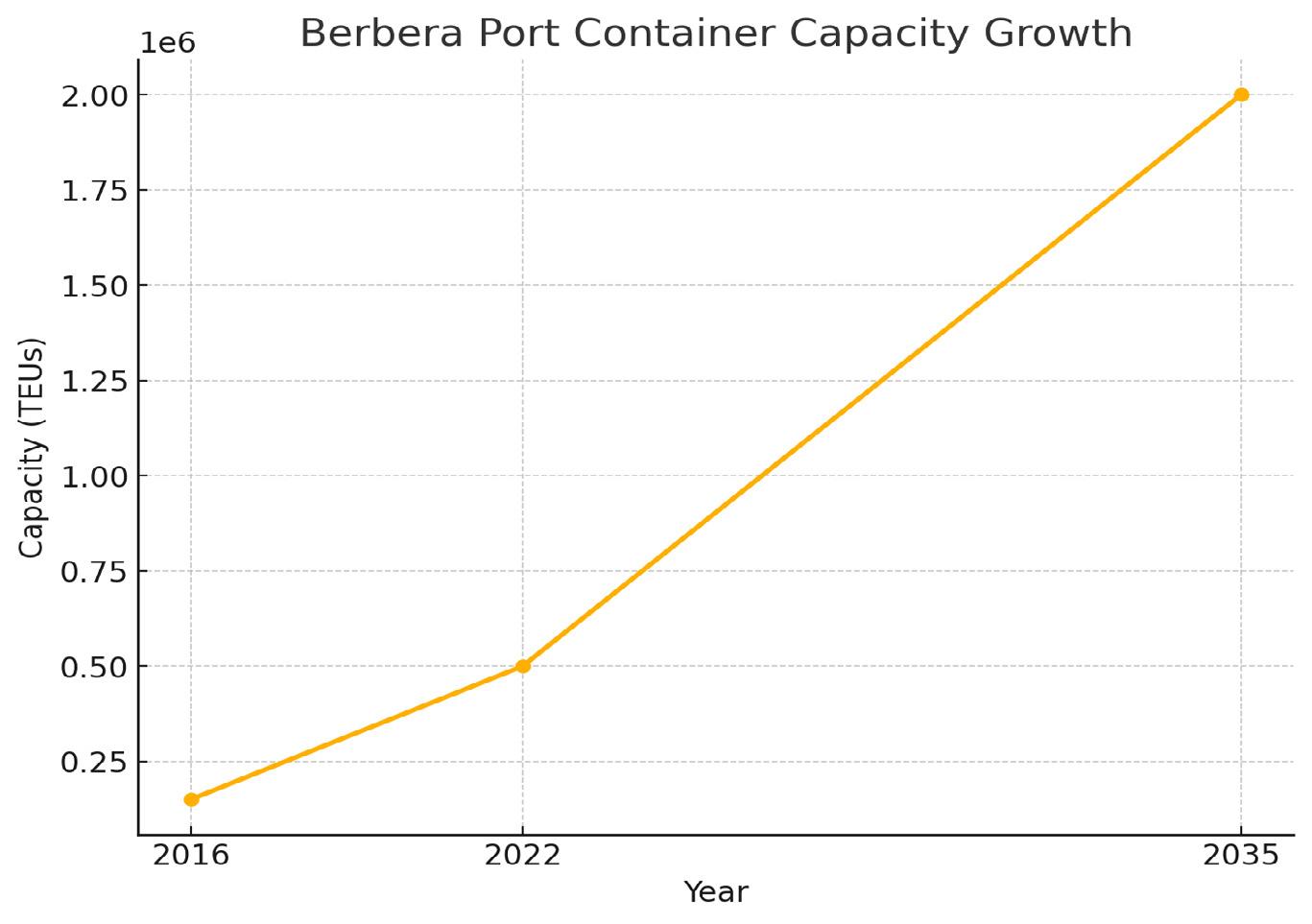
active in Somalia, a US presence in Berbera would provide strategic redundancy and stronger counter-terrorism reach.
Officially, Washington continues to affirm Somalia’s territorial integrity. Yet momentum is building toward a more pragmatic stance. Former British Defence Secretary Gavin Williamson and US Congressman John Moolenaar have urged deeper engagement with Hargeisa, citing both democratic governance and the Berbera opportunity. Bipartisan hearings in the US Congress have floated opening a liaison office in Hargeisa—a step that would stop short of recognition but signal serious intent.
China’s dominance in African infrastructure, particularly in Djibouti, sharpens Somaliland’s appeal. Beijing’s multi-bn-dollar Belt and Road investments have entrenched its presence, raising alarms in Washington. Somaliland counters with a pitch of ‘equitable partnership’: military access, mineral cooperation and governance support without debt diplomacy. For the EU and multilateral lenders, deeper engagement could reset investment frameworks, but African Union norms against secessionist recognition remain a formidable obstacle. Addis Ababa, Nairobi and Cairo would likely resist any precedent encouraging other separatist movements.
The dangers are significant. The Las Anod conflict threatens to unravel Somaliland’s stability narrative, while disengagement from Mogadishu risks weakening counter-terrorism operations against al-Shabaab. A carefully calibrated dual-track approach—engaging both Hargeisa and Mogadishu—may be the only sustainable path.
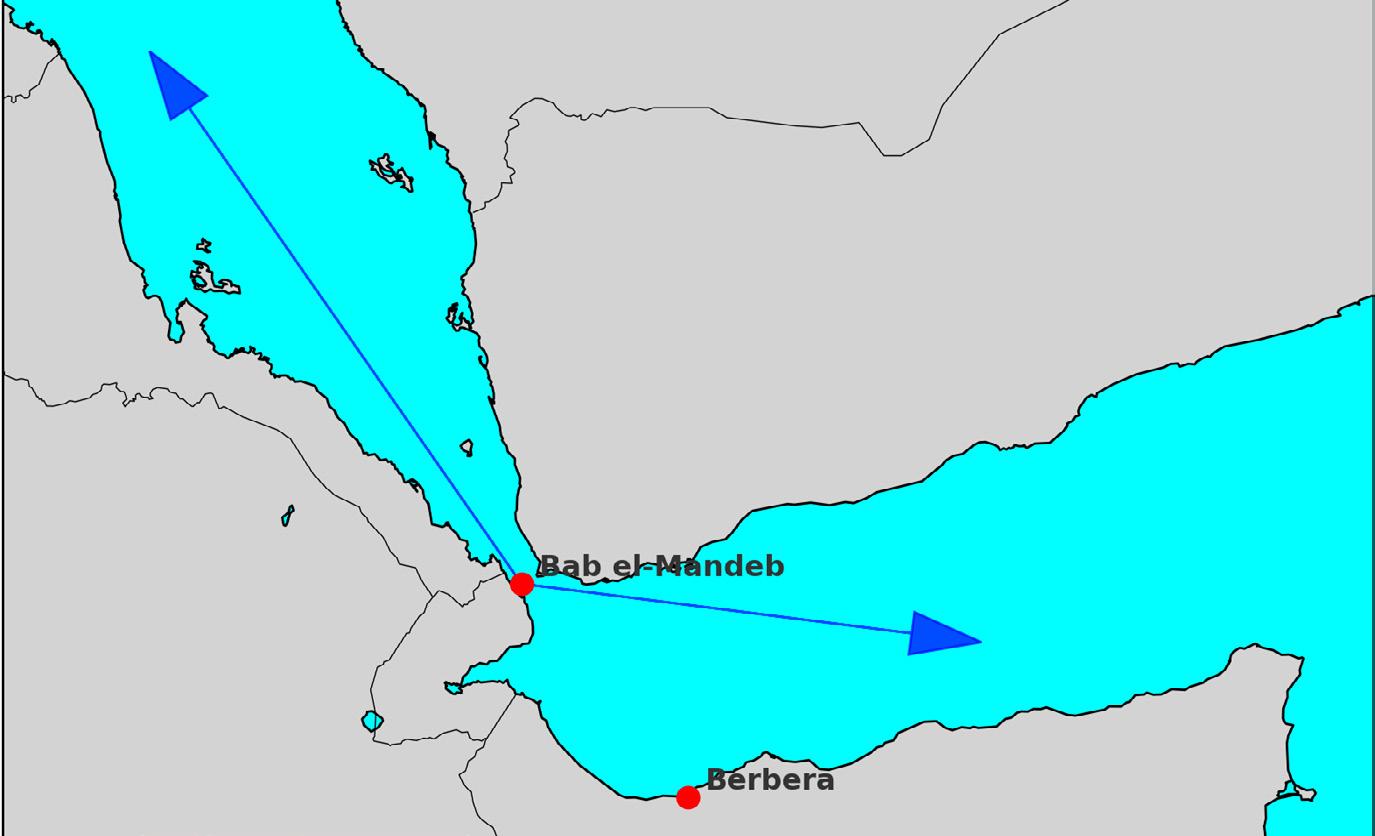
Somaliland’s campaign for US recognition is no longer a marginal issue; it is a test of how Washington balances principle with pragmatism in an era of great-power rivalry. Berbera’s proximity to the Bab el-Mandeb Strait gives Somaliland undeniable geostrategic weight, while its untapped critical minerals align neatly with US ambitions to reduce dependence on Chinese-dominated supply chains. These assets ensure Hargeisa will remain on the radar of US policymakers even if formal recognition proves elusive.
Yet the risks are stark. Internal divisions, particularly the Las Anod conflict, expose cracks in Somaliland’s stability narrative. Any US tilt toward Hargeisa must be carefully staged to avoid undermining counter-terrorism operations in Somalia or alienating African Union partners wary of secessionist precedents. China’s entrenched presence in Djibouti and across African infrastructure means
hesitation could leave Washington disadvantaged in securing one of the world’s busiest maritime arteries.
For Washington, the issue is not whether Somaliland matters—it clearly does—but how to engage without tipping the Horn into greater instability. A phased approach, beginning with a liaison office and targeted economic and security cooperation, could deliver tangible benefits while preserving flexibility. Formal recognition remains the boldest and riskiest option, signalling a decisive US pivot in the Red Sea but carrying significant diplomatic costs.
As Gitau concludes, Somaliland’s pitch to Washington underscores a broader truth: in the geopolitics of the Red Sea, geography and resources can give even unrecognised states a seat at the table. Whether that seat comes with a flag will depend on how Washington balances immediate strategic needs against long-standing commitments to African unity and stability.
Status quo (One Somalia)
Partial engagement
Full recognition
Upholds AU and UN norms; avoids alienating Mogadishu and AU partners.
Establish liaison office; partner in mining and maritime security without formal recognition.
Secures Berbera base; diversifies critical minerals; rewards Somaliland’s democratic governance.
Missed leverage in Red Sea security; Chinese dominance in Djibouti remains unchecked.
Could strain ties with Mogadishu; AU may view as de facto recognition.
Diplomatic rupture with AU and Somalia; risks inspiring other separatist claims.
Prioritises stability over opportunity.
Pragmatic balancing—hedging without commitment.
Bold US pivot prioritising great-power competition over traditional diplomacy.
In this in-depth analysis, Jon Offei-Ansah examines how a fully connected network of continental highways could unlock the African Continental Free Trade Area’s vast potential—lifting millions from poverty and reshaping regional trade
THE African Continental Free Trade Area (AfCFTA) is the boldest economic integration effort in Africa’s history. The World Bank estimates that if fully realised it could lift 30 million people out of extreme poverty and add $450 billion to Africa’s income by 2035. But those figures remain aspirational until Africa overcomes its most persistent constraint: the absence of seamless transport infrastructure.
At the heart of this challenge lies the dream of a Trans-Continental Highway network—spanning Cairo to Cape Town, Dakar to Djibouti, and Lagos to Mombasa. These roads are far more than asphalt. They are the arteries through which goods, people, and ideas can move with speed and dignity. Without them, AfCFTA risks becoming a paper tiger rather than a transformative development strategy.
The idea of linking Africa with a continuous network of highways is not new. The Trans-African Highway programme was first conceived in the 1970s under the aegis of the Organisation of African Unity and the United Nations Economic Commission for Africa (UNECA). Ambitious on paper, it sought to create nine major corridors totalling more than 56,000 km. Political instability, financing shortfalls, and fragmented planning stalled progress for decades, but those early blueprints remain the foundation for today’s agenda. Learning from that history—especially the need for sustained cross-border coordination—will be crucial as the African Union revives the concept for the AfCFTA era.
Trade and competitiveness hinge on the cost and reliability of moving goods. AfCFTA aims to double intra-African trade by 2035, but only if transport bottlenecks disappear. According to regional development data, efficient highways can cut logistics costs by up to 50 percent, an enormous boost for exporters and small enterprises alike.
Today, intra-African trade represents just 14 to 18 percent of total commerce,
compared to around 60 percent in Europe. This gap reflects not a lack of entrepreneurial spirit, but the friction caused by poor connectivity. A seamless highway network would close that gap, linking producers to consumers across borders and strengthening regional value chains from agriculture to high-tech manufacturing.
There are promising examples. The Abidjan–Lagos corridor, which handles around 70 percent of West Africa’s trade, has shown how focused investment and regional cooperation can reduce transit times and stimulate industrial clustering. Likewise, the Maputo Corridor between South Africa and Mozambique demonstrates the potential of publicprivate partnerships to finance and maintain high-traffic routes. Yet both corridors also reveal pitfalls: congestion at border posts, inconsistent axle-load standards, and maintenance funding gaps can quickly erode efficiency gains. These lessons underline the need for harmonised regulation and steady upkeep alongside new construction.
UNECA projects that $411 billion must be invested by 2030 to meet AfCFTAdriven transport demand. Highways are the backbone of this industrial clustering.
Well-connected corridors allow companies to consolidate production, lower input costs, and access wider markets.
Consider a Zambian solar equipment manufacturer seeking to supply North Africa. With modern highways, the firm could reach Tunis at 30 percent lower cost, making regional renewable-energy supply chains viable. Similarly, agro-processing plants along the Lagos–Mombasa corridor could scale up exports to new African markets, drawing in foreign investment and creating skilled jobs.
Jobs, inclusion, and resilience
Infrastructure investment is a proven job creator. Every $1 billion channelled into highway construction generates roughly 110,000 direct jobs, with ripple effects across small and medium-sized enterprises and supply chains. This offers an inclusive path to growth, engaging local contractors, engineers, and service providers while providing training and long-term employment.
Beyond economics, integrated corridors strengthen food security and climate resilience. Poor roads add 30–40 percent to the cost of goods, a burden that worsens during climate shocks or global supply disruptions. A resilient highway
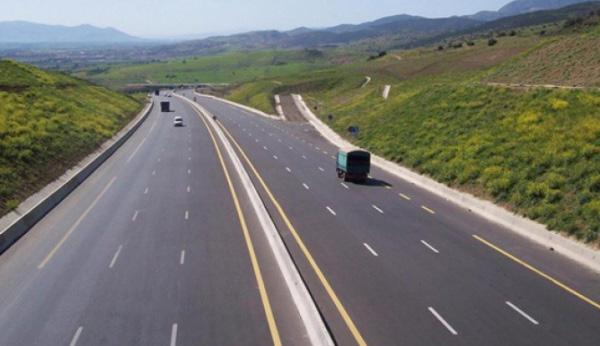
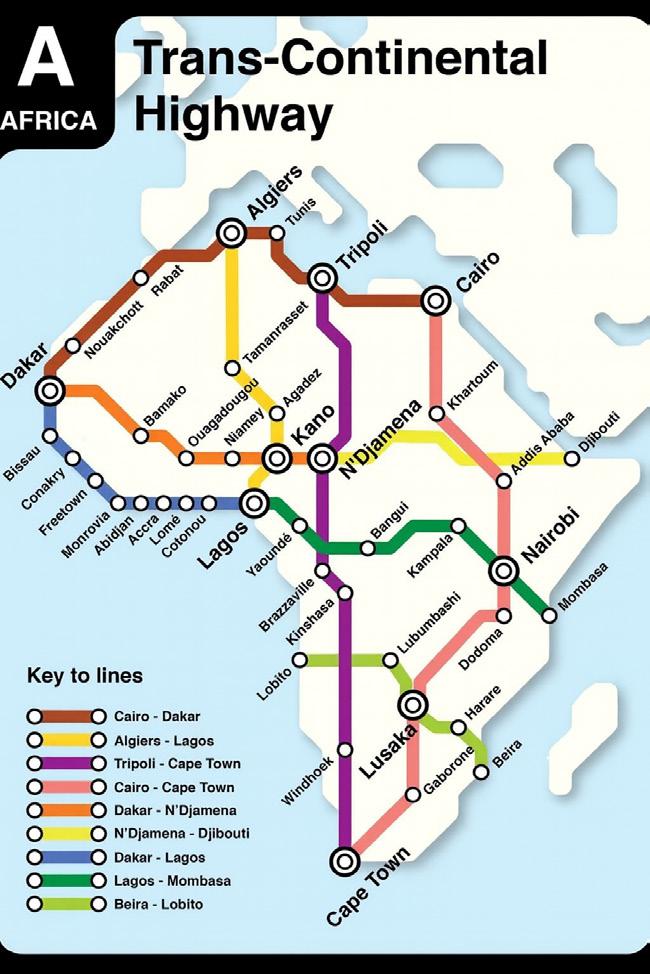
network would improve the distribution of staple foods and renewable energy, allowing Africa to adapt to increasingly volatile weather patterns and shifting global markets.
African logistics and trucking associations emphasise that improved road infrastructure lowers not only transport costs but also insurance premiums and vehicle maintenance expenses. They argue that predictable travel times can double the daily distance a truck covers, directly boosting profitability. However, these operators warn that opaque tolling regimes and inconsistent enforcement of axle-load limits deter private investment. Clear, continent-wide rules could unlock large pools of private capital ready to finance maintenance and fleet upgrades.
For 16 African countries with no coastline, highways are essential lifelines to ports and markets. In these states— from Burkina Faso to Uganda—transport costs are often double those of coastal neighbours. A farmer in eastern Uganda currently needs up to three weeks to send produce to Dakar. A fully developed transAfrican highway could reduce that journey to seven days, transforming incomes and reducing post-harvest losses.
Closing Africa’s annual infrastructure financing gap, estimated between $68 billion and $108 billion, demands creativity. Blended finance—combining sovereign funds, concessional loans, and
innovative instruments such as diaspora bonds—can mobilise capital while lowering risk for private investors.
Public-private partnerships (PPPs) already show promise. Toll roads in East and Southern Africa record traffic growth of 6–8 percent annually, proving that user-fee models can sustain maintenance and attract investment. Corridor-wide PPPs could replicate this success, provided regulatory frameworks ensure transparency and equitable revenue sharing.
Another proposal is a Continental Infrastructure Fund anchored under the African Union Development Agency–NEPAD. Pooling resources from member states, development finance institutions, and pension funds would give projects the scale and predictability needed to attract large institutional investors.
The potential ripple effects of an integrated highway system are striking. Border towns that currently function as choke points could evolve into vibrant trade hubs with logistics parks, warehousing, and cross-border services. Economic diversification would follow, as corridors catalyse agro-processing clusters, industrial parks, and digital logistics platforms.
Imagine a Senegalese food processor sourcing grains from Mali and delivering finished products to Nigeria within days, not weeks. Or an Ethiopian technology start-up shipping components to West Africa without the unpredictable delays that plague current road networks. These scenarios illustrate the transformative power of predictable, efficient road corridors.
An interconnected Africa also wields greater geopolitical influence. Efficient transport corridors strengthen the continent’s negotiating power in global trade forums, enabling collective bargaining on supply-chain security and investment standards. By presenting a united, well-connected market of 1.4 billion people, Africa can negotiate trade deals with partners such as the European Union, the United States, and emerging Asian economies from a position of strength. Highways, in this sense, are tools of diplomacy as much as development.
Financing alone will not deliver AfCFTA’s highway ambitions. Strong governance and regional policy coordination are equally vital. Harmonising customs procedures, axle-load standards, and road maintenance regimes will prevent the new highways from becoming congested or prematurely degraded.
African governments must also prioritise transparency to attract private capital. Clear land-acquisition processes, anti-corruption safeguards, and independent regulatory oversight will reassure investors and communities alike. The African Union can play a convening role, setting standards and monitoring progress to ensure that national projects align with continental priorities.
Highway construction must balance economic growth with environmental stewardship. Incorporating climate-resilient designs, such as elevated roadbeds and improved drainage, reduces vulnerability to flooding and extreme weather. Using lowcarbon materials and integrating renewable energy for rest stops and logistics centres can further reduce emissions.
Moreover, better roads can cut transport-related emissions by improving traffic flow and enabling efficient freight movement. Shifting from air or poorly maintained routes to modern highways can lower the carbon intensity of African trade, aligning AfCFTA’s growth goals with global climate commitments.
The African Continental Free Trade Area is far more than a trade agreement. It represents a continental development strategy aimed at creating shared prosperity and strengthening Africa’s position in the global economy. Highways are the arteries through which that vision will flow.
With adequate financing, regional coordination, and climate-sensitive planning, the Trans-Continental Highway network can unlock the full promise of AfCFTA. The benefits—from poverty reduction and industrial diversification to climate resilience and geopolitical influence—are too significant to delay.
Africa’s demographic trajectory adds urgency. By 2050, the continent’s population is projected to reach nearly 2.5 billion, with cities expanding at unprecedented rates. Without modern transport links, urbanisation could strain food supplies and employment prospects. With them, Africa’s youthful population can become a dynamic economic force, powering innovation and sustainable growth.
Africa has the ambition. Now it must build the roads to match. The task requires political will and patient investment, but the reward is a continental economy capable of lifting millions from poverty and giving the next generation the mobility and opportunity it deserves.
Jon Offei-Ansah examines how Burkina Faso, Mali and Niger have upended West Africa’s economic order, leaving ECOWAS and forming the Alliance of Sahel States in a bold bid for sovereignty that could redefine the region—or deepen its fractures
WHEN Burkina Faso, Mali and Niger formally quit the Economic Community of West African States (ECOWAS) in January 2024, it marked the climax of a two-year confrontation. ECOWAS had suspended all three after a wave of military coups and threatened sanctions and, in Niger’s case, even military action.
Their withdrawal was more than a diplomatic quarrel. Facing mounting sanctions and political isolation, the juntas sought to rewrite their relationships with the outside world. Paris, Washington and major international organisations such as the Organisation Internationale de la Francophonie became targets of resentment. Western forces were told to leave, ambassadors expelled, and economic agreements frozen.
Rather than remain isolated individually, the three landlocked nations forged a collective path. In July 2024 they unveiled the Alliance of Sahel States (AES), anchored in a mutual defence pact first signed in September 2023. Today, their leaders talk openly of a common market, a single currency and even a federal state—an ambitious agenda for countries confronting insurgency and economic fragility.
Despite political turmoil, the AES bloc commands surprising heft. Together the three nations post a combined GDP of nearly $70 billion and house more than 75 million people—around 30 percent of the West African Economic and Monetary Union (UEMOA) economy and nearly half its population.
French remains the administrative language, but cultural ties run deeper, woven through local languages such as Bambara in Mali, Mooré in Burkina Faso and Hausa and Zarma in Niger. Agriculture and mineral exports dominate their economies, linking them to global commodity cycles.
Against expectations, all three delivered robust growth in 2024. Niger’s economy surged almost 10 percent, Africa’s fastest rate and third globally. Burkina Faso expanded by about 5.5 percent and Mali by nearly 3.8 percent. Government spending on roads, energy projects and agriculture underpinned these gains, while strong demand for uranium and gold provided hard currency.
Yet headline growth masks underlying weakness. Nominal GDP per capita barely tops $1,000 in Mali and Burkina Faso and is under $750 in Niger. Human Development Index scores remain among the world’s lowest. Poverty,
youth unemployment and inadequate infrastructure leave these economies vulnerable to shocks—from climate change to commodity price swings.
Determined to chart their own course, AES leaders have moved to knit their markets together. A joint biometric passport, abolition of regional roaming charges and creation of a tri-nation sports competition signal a push for freer movement of labour and goods.
Financial sovereignty is their boldest objective. In May 2025, the AES launched the Confederal Bank for Investment and Development to fund infrastructure projects without heavy reliance on the

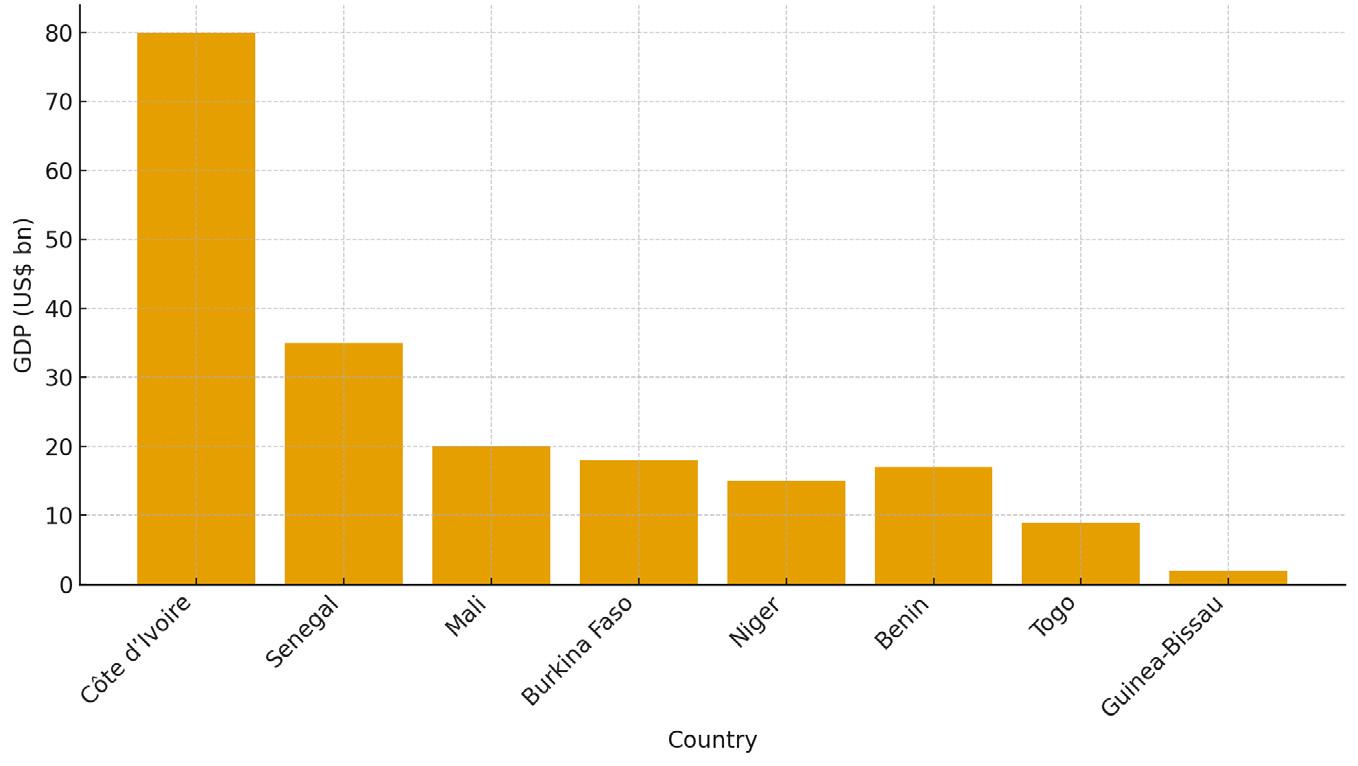
World Bank or IMF. A modest confederal customs levy on imports from outside the bloc now feeds a pooled fund for regional projects—small steps toward selffinancing.
Officials also talk of harmonising tax codes, easing customs procedures and creating cross-border special economic zones. Such measures, if implemented, could lower trade costs and build a foundation for a future common market.
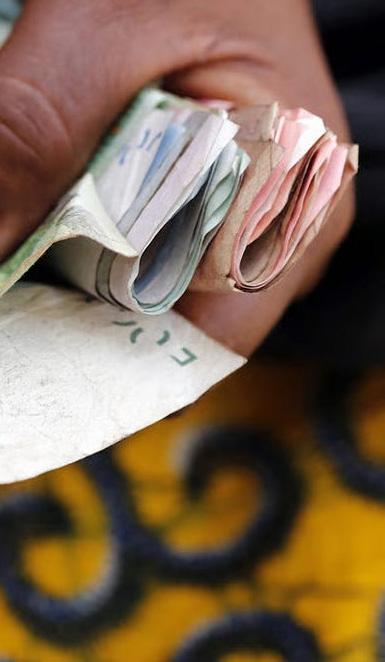
The thorniest question is monetary. The AES remains within UEMOA and tied to the CFA franc, pegged to the Euro and backed by a French Treasury guarantee. Supporters say the peg provides crucial stability; critics argue it limits monetary flexibility and symbolises colonial legacy.
Exiting the CFA system would let the AES reclaim control of foreign reserves now held with the regional central bank and in part with France. But it would also remove the stabilising French guarantee and raise borrowing costs. Leaders have floated the idea of a new joint currency and central bank, yet such a move demands credible fiscal management, deep reserves and investor trust—no small feat for governments battling insurgencies and budget pressures.
A break with UEMOA would also shake the wider monetary union. Côte d’Ivoire and Senegal, UEMOA’s largest economies, would have to shoulder greater responsibility, while investors might question the bloc’s durability. Even rumours of an AES exit already prompt market unease.
The alliance’s stance toward foreign capital is equally complex. Western miners such as Orano and Barrick Gold have seen contracts cancelled or renegotiated as governments seek larger stakes in strategic resources. Nationalisation of certain operations reflects a bid to capture more revenue from gold, uranium and potential lithium reserves.
Yet new partners are rushing in. Russia has signed nuclear-energy cooperation deals with Mali and Burkina Faso, including plans for a small nuclear plant in Ouagadougou. China is extending credit lines for infrastructure and telecommunications, while Turkey pursues construction and defence contracts.
For private investors, opportunity and risk coexist. Shares of companies such as Bank of Africa (Burkina Faso, Mali, Niger) and Onatel are traded on the Bourse Régionale des Valeurs Mobilières (BRVM), offering exposure to the region’s growth. But political volatility, opaque regulation and security threats mean investors must weigh rich mineral potential against serious instability.
None of the AES ambitions can succeed without addressing security. Jihadist violence continues to plague large parts of all three countries, displacing millions and draining public finances. Cross-border smuggling of arms and migrants compounds the challenge.
Humanitarian agencies warn that food insecurity and climate stress—droughts in Niger, erratic rains in Mali, deforestation in Burkina Faso—could undermine economic progress. Rapid population growth adds further pressure: the bloc’s combined population could double by 2050, demanding massive investment in education, health and energy.
Neighbouring states are watching closely. Ghana, Benin and Côte d’Ivoire rely on trade corridors that cross AES territory, and border closures have already stranded hundreds of trucks and disrupted supply chains. If the AES eventually leaves UEMOA, it could fracture regional trade patterns and force ECOWAS to rethink its integration agenda.
Globally, the shift creates space for new geopolitical competition. Russia’s security and energy deals, China’s infrastructure finance and Turkey’s defence sales highlight a multipolar scramble for influence in the Sahel—one that sidelines traditional Western partners.
The AES represents one of the boldest experiments in African regional politics in decades. By rejecting ECOWAS and challenging UEMOA’s financial orthodoxy, Burkina Faso, Mali and Niger are betting that sovereignty will deliver prosperity. Early economic resilience shows grit, but structural weaknesses and security risks remain severe.
Whether the alliance can transform short-term growth into long-term development without destabilising francophone West Africa’s monetary union is uncertain. A successful new currency or integrated market could reshape the region’s political economy. Failure could deepen isolation, leaving millions more vulnerable to conflict and poverty.
For now, the world watches a high-stakes test of whether political independence can be matched by economic self-reliance.
Christopher Burke analyses how artificial intelligence could reshape Africa’s economy, jobs and sustainability, weighing the continent’s vast opportunities against rising risks
AFRICA is entering an era of simultaneous opportunity and risk. Examining demographic pressures, economic structures and infrastructural gaps, Artificial Intelligence (AI) is expected to have a profound impact on how wealth and power are concentrated or spread equitably.
The youth bulge is among the most significant structural features of the continent’s economy. Over 60 percent of Africa’s population is under 25 years old; sub-Saharan Africa alone is expected to supply half of all global new labour-force entrants by 2030, requiring the creation of 15 million new jobs annually to maintain current levels of employment.
Informal employment continues to dominate. The informal sector accounts for about 86 percent of total employment in Africa, including subsistence farming, small trade, artisanal work and informal services. Agricultural work remains the main source of livelihoods in many low and lower-middle income countries, employing the largest share of workers in 46 of 54 African states while the sector’s contribution to Gross Domestic Product (GDP) remains modest.
Physical infrastructure—including electricity, roads and broadband—and
institutional infrastructure such as data systems, regulation and education pipelines all lag behind needs. AI readiness indices reveal significant variation across the continent. Some countries have growing lab or university programmes in AI, but many suffer from unreliable electricity, low internet bandwidth, weak regulatory clarity and insufficient computing capacity.
A youthful population, reliance on informal and agricultural livelihoods, and underdeveloped infrastructure set the stage for how AI will take root across the continent.
AI and automation are already interacting with existing patterns of inequality and labour division. A study on AI innovation clusters in Africa—including South Africa, Kenya, Nigeria and Egypt— listed youth unemployment and skills mismatch among the top obstacles. Many young people have credentials but lack practical skills, while demand shifts toward data analysis, software and domain-specific AI tools.
Another report suggests that the digital economy and AI-enabled services could reduce youth unemployment in West Africa in both the short and long term if appropriate investments in training, connectivity and regulatory support are
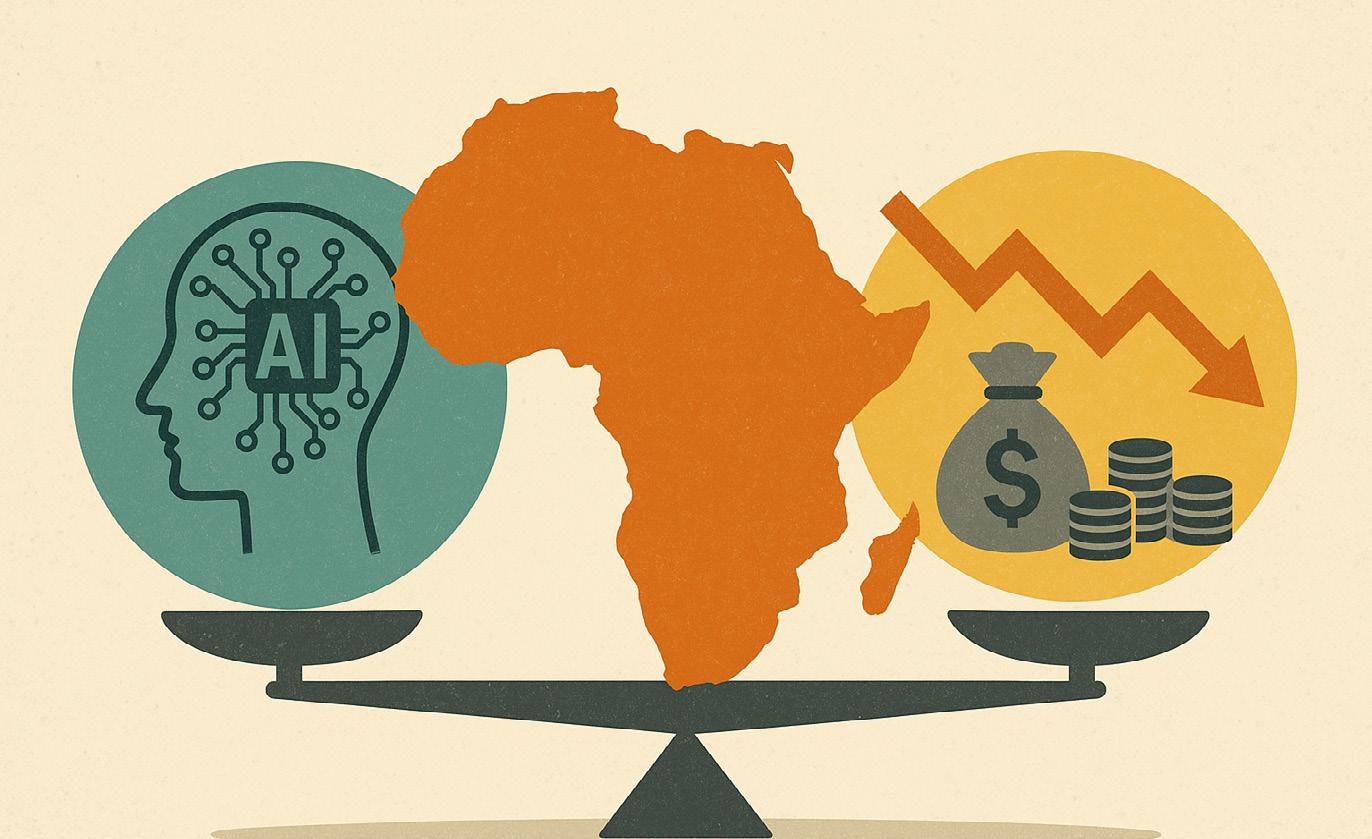
made. Otherwise, benefits cluster among those already relatively privileged.
Gender and role stratification are emerging issues. A report delivered at the Global AI Summit for Africa in Kigali earlier this year suggested women’s roles are about 10 percent more likely to be automated than tasks given to men in the region’s outsourcing sector. This phenomenon is expected to be most pronounced in lower-paying and lowerskill roles.
In terms of economic output, Landry Signé at the Washington DC–based Brookings Institution suggests AI and emerging technologies have the potential to boost GDP growth in many African economies by raising productivity in sectors such as agriculture and services while accelerating structural transformation. Signé concedes there are risks these gains will accrue to large firms or external actors rather than local labour and smaller businesses, compounding inequality.
Many governments are exercising pragmatic leverage rather than large-scale institution-building. Examples include export restrictions on raw minerals, requirements for local content in contracts for infrastructure or energy, and data localisation or licensing requirements for finance or telecom firms. These are defensive tools to retain value, slow external extraction of profits and provide bargaining power despite weak public institutional capacity.
These gatekeeping mechanisms are likely to grow. Countries with valuable resources such as minerals needed for AI and renewable technologies, rare earths and agricultural output can negotiate stronger terms, demand shared processing or attach environmental and social requirements. Nonetheless, such strategies carry risk. Without transparency and oversight, rents can be captured by elites or terms honoured more in letter than in practice. Slow legal or regulatory systems can also limit effectiveness.
Data governance quickly becomes a point of contention. Where foreign

platforms collect massive amounts of user data without counterpart policies on privacy, data ownership and sharing, local communities may supply raw inputs in the form of data and labour but see little value capture. This contributes to persistent asymmetries in the global North–South distribution of gains.
Many African economies are opening and integrating into global digital and AI-enabled markets. Fintech, mobile telephone services, agri-tech, platforms and digital marketplaces are growing rapidly. Innovation clusters anchored in universities, start-ups and tech hubs are beginning to supply services, solutions and research that serve local and global markets.
This exposure brings gains: faster service delivery, potential for scale, access to foreign capital and opportunities to leapfrog older infrastructure constraints. Crop monitoring via remote sensing, insurance and mobile phone applications in agriculture all leverage AI and data to achieve productivity gains that traditional subsidies and extension services cannot match.
Gains are uneven. Skill mismatches are real. Youth often have education credentials that do not align with market demand, leaving them overqualified for informal roles and underprepared for formal digital positions. Connectivity remains patchy across the continent. Many households lack reliable internet or electricity, making adoption of AI tools difficult—especially in rural areas and among refugees. Regulatory frameworks are nascent, with policy lagging. Few countries guarantee data rights or enforce algorithmic fairness.
Productivity and output in exposed sectors may improve and GDP may grow
faster, but many workers, especially in informal or agricultural sectors, are likely to see little improvement in incomes or job quality. Some may even lose certain entry points such as clerical and transactional roles to automation without clear pathways into newer, more skilled roles.
Defensive responses to AI may help countries retain more value at home but risk locking economies into stagnation. Conversely, rapid openness to new technologies can generate productivity gains but often excludes large segments of society. Both approaches are increasingly being drawn toward a common ground focused on sustainability, anchoring AI and economic growth in climate resilience, environmental stewardship, social inclusion and fairer distribution of benefits.
A recent analysis supported by the Boston Consulting Group estimates Africa’s green economy could generate 3.3 million jobs by 2030 in renewable energy, e-mobility, construction and manufacturing in countries including Kenya, Nigeria, Ethiopia and the DRC. The findings suggest many of these jobs will be in skilled or semi-skilled categories. Investments in clean energy, solar, grid electrification and climate-smart agriculture are promising opportunities where leverage and exposure combine to facilitate local content, environmental safeguards and foreign investment.
AI needs data from rural, remote or displaced communities to strengthen resilience and predict floods or drought for climate adaptation, improved land use and early warning systems. This requires improvements in mapping and the inclusion of settlements in datasets. The same data improvements strengthen bargaining power and infrastructure planning.
A further development is the role of communities and grassroots AI clusters comprising local innovators, youth networks and civic groups that are beginning to bridge gaps by creating context-specific tools, conducting participatory mapping and tackling problems grounded in local realities. Typically under-resourced, these initiatives consistently demonstrate an ability to nurture talent, strengthen social capital and foster local agency. Even modest support can amplify their impact and redirect value generated by AI toward local actors.
Bringing these dynamics together, several trends are likely to define the coming decade. Economic output is
likely to rise in agriculture, services and selected AI-enabled sectors; yet without redistribution and stronger local ownership many of the benefits will flow to elites, foreign firms and those already positioned to capture value. At the same time, as AI and automation absorb routine and transactional tasks, entry-level jobs will contract. New, higher-skilled roles may emerge, but weak education systems and infrastructure will limit how widely they are accessible, leaving many young people in informal or low-productivity work.
Data systems and infrastructure will continue to improve unevenly with remote, rural, displaced and informal communities often under-represented. This invisibility risks the perpetuation of underinvestment and service gaps. Growing climate pressures and the flow of green finance will make sustainable AI and infrastructure more attractive areas for investment, particularly where renewable energy, adaptation and environmental safeguards are linked. Pressures for accountability from citizens, civil society and international partners can be expected to intensify. Weak governance is likely to result in abuse or extraction while stronger leadership can provide leverage to set fairer terms.
Africa’s engagement with AI is taking shape amid demographic pressure, widespread informality and dependence on agriculture, infrastructure gaps and weak data systems. Two trajectories are emerging: defensive leverage through gatekeeping and openness through market integration. Neither on its own ensures fair outcomes. Both are increasingly drawn toward sustainability, anchoring AI and economic growth in climate resilience, green transition and environmental protection—creating a real chance to determine whether inequality is entrenched or reduced.
If value capture, inclusive data, smoother labour transitions and environmental alignment can be combined effectively, AI could support not only productivity gains but broader prosperity. Without such efforts, the risks are clear: deepening income divides, sharper geographic disparities, reduced demand for entry-level work and the ongoing marginalisation of rural, displaced and informal populations. Decisions taken now in regulation, education, mapping, infrastructure and local innovation will be decisive foundations for Africa’s AI future. AB
Africa’s AI market could reach $16 billionn within five years, yet the continent holds just 1 percent of global talent. Japan’s pledge to train 30,000 African professionals aims to narrow the gap—but can skills development outpace infrastructure and prevent a new brain drain?, asks Jon Offei-Ansah
AFRICA’S artificial intelligence market is projected to reach about $16 billion within five years, yet the continent accounts for barely 1 percent of global AI talent. From precision farming to fintech, companies are adopting machine-learning tools at breakneck speed, but the shortage of skilled engineers, researchers and analysts threatens to blunt economic gains and widen inequality.
At the August Tokyo International Conference on African Development (TICAD), Japanese prime minister Ishiba Shigeru announced a bold intervention: Japan will help develop 30,000 AI professionals in Africa over the next three years. The Japan International Cooperation Agency (JICA), Tokyo’s overseas development arm, will lead the effort, which aims to cultivate a deep reservoir of AI expertise across the continent.
Africa faces two intertwined hurdles: a lack of digital infrastructure and a dearth of professionals who can translate digital ambitions into reality. Data centres, highperformance computing resources and reliable connectivity remain scarce, with the continent hosting less than 1 percent of global data-centre capacity despite its rapidly growing population.
Yet JICA argues that people, not hardware, will determine the AI race. “We believe that talent is a key point to create value for the society and economy,” says Ryosuke Miyashita, JICA’s deputy director for digital transformation, in an interview with TechCabal. ‘Without talent, we can’t create infrastructure, we can’t create a strategy.’
Nigeria’s minister of communications, digital economy and innovation, Dr Bosun Tijani, agrees: ‘We may not have the compute and infrastructure, but we do have the talent.’ His remark highlights a critical reality: even if Africa could double its datacentre capacity tomorrow, progress would stall without trained experts to design algorithms, manage systems and analyse data.
JICA’s plan goes well beyond computer-science classrooms. Training will extend to policymakers and non-STEM faculty, embedding AI literacy across government and civil-society sectors.
The agency intends to support African universities and regional research networks while expanding bilateral cooperation with Japanese firms through internships, academic exchanges and joint research projects.
Collaborative efforts are already under way. The University of Tokyo’s MatsuoIwasawa Lab is co-developing online AI courses for students at the African Institute for Mathematical Sciences (AIMS), the University of Nairobi, Stellenbosch University and Morocco’s Mohammed VI Polytechnic. Hackathons and policy workshops will give participants hands-
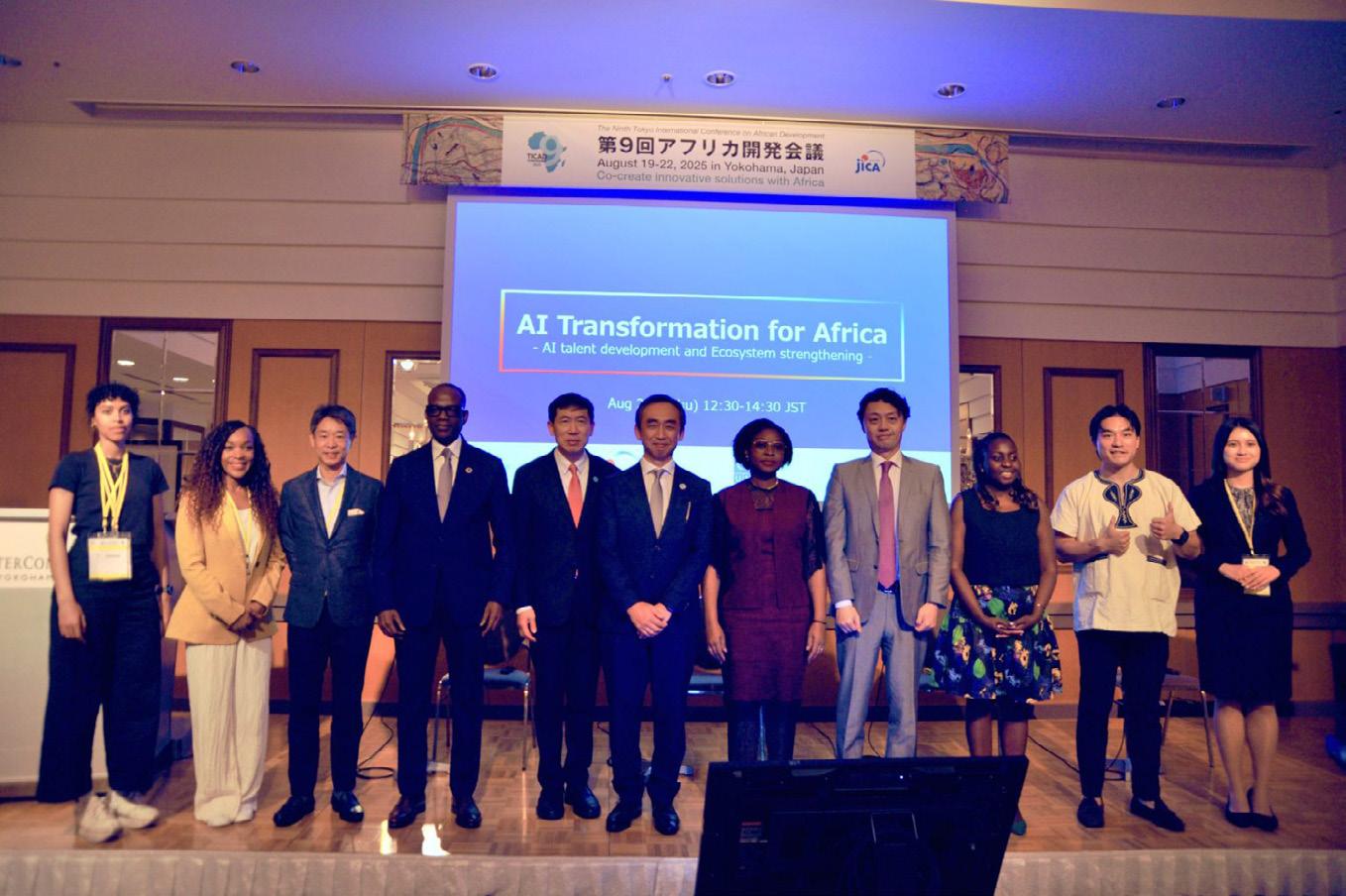
on opportunities to apply their skills to problems in health, manufacturing, agriculture and education.
For Tokyo, the initiative is not pure altruism. Japan faces a projected shortfall of about 450,000 IT professionals by 2030. Building ties with African researchers and engineers could help fill that gap while spurring “co-creation and co-innovation,” as Miyashita puts it.
Despite notable progress, Africa’s higher-education landscape struggles to produce advanced AI talent. Postgraduate programmes in machine learning remain limited, and many of the best graduates leave for lucrative positions in Europe or the United States. Sub-Saharan Africa currently generates just 0.02 percent of the world’s granted AI patents, underscoring the thin pipeline of fundamental research.
Grass-roots initiatives such as Deep Learning Indaba, which hosts annual pan-African conferences and mentorship schemes, and Ghana’s AI research centres have emerged to counter this deficit. But without sustained investment and local career prospects, these efforts risk being overwhelmed by demand.
JICA hopes to strengthen ‘centres of excellence’ that can anchor research on the continent. “We are going to really want to expand to many different universities at different levels of engagement,” says Atsushi Yamanaka, JICA’s senior adviser for digital transformation. The goal is not merely applied solutions to local challenges but contributions to global breakthroughs in foundational AI research.
Talent development cannot fully succeed without the computational muscle required for modern AI. Only about 5 percent of African AI professionals have access to the graphics-processing units and cloud resources needed for complex model training. Energy costs and patchy internet service compound the problem.
Private investors are beginning to respond: Nairobi and Lagos have seen a surge in data-centre construction, and South Africa is attracting hyperscale cloud providers. Yet regional disparities remain wide, and reliable power grids are still a prerequisite.
Japan is not the only nation eyeing Africa’s AI potential. Germany, Canada, the United Kingdom and Sweden all run AI-related development programmes, while Big Tech players such as Google have pledged millions of dollars to support
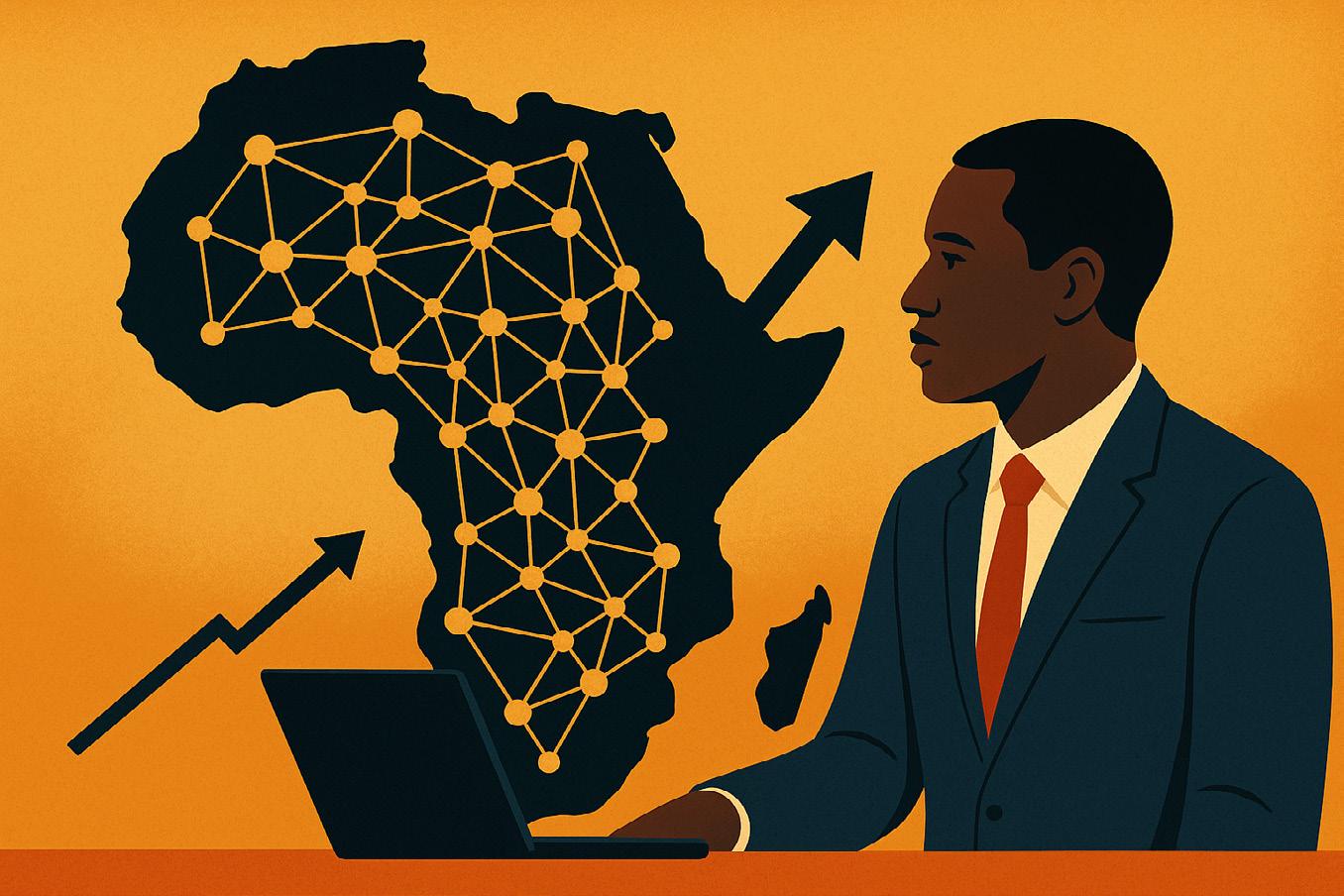
university research and open-source projects. Philanthropic groups like the Gates Foundation are funding applied AI in health care and agriculture.
Miyashita admits that coordination has lagged: “Different actors are doing things. We didn’t actually have the big picture … resources are limited.” JICA now aims to collaborate with other donors and private firms to avoid duplication and ensure that scarce funds create lasting impact.
Japan’s move also reflects a broader shift in its Africa policy. Long a champion of infrastructure projects through TICAD, Tokyo now wants to deepen technology and human-capital links. By cultivating AI expertise in Africa, Japan can secure future business partnerships and position itself as a trusted partner distinct from Western or Chinese investors.
For African governments, this offers a chance to diversify alliances and bargain for better terms. Several states, including Rwanda, Kenya and Ghana, are drafting national AI strategies aligned with the African Union’s emerging continental framework. Stronger cooperation with Japan could complement these efforts while giving African negotiators leverage in global AI-governance debates.
Still, success hinges on whether Africa can create enough high-quality jobs to retain its new experts. Without vibrant local industries and research labs, freshly trained engineers could migrate to Europe, North America or Asia.
“The worst outcome is that Africa becomes a talent farm for richer economies,” warns a Nairobi-based AI researcher involved in the Deep Learning Indaba network. That would replicate earlier patterns in medicine and engineering, where publicly funded education benefits wealthier countries.
Some governments are experimenting with incentives—tax breaks for AI startups, grants for university spin-offs and public-sector research fellowships—to keep talent at home. But budgets remain tight, and sustained private-sector investment will be crucial.
Despite the challenges, JICA sees African needs as fertile ground for joint innovation. “Needs drive innovation,” Miyashita says. “And Africa has no shortage of needs.” From climate-smart agriculture to predictive health analytics, the continent’s pressing problems could produce globally relevant solutions if given the right mix of skills, infrastructure and research freedom.
Whether Japan’s pledge to train 30,000 Africans will be enough is uncertain. The continent’s AI ambitions will require not just classrooms and servers but policies that promote open data, ethical standards and cross-border collaboration. If Africa can harness outside interest while building its own capacity, it could become not merely a consumer of AI technologies but a global leader in shaping them.
Despite a global fall in energy poverty, 600 million Africans still lack electricity. A Boston Consulting Group report urges bold reforms, smarter financing and renewable innovation to connect 300 million people by 2030, unlock $500 billion in growth and cut carbon emissions Jon Offei-Ansah reports
DESPITE a worldwide drop in ‘energy poverty’ of nearly 80 percent since 2010, Africa remains the last frontier of the electricity divide. Some 600 million people—around 83 percent of the global total—still live without reliable power. A new Boston Consulting Group (BCG) report, Unleashing Africa: Powering Prosperity Through Energy Access, warns that progress has stalled but sets out a strategy that could transform the continent’s economic prospects if implemented with urgency.
BCG estimates that connecting 300 million Africans to electricity by 2030 could raise the continent’s gross domestic product by more than $500 billion by 2040. The benefits would ripple across every sector: improved school completion rates, reduced infant mortality, new manufacturing opportunities and the avoidance of over 350 million tonnes of carbon dioxide.
‘Though the challenge may seem overwhelming, the social and economic opportunities are immense,’ said Kesh Mudaly, a lead author of the report and a senior member of BCG’s Climate & Sustainability and Energy practice in South Africa. ‘We must be ambitious and strive to reach the goal of connecting 300 million Africans by 2030.’
The scale of the opportunity is not just theoretical. Countries that have aggressively expanded energy access, from Vietnam to Brazil, have reaped dramatic economic dividends. Africa, with its growing population and vast renewable resources, has even greater potential if governments and investors align behind a coherent strategy.
Africa’s slow electrification stems from overlapping obstacles. Financing
is expensive; utilities are often undercapitalised; and many rural communities are far from existing grid networks. In some nations, power theft and unpaid bills undermine revenue. Conflict and climate shocks—from Sahel droughts to southern Africa’s cyclones—disrupt infrastructure and scare off investors. Without deliberate policy reform, the continent risks a twospeed future in which cities thrive while rural regions remain dark.
The BCG report identifies five focus areas that could unlock rapid progress.
1. Strengthen government planning and reforms
African governments must set clear electrification targets and publish detailed roadmaps identifying least-cost options— whether national grid extensions, mini-grids
or off-grid systems—for every community. Kenya and Uganda have shown that integrated planning across ministries and donor agencies can streamline efforts and avoid duplication.
Regulatory reforms are just as critical. Simplified licensing, cost-reflective tariffs and improved utility performance create the conditions for private investment. Ghana’s Energy Commission, for example, is piloting digital systems to cut red tape for independent producers. Without such reforms, even well-financed projects risk delay or failure.
2. Upgrade and expand grid infrastructure
Generation projects often capture headlines, but transmission and distribution networks are the arteries of electrification.
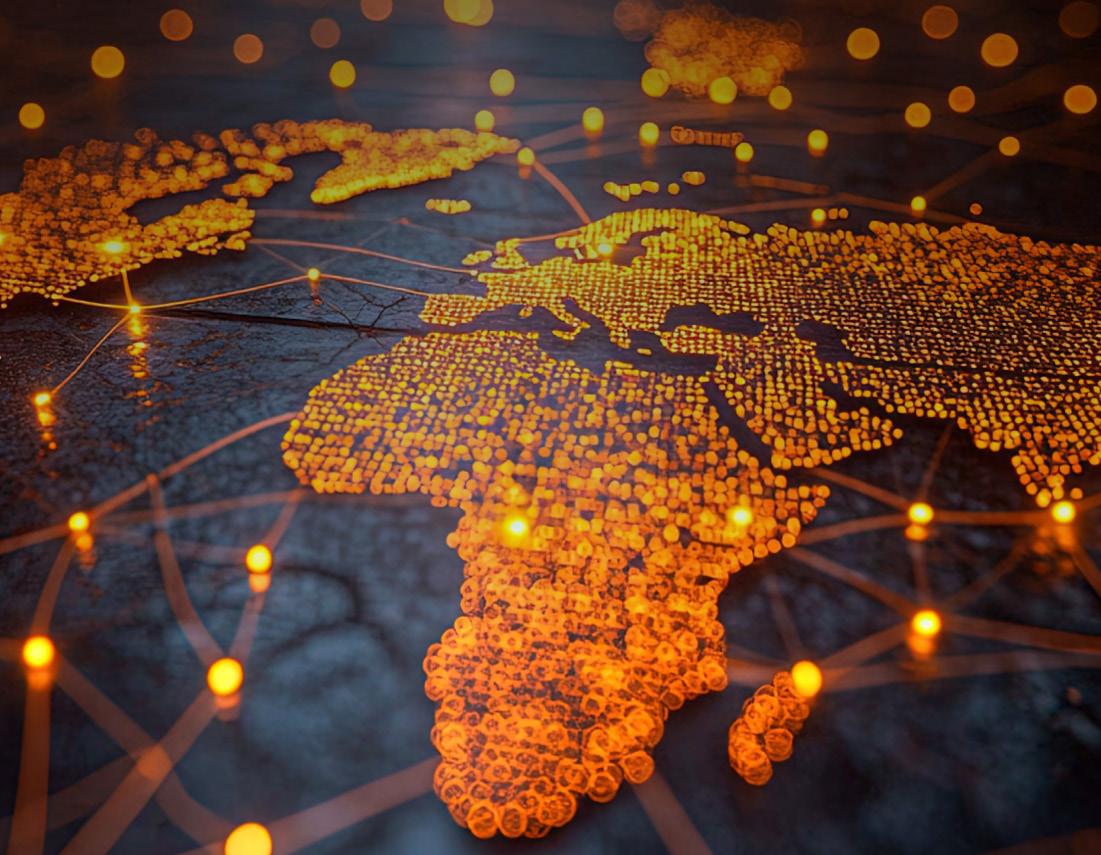
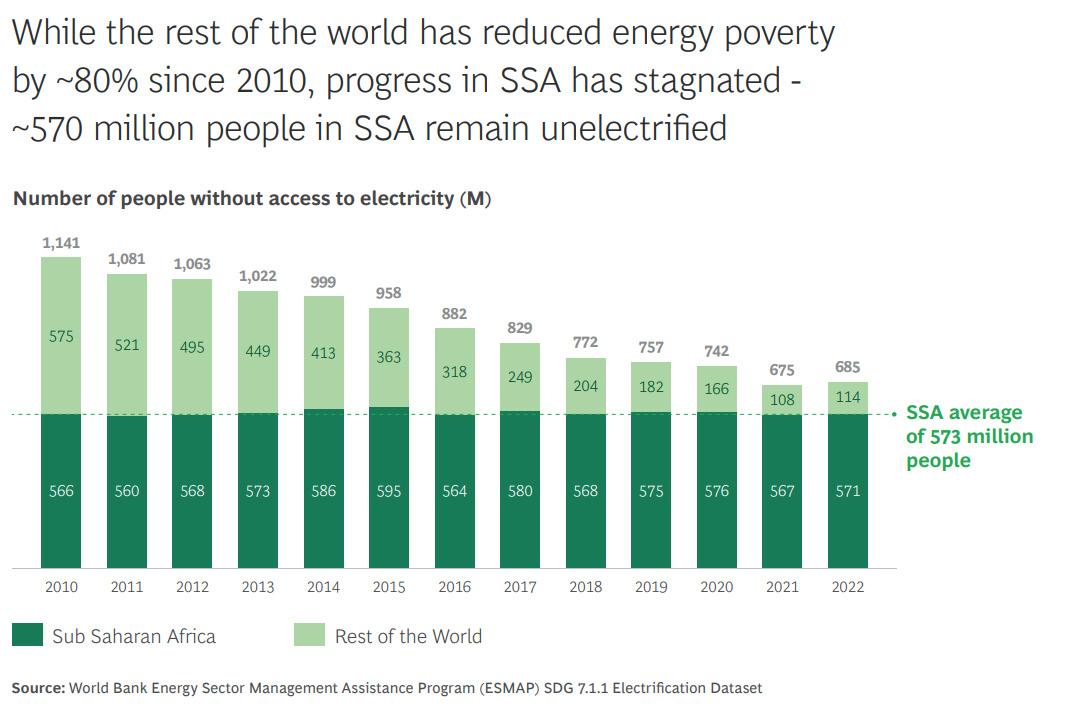
BCG stresses that connecting industrial hubs and population centres requires heavy investment in these often-neglected systems.
South Africa’s recent experience underscores the point: ageing transmission lines have limited the ability to integrate new renewable plants, causing widespread load-shedding. When public and private sectors combine data-driven planning with strong community engagement, ‘the lights come on—and lives change’, the report notes.
3. Scale distributed renewable energy and innovation
Centralised generation still dominates in many countries, but decentralised solutions can accelerate progress. Nigeria’s government, supported by the World Bank, is rolling out an ambitious off-grid project to deliver solar mini-grids to villages, targeting 2.5 million people and 70,000 businesses within a few years.
Technologies such as solar photovoltaic panels and small-scale wind turbines can bypass the delays of national grid construction. Falling battery storage costs make round-the-clock power increasingly feasible even in remote areas. Rwanda’s focus on pay-as-you-go home solar kits offers another scalable model.
4. Unlock capital through innovative financing
Even with strong plans, projects falter without finance. Development finance institutions remain important, but BCG highlights newer options: green bonds, carbon-credit schemes and dedicated climate-finance vehicles.
Brazil offers a powerful example. In the 1990s it opened its transmission sector to private concessions, quadrupling grid capacity and achieving near-universal access. African nations could adapt this model, partnering with experienced countries like India and Brazil to accelerate financial close and attract long-term investors.
Local capital markets also need nurturing. Kenya’s successful issue of a green bond to fund solar schools shows how domestic savings can be channelled into clean energy.
5. Drive productive usage and inclusion Simply connecting homes is not enough. Energy must translate into economic empowerment. Initiatives such as Solar Sister—active across West and East Africa—train women entrepreneurs to distribute solar lights and clean cooking stoves. To date, it has supported over 5,000 women and reached 1.8 million people.
Encouraging productive uses of energy (PUE) can also lift incomes: for instance, offering micro-loans to farmers to purchase electric irrigation equipment or helping small enterprises acquire power-hungry machinery. In Ethiopia, electrified grainmilling cooperatives have sharply reduced post-harvest losses while creating new jobs.
Africa accounts for 18 percent of the world’s population but fewer than 1 percent of companies with market capitalisations above $1 billion. In the energy sector, that gap is critical. While entrepreneurial activity abounds, most firms remain small and fragmented, lacking the scale to deliver complex projects or replicate models across borders.
BCG warns that without a new generation of sizeable local independent power producers and infrastructure firms, the continent will remain reliant on external actors and vulnerable to delivery risks. Scaling up homegrown companies capable of attracting long-term capital and executing multi-country projects is essential to meeting electrification targets.
Regional power pools—such as the Southern African Power Pool and West African Power Pool—could provide the platform for these local champions. By sharing generation resources across borders, they reduce costs and create larger markets for private investors.
Beyond electrons: wider social dividends
Reliable power underpins everything from modern healthcare to competitive manufacturing. Rural clinics need electricity to run diagnostic equipment and store vaccines. Schools require lighting for evening classes and internet connectivity. Businesses—from textile mills to data centres—cannot operate competitively without steady, affordable power.
Energy access is also central to climate strategy. Expanding renewables can cut emissions while reducing reliance on diesel generators, which are both polluting and expensive. By avoiding hundreds of millions of tonnes of carbon dioxide, Africa can strengthen its position in global trade as more markets adopt clean-energy tariffs.
A call for urgency and unity
Mudaly believes the next five years are decisive. ‘The experience of past projects and current initiatives makes one thing clear: when Africa’s public and private sectors align efforts, backed by data-driven planning and community engagement, the lights come on—and lives change,’ he said.
For policymakers, the message is clear: coordinated planning, regulatory reform and innovative financing are not optional— they are prerequisites for a prosperous, climate-resilient future. For investors, the opportunity is equally stark: a vast, underserved market ready for solutions that combine profit with impact.
The continent stands at a pivotal moment. With a unified push, Africa can dramatically accelerate energy access and give every citizen the chance to thrive in an electrified, low-carbon economy.
African countries must shape policies, finance mechanisms and partnerships that work for them rather than copy models that do not, argues Anibor Kragha
EXTERNAL expectations have framed Africa's role in the energy transition for years. Despite facing different realities, such as limited infrastructure, restricted access to capital, and less influence in global energy policy, it has been assumed that Africa will follow the same decarbonisation path as developed economies.
This way of thinking is misaligned with today’s realities. Africa's priorities – improving access, promoting industrial growth and building resilience – must be reflected in its energy strategy. The continent is actively involved in the global shift. It is, however, doing this on its own terms.
At the African Refiners & Distributors Association (ARDA), we believe the continent’s energy transition must be designed in Africa, for Africa, balancing three urgent imperatives: expanding energy access, driving industrial growth, and prioritising energy security for the continent That means shaping policies, financing mechanisms and partnerships that work for Africa rather than copying models that do not.
Across Africa, governments and private sector players are investing in diversified energy portfolios that reflect both local needs and global sustainability goals. In Angola, construction is progressing on a 35MW solar project, part of a broader pipeline exceeding 3GW of planned solar, wind and hydropower developments.
In Uganda, the 250MW Bujagali hydropower plant continues to play a vital role in stabilising the national electricity supply. Meanwhile, South Africa is advancing a 316MW solar PV installation paired with 500MWh of battery storage.
These projects indicate a significant move toward energy independence and long-term resilience. The continent is not only catching up with global energy trends but also accelerating them, with locally-led solutions and designed with long-lasting impact.
Bold vision, however, is not enough. To scale Africa's energy transition, there will need to be structural follow-through. Three crucial factors will determine if the continent can move from prospective projects to transformative change:
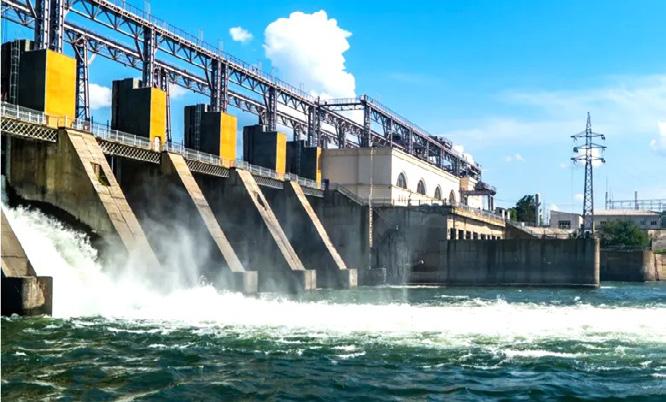
sustainable finance, regional integration, and investor-friendly policy frameworks.
The African Development Bank estimates that Africa’s energy transition will cost around $100 billion a year between 2020 and 2040. Current capital flows fall significantly short, and the financing that does exist often comes with higher risk premiums, shorter loan terms and limited flexibility.
ARDA is championing innovative financing models that blend public and private capital, lower investment risks and align global climate finance with Africa’s development priorities. To attract serious investment, Africa needs to utilise smart financing strategies that utilise public and private money, reduce risks for investors and encourage global institutions to support energy projects.
This approach can minimise risks for investors and encourage institutions to back energy projects. It is also vital to prioritise initiatives that merge renewable energy with storage systems. Not only do these projects help cut down emissions, but they also ensure a steady electricity supply, support various industries and, ultimately, strengthen the economy.
Many African countries remain reliant on fragmented, underpowered national grids that struggle to attract large-scale investment. Regional integration is essential, and it depends on harmonised regulations, cross-border infrastructure and shared power resources. Initiatives like the African Single Electricity Market (AfSEM) and the African Continental Free Trade Area (AfCFTA) lay the groundwork for collaboration. What we need now is political unity and focused investment to
transform these initiatives into platforms for energy security and economic growth.
Africa is catching the eye of global investors, but what it needs is predictability. Governments must consider implementing policies that simplify the process of permitting, financing and running energy projects. Whether it is through feed-in tariffs, tax incentives, or local regulations, the aim remains the same: to cut down on uncertainty, reduce costs and attract longterm investments.
ARDA works with policymakers to design frameworks that enable private participation, ensuring that energy projects are not only bankable but also deliver lasting local value.
The countries that will lead the continent’s energy shift are those that provide a stable and transparent environment, allowing both public and private players to collaborate with confidence. Most importantly, this energy transition must create local value.
It should focus on building skills, transferring technology and sparking new industries, from battery production to green hydrogen. Every megawatt generated should be viewed not just as electricity produced, but as a job created, a business empowered, and a supply chain bolstered.
Africa’s energy transition is about making smart choices. Cleaner fuels like natural gas will continue to play a vital role in the short to medium term, particularly in replacing high-emission diesel and fuel oil in power generation and transport. Mozambique, through its significant gas reserves and ongoing LNG initiatives, plays an increasingly important role in shaping Africa’s transitional energy future. These transition fuels are essential to maintaining reliability while building capacity for a lowcarbon future.
The investments we make today must be forward-thinking, aimed at speeding up the transition to a diverse, low-emission energy economy that promotes inclusive growth and progress. The global community stands to gain immensely from the continent’s transition. The real question is not whether Africa will make this shift; it is about how quickly and decisively the world is ready to back that journey.
The latest round of negotiations faltered after nations refused to rally around a pair of draft documents, with African delegates arguing that a treaty will significantly harm Africa’s oil and gas producers and stifle economic and industry growth across the continent
THE Intergovernmental Negotiating Committee (INC) on Plastic Pollution, meeting in Geneva in August, agreed after 10 days of talks to resume negotiations at a yet-tobe-announced future date. Lobbyists from the fossil fuel industry at the negotiations worked successfully to prevent a binding deal to slash plastic production. More than 99 per cent of plastics are made from fossil fuel chemicals.
Over 170 nations met to discuss the implementation of a legally-binding treaty on plastic pollution which, if signed, would cut the production levels of singleuse plastics, posing significant economic damages to hydrocarbon-producing countries – particularly those in Africa.
Even before the meeting, the African Energy Chamber (AEC) had come out to strongly oppose the proposed Treaty on Plastics. While the intentions behind such a treaty may stem from environmental concerns in the developed world, its implementation would devastate the petrochemical industry in Africa, the AEC argued
It said the treaty would effectively stifle the growth of Africa's oil and gas industry, leading to increased energy poverty, hindered manufacturing, stalled industrialisation and a decline in vital investments for the chemicals sector.
Gabon, Ghana, Angola and Senegal, particularly, would bear the brunt of this impact. These are nations which have longfaced economic challenges, yet they possess significant deposits of oil and gas resources.
Gabon holds two billion barrels of oil and 1.2 trillion cubic feet (tcf) of gas; Ghana has 1.1 billion barrels of oil and 2.1 tcf of gas; Senegal has one billion barrels of oil and 120 tcf of gas; while Angola has nine billion barrels of oil and 11 tcf of gas.
These resources promise to turn Africa’s economy around, primarily through opportunities in petrochemical production. The rise in petrochemical manufacturing in Africa brings with it a wave of economic benefits – from employment opportunities to the introduction of essential materials and supply chains to global trade and innovation.
Petrochemicals will catalyse development across strategic sectors, including healthcare, agriculture and transportation. Faced with both an

Single-use plastics like bottles and straws remain central to global treaty talks on curbing pollution and fossil-fuel dependence
energy and food crisis, Africa requires petrochemicals to improve livelihoods and ensure inclusive growth, according to the AEC.
It noted that by opposing the Treaty on Plastics, African nations could protect their path to energy security, industrial growth and economic prosperity. Gabon, for example, is making significant strides towards alleviating energy poverty through investments in oil and gas projects.
Targeting 220,000 barrels per day (bpd), the country seeks to diversify its economy through the expansion of petrochemicals, LNG and LPG processing. Major projects include the $2 billion Cap Lopez LNG terminal – starting in 2026 – the Batanga LPG plant and the SOGARA refinery, which targets 1.5 million tons by 2030.
The Treaty on Plastics would disrupt this growth, impacting Gabon’s efforts to strengthen its economy, the AEC argues.
Ongoing oil and gas projects in Senegal would also be jeopardised by the Treaty.
Following the start of operations at the Greater Tortue Ahmeyim (GTA) project in 2025 and the Sangomar oilfield in 2024, Senegal is advancing efforts to improve domestic fuel security, facilitate the development of new industries and spur economic development. GTA has a capacity of 2.3 million tons per annum (mtpa), with subsequent phases increasing output to five mtpa.
Sedin Engineering plans to build a refinery and petrochemical plant in the country leveraging offshore resources to produce high-value plastics and chemicals. The Treaty on Plastics would restrict this.
Meanwhile, Ghana's ambitious petrochemical park would suffer significantly, undermining the country's industrial development. The country plans to develop a $12 billion petroleum hub in Jomoro, which, following the completion
of all phases, will incorporate three 300,000 bpd refineries, five petrochemical plants, storage facilities and port infrastructure.
The Treaty on Plastics would impact this project, which has the potential to drastically improve energy and food security across the West African region. Angola – sub-Saharan Africa’s second biggest oil producer – plans to enhance petrochemical production under efforts to diversify the oil-reliant economy.
Under the Gas Master Plan – aimed at attracting $30 billion in investment and generating over $150 billion in economic benefits through the natural gas sector –Angola aims to bolster petrochemical and fertiliser production, thereby supporting the creation of new industries.
The Treaty on Plastic could see a dramatic decline in oil, gas and plastic demand, having a negative impact on Angola’s progress to diversify and grow its economy.
Tanzania – home to upwards of 57 tcf of gas reserves – is also pursuing several petrochemical and natural gas projects. Through the development of the $42 billion Tanzania LNG project, the country seeks to accelerate industrialisation, positioning itself as a global hub for oil, gas and associate by-products.
Projects such as the Tanzania Mbolea and Petrochemicals Company Kilwa Complex – a proposed project that targets a capacity of 3.8 mtpa – are central to this goal. Once completed, the plant will be the largest fertiliser-manufacturing factory in Africa producing a variety of petrochemical products, including urea and ammonia. The complex is expected to start commercial operations in 2028, but if the Treaty on Plastics is signed, it could significantly impact the project’s ability to secure financing and reach completion.
“The AEC calls on African nations, specifically Gabon, Ghana, Angola, and Senegal, to reject support for this treaty.” said N. J. Ayuk, Executive Chairman of the AEC, before the negotiations.
“We urge these countries to prioritise their energy and industrial needs over external environmental agendas that do not align with Africa's developmental priorities. Supporting this treaty would amount to shooting yourselves in the foot, making no sense for Africa's future.”
Stephen Williams reviews a timely book that examines the geopolitical dynamics that is increasingly playing a pivotal role in competition among the great powers
The Indian Ocean basin is the world’s third-largest ocean after the Pacific and Atlantic, covering about 20 per cent of the Earth’s surface. It has an area of more than 70 million square km.
The Eastern Africa littoral, which borders the Indian Ocean, stretches from Djibouti and the Bab-el-Mandeb, (a narrow chokepoint that connects the Indian Ocean and the Red Sea) to Cape Agulhas east of the Cape of Good Hope, South Africa, where the Indian Ocean meets the Southern Atlantic.
This book examines the geopolitical dynamics that continue to, and some would argue increasingly does, play a pivotal role in the great powers’ competition.
The author, Darshana Baruah, is a foreign policy scholar with a focus on maritime security. As she makes clear, the Indian Ocean has a long history of being both an important trading route, and a theatre for naval war games.
Baruah just gives a passing mention to the rivalry between the Europeans in the 18th and 19th centuries, and the book focuses on the post-World War II and postCold War state of affairs.
She might have mentioned the evidence of Phoenician traders sailing across the Indian Ocean, or the fifth and sixth voyages of the famous Chinese admiral Zheng He, when his naval fleet reached the northeast coast of Africa during the first quarter of the 15th century.
Six centuries after Zheng He sailed to the Indian Ocean through the South China Sea, China is once again engaging with the region. China’s Belt and Road Initiative (which includes the Maritime Silk Road) and investments in the Indian Ocean are discussed at length by Baruah.
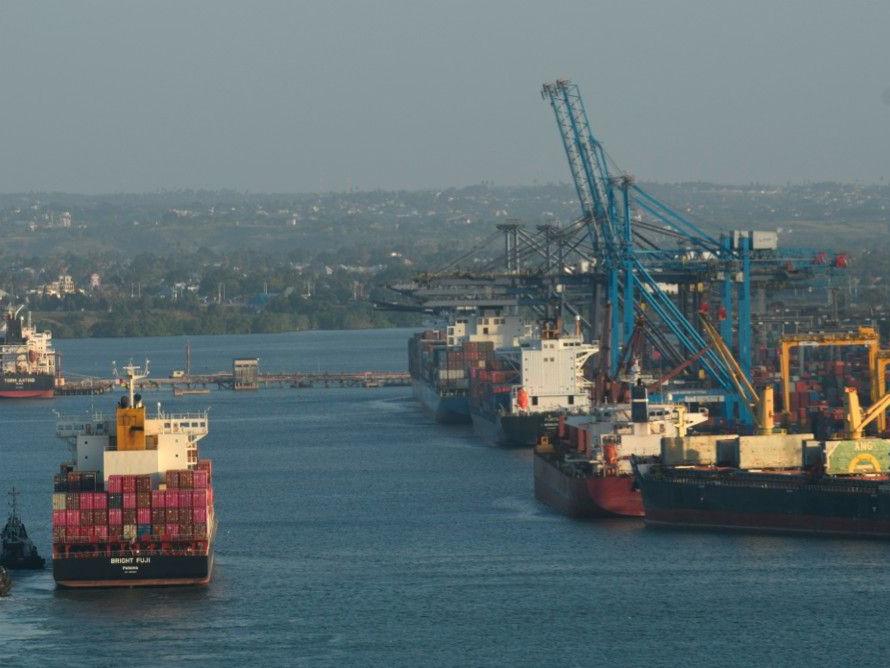
The author states: “The Hambantota port in Sri Lanka is perhaps the best-known contemporary development reflecting the factors shaping the new dynamics of the Indian Ocean.”
She refers to Maria Abi-Habib’s New York Times 2018 article, ‘How China got Sri Lanka to cough up a port’. The article posits that China uses loans and aid to gain influence for strategic and military purposes, sometimes referred to as ‘debt trap diplomacy’.
But Baruah counters this argument. “While Beijing in my view, is pursuing a strategy and following an ambition to better connect its coast to those in the Indian Ocean and Europe,” she writes, “a key aspect of this narrative is the role that
island nations are playing in advancing this objective.”
She suggests that it was the traditional great powers’ strategic inertia that led to China’s policies. Baruah says that Sri Lanka approached India and the US for a loan to build the Hambantota port and was turned down by both.
Furthermore, Harvard Business School research shows that Chinese banks are willing to restructure the terms of existing loans and have never actually seized an asset from any country, much less the port of Hambantota.
For South Africa, Mozambique, Tanzania, Madagascar and Kenya (as well as Yemen, Saudi Arabia, the UAE, Iran, Pakistan, India, Myanmar, Indonesia and
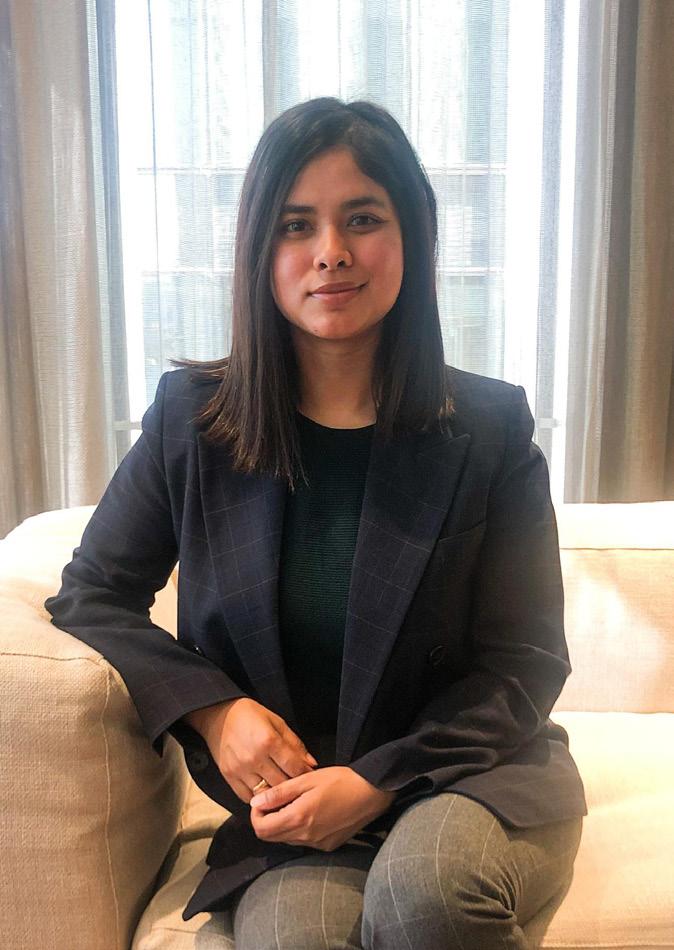
Australia), China is a key trading partner, which means that Beijing’s involvement with the Indian Ocean is necessary for its economic and energy security.
Baruah draws on a US Secretary of Defence report that states that nine out of the 10 countries that supply nearly 80 per cent of China’s crude oil depend on a transit through the Indian Ocean. The ocean also provides essential access to Africa and its resources.
Although Baruah does not comment on this, it is interesting to note a proposal that the Lobito corridor, linking Angola on the Atlantic seaboard with the Democratic Republic of Congo (DRC) and Zambia, is to be extended from Zambia to Dar es Salaam in Tanzania using the TAZARA railway.
Built to facilitate the export of Zambian copper without transiting apartheid South Africa, TAZARA was opened in 1976. The railway – which runs from Zambia’s Copperbelt to Tanzania’s deep-water port at Dar es Salaam – was Beijing's first-ever large foreign aid project.
Both Zambia and the DRC have significant deposits of tantalum, cobalt, copper and tin used in smartphones, electric vehicles etc., critical for the Chinese economy.
Baruah argues that China will have to develop a second maritime base, to complement Djibouti, and that if China wants to be a credible player in Africa, “it needs a stable and secure Indian Ocean”.
Nevertheless, both Sino-Indian and US-China competition is likely to intensify. Post-WW II, the Indian Ocean’s two major competitors were the US and USSR. The author quotes a National Security Study Memorandum on the Indian Ocean (directed by Henry Kissinger) that indicated a US policy in the region of ‘balancing’ the USSR’s naval presence.
France, the UK and India might also be considered legacy powers, but post the Cold War, the Indian Ocean’s island nations (Sri Lanka, the Maldives, Mauritius, Seychelles, Madagascar and Comoros) became independent, and France and India became the two dominant players.
But right at the centre of the Indian Ocean, midway between Tanzania and Indonesia, the Chagos Archipelago is the centre of a human rights scandal.
Referring to a 2023 Human Rights Watch report by Allan Ngari and Clive Baldwin Let Chagossians go home, decide their own future, Baruah’s book acknowledges the consequences of the great powers’ attitudes towards the peoples of the Indian Ocean islands.
For many generations, descendants of these African slaves lived on the islands, until the US identified the main island, Diego Garcia, as a suitable military airbase and nuclear submarine harbour, but wanted vacant possession.
The British government complied. Britain took control of the Chagos Islands from its then colony, Mauritius, in 1965 and went on to evict a population of more than 1,000 people to make way for the US military base, deporting the Chagossians to a life of abject poverty in Mauritius and Seychelles.
In 2000, a London court ruled that deportation was illegal, but all manner of legal subterfuge was used to stop the Chagossians returning to their homes on the island.
The US used Diego Garcia to launch bombing raids on Afghanistan in 2001 (Operation Enduring Freedom) and during the US invasion of Iraq in 2003. It was also probably used in the bombing of Iran earlier this year.
Finally, and since this book was
The Indian Ocean has a long history of being a theatre
‘ ’
The history of the Chagos’ peoples (Chagossians), and their civil liberties, clearly deserves special attention.
The Chagos Archipelago was first settled in the 18th century by African slaves and Indian contractors brought by FrancoMauritians to found coconut plantations.
More recently, in November 1965, the islands became part of the British Indian Ocean Territories (BIOT).
Britain’s handover of the Chagos Islands to Mauritius was confirmed in May 2025 despite a legal move to halt the deal.
The UK’s Prime Minister, Keir Starmer, announced that the agreement to cede sovereignty of one of its remaining imperial possessions and pay £101m (about $135m) a year to lease back a joint UK-US military base at Diego Garcia was because there was “no alternative but to act in Britain's national interest”. But significantly, no mention of the Chagossians’ interests.
published, the British managed to extricate themselves from the Diego Garcia imbroglio, reaching a multi-million-pound settlement with Mauritius which guarantees the base for the US for a further 99 years. By running the Diego Garcia base with Mauritius’ consent, the US will underscore its commitment to international law and the rules-based order.
While the UK/Mauritius official joint statement was short on details, treaty negotiations are set to start post haste. Among the issues that will be crucial to monitor are timelines, financial terms, Britain’s ongoing sovereign rights, base consultation arrangements, Diego Garcia’s status vis-a-vis the African NuclearWeapons-Free Zone Treaty.
One thing is certain. The sun is setting on the BIOT, but activities in this region will continue to be critical to African interests.
I have said my piece, and now I lay my pen:
Sierra Leone’s most accomplished writer tells Lansana Gberie about his peripatetic lifestyle that has fuelled his creativity, but says that he plans to finally return home “for good” this year
SYL Cheney-Coker has spent the better part of his life abroad, in the US, Philippines, Nigeria. He has called Atlanta, Georgia, in the US, home for the past 10 years. Cheney-Coker moved there shortly after an academic position in California, which followed a writer-in-residence position in Las Vegas, Nevada, which – the writer is the first to remind one – is known more for sin than high culture.
The City of Asylum programme in Las Vegas had been established by a rich casino entrepreneur with literary aspirations, working with Wole Soyinka. Upon the celebrated Nigerian author’s recommendation, Cheney-Coker became its first resident.
The honour was exquisitely deserved. Exile – as physical condition and as literary prop, or what he would call “spiritual condition” – has fired Cheney-Coker’s imagination through six volumes of poetry, two novels, a memoir, essays and a forthcoming novel, the last of a trilogy which began with The Last harmattan of Alusine Dunbar, the winner of the Commonwealth Prize in 1991.
Cheney-Coker first went to the US in his early 20s, in the 1960s, to study at the University of Oregon. On the face of it, an improbable choice for a middle-class young man who grew up in British-ruled Sierra Leone and heard about Oregon only when filling his application form. But the university offered him tuition to study journalism, to which he had found attraction largely because of his admiration for Sarif Easmon and Ibrahim Taqi, two political newspaper stars he followed closely as a schoolboy in Freetown.
His poetic sensibility, already regnant while a boy, began to blossom at university;
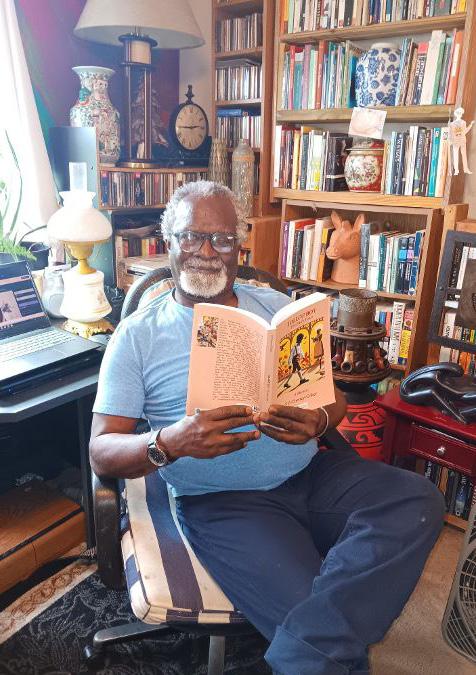
he knew he had found a calling. So was his political commitment, which began as opposition to Prime Minister Albert Margai’s desire to usher in a one-party dictatorship in Sierra Leone.
But Siaka Stevens, around whom this opposition galvanised, turned out to be far worse: as Prime Minister and later President. Stevens, perhaps to the chagrin of his liberal supporters, shunned those democratic sensibilities to which Margai, however ambitious, was attached, and declared Sierra Leone a one-party state; a process that Cyril Foray, his former Foreign Minister, described as “legal violence.” Worse, Cheney-Coker lamented in an interview with British poet Stewart Brown for Index on Censorship in the 1980s that Stevens introduced “political banditry and political violence and murder into Sierra Leone politics,” replacing “a very civilised and tolerant society”.
Cheney-Coker watched these developments from a distance in horror; they reinforced his sense of physical alienation from his country and fired his imagination. His first volume of poetry, Concerto for an Exile (1973), was a direct result, he has said, of the execution of Brigadier John Bangura, whom Stevens had perceived as a political opponent.
He wrote The Executed (1975), a powerful meditation on political murder, in memory of his early hero Taqi, a leading light in the campaign against Margai, who was also executed under Stevens.
So, from the start, Cheney-Coker has been a political writer, deeply engaged with the current affairs in his country. Those lines of anxiety ultimately extended to all of Africa, the African diaspora and the globe as the result of Cheney-Coker’s engagement with the politics of identity, race, neocolonialism, oppression.
“I believe,” he wrote in an introduction to a volume of poetry published in 2015, “that my poems have always been linked by three common themes: the awakening of my identity; the pain of exile; and a basic concern for those whose humanity is sometimes threatened by others”.
The anxiety is visceral. “I think it is something I probably inherited from my mother, who was a fearless woman,” Cheney-Coker told me. “She was a loving, caring model, very alert to social justice, a strong sense of concern for humanity …
“I just did not like the idea of anyone being bullied, even when I was a child, because I came into this world, I might say,
with two handicaps, which I mentioned in the memoir. One, my skin was very dark, you know…”
Handicap? “Yes, it was sort of a handicap in Sierra Leone at the time. Colonialism, [and] the stupidity of colourism, you know, foisted on black people, whether we were in the Caribbean or in Africa. When I was growing up in Freetown, I was occasionally provoked for my very dark skin.
“But the bigger handicap was that I was left-handed, and that was seen as some sort of defect. I felt persecuted as a human being, so I can easily sympathise with other persecuted humans.”
Cheney-Coker’s memoir, published early this year, is called Jollof Boy: The Early Years. The title adapts the nickname that his Grandma Tucker, a matronly neighbour in Freetown, gave him because
favourite), which, he said, he will wash down with glasses of wine.
He goes to bed very late and wakes up in the early afternoon. I got a sense while speaking to him on the phone that this routine was not to be interrupted. It was his writer’s quirk.
Jollof Boy refracts powerfully on Cheney-Coker’s life and work: his growing up in the East End of Freetown (Patton Street), his college education in the US, his love affairs (beginning with a married Mandingo woman, who he immortalises in a beautiful poem, through several women in the US, his marriage to a Filipino woman following a professorship in her country, his acclaimed writing career.
He clearly left an impression in the Philippines. Ambassador Evan P. Garcia, Philippines former Permanent Representative to the UN in Geneva, shared
The stupidity of colourism foisted on black people in the Caribbean or in Africa by colonialism ‘ ’
of his very dark skin. She meant Wolof Boy, believing that the skin tone resembled that of Senegalese of that ethnicity, whom she adored. Cheney-Coker loved her for this.
The memoir, which he wrote upon the suggestion of Dr. Osman Sankoh, the everresourceful publisher of the Sierra Leonean Writers Series, takes the great poet through his first 30 years, ending at a moment when the trajectory of success as a writer had been set: a volume of well-received poetry, Concerto for an Exile, published, a visiting professorship in the Philippines, the beginning of a happy family life.
With the publication of the memoir, Cheney-Coker said, his work was done. “I have said my piece,” he concludes, “and now I lay my pen.” He turned 80 shortly after the memoir was published.
Though a perennial expatriate, living thousands of miles away from his country of birth, Cheney-Coker says he feels very Sierra Leonean. When I called one afternoon, the writer was busy preparing cassava leaves stew (a Sierra Leonean
his memory of a pipe-smoking Sierra Leonean former professor of his to me as a form of compliment about how smart people from our country are.
I learnt from Jollof Boy that the pipesmoking is serious business, not a prop. Cheney-Coker had started it when he was barely 20, as a sort of balm for a toothache; 60 years on he still enjoys the lunting.
In Ode to my Pipe, he writes: “At twenty, I had not smoked a cigarette/Since then, no fag has grown grass on my lips;/ but the happiness of pipe-smoking has been my love…”
I first read Cheney-Coker intensely when I began to write my book on the civil war in Sierra Leone, beginning with his early poetry and then getting through The Last Harmattan. I have always felt that good fiction best captures the soul of a country, much more than political or historical accounts. Facts may be ignored, elided or disputed, but great fiction never lies.

I had been mesmerised by CheneyCoker’s early poetry, and though I had some difficulty with The Last Harmattan, I felt that its concentrated insights into the workings of tyrannical power was unmatched.
But the work that I felt most encapsulates the writer’s passion and commitment, and that worked best for me as I tried to make sense of what was generally seen as a senseless war, was Letter to a Tormented Playwright. The poet has himself called it his “most humanist”.
Cheney-Coker wrote the poem after spending time with another Sierra Leonean writer, Yulisa Amadu Pat Maddy, in London during a visit. The tormented older artist – playwright, novelist, dancer – had been briefly imprisoned by Stevens’ government and had moved to live in London upon his release. There, he found work at a telephone office.
He had written nothing at all after his rather transgressive but not particularly distinguished first novel, No Past, No Present, No Future (1973), and had become somewhat dissolute, drinking heavily.
With exact economy, the poem, which is addressed directly to Maddy, tells of Cheney-Coker’s meeting with Maddy “in the damp chilly English coffee shops” where they read poetry together. The younger more successful poet urged Maddy to “remember… how terrible I said it was/ that you were in exile and working/in the Telephone Office in touch with all/the languages of the world but with no world/ to call your own; how sad you looked that winter/drinking your life…”
The reader is captivated by the sheer intelligence and sympathy and passion of the poet as he is taken through the narrative, famous names dropping, towards the deeply moving conclusion: “But already the walls
are closing around me/the rain has stopped and once again I am alone/waiting for them, the politicians of our country to come for me/to silence my right to shouting poetry loud in the parks/but who can shut up the rage the melodrama of being/Sierra Leone/ the farce of seeing their pictures daily in the papers/the knowledge of how though blindfolded and muzzled/something is growing, bloating, voluptuous and not despairing/I say to you for now, I embrace you brother.”
I used these last lines to preface a chapter of my book, though the publishers had the stanzas mangled. But such is the charm of Cheney-Coker’s unaffected, vernacular register – like Auden’s – that they worked perfectly in prose form. This is the Cheney-Coker I came to cherish, the poet who so perfectly captured the anxieties and yearnings of a whole nation. I feel that Cheney-Coker’s poetry is among the very best that has emerged out of Africa. His volume of poems, Stone Child and Other Poems (2008), which he wrote mostly in Sierra Leone, contains the best war poems from Africa I have read.
Before Cheney-Coker left Sierra Leone to study in the US, he writes in Jollof Boy, his mother took him to “one of her fortunetellers so that he could divine any future in that faraway place”.
They found the wizened old man sitting, cross-legged, on a goatskin mat. “In front of him was a small enamel bowl of water containing some kola nuts; and very close to that bowl was his divining mirror.”
Cheney-Coker remembers the precise details of the scene probably because what the fortune teller divined for him turned out to be prescient. He, brought up a Christian, found value – indeed validation – in what some others of his background would have regarded as heathen superstition. The experience, though brief, appeared to have been fundamental. He uses the scene in The Last Harmattan. It forms part of the basis of the literary technique he used in that novel and in Sacred River (2013), a technique that some critics have called “magical realism”, linking it to a genre that originated from the famed Colombian writer, Gabriel García Márquez.
Cheney-Coker disputes this interpretation but does not, advisedly, deny the influence. In the memoir he also mentions observing itinerant Tuareg traders hawking their cheap trinkets and other artisanal goods on the streets of Freetown and then suddenly disappearing from the scene, something that easily reminds one of
the opening pages of Márquez’s A Hundred Years of Solitude (1967), recently made into a fantastic Netflix documentary, which shows wandering Gipsies doing something similar and similarly exiting the scene.
It is a method forced upon CheneyCoker by circumstance. It is an extraordinary effort of intelligence and sympathy, working from very thin material, which has helped him to overcome, with some success, what might be described as a structural disability.
“Nigerian writers of my generation came from a very rich background,” Cheney-Coker has noted, in an interview by a journalist that was published this year on the blog, Poda Poda.
Chinua Achebe drew from his Igbo society – a beautifully-ordered, integrated, complete society – to write his masterpiece, Things Fall Apart (1958); Wole Soyinka similarly drew from his confident Yoruba society.
Cheney-Coker had no such society. These writers were from an earlier generation, benefiting, particularly with respect to the novel form, the wider appreciation of something new and exotic. This works best in such societies, and for which Achebe was an undoubted African pioneer.
To write The Last Harmattan (and then The Sacred River), Cheney-Coker had to invent a society – he called it Malagueta –which has resemblances but also differences with Freetown, an amalgam. And he had to draw deeply upon history and myth to do so, based upon his deep reading and his fleeting encounters as a child with fortunetellers and Tuaregs.
As a Creole, the descendant of repatriated Africans from different backgrounds who had been feed from slavery – he discovered growing up that a large part of his heritage was Igbo –Cheney-Coker had to, he told a journalist, undertake “a subterranean journey… to find myself”.
The writing of Last Harmattan forced him to confront his identity as a cultural hybrid. In it, he had one of his characters, locked up in prison for attempting a coup, say this (doubtless about the Creole): “Modes of behaviour long abandoned in the factories and gutters of England were still being copied with diligence by the despicable lot who made up the middle and upper classes. They were men and women whose other passion was drink tea in the afternoon in the ovens of their drawing
rooms and parlours modelled on the antediluvian style of pre-abolition America while worrying about the cost of taking holidays in England.”
This, then, was an inauthentic society, a mimicry. It is, as he told me, CheneyCoker’s view. He has created a term, AfroSaxon, to describe people like himself from that society; and he expresses the sentiment fully in a poem entitled An ‘Afro-Saxon’ Looks Back, which is included in The Road to Jamaica (published in 2015).
It is his first use of the term, but the poem – part of a collection from 1968-1970 and 2012-2013 – is not dated. He did not tell me when he coined it, only that he first used it in that poem.
I suspect that he came to it after The Last Harmattan; it is the voice of a mature, older poet: “With age, I can write about my two-navelled history;/theirs about mine; a middle-passage taste of/bitter brewed with my roots, the splintered/ancestral memories!”
And: “I drank the torment of my people from that/Christian English teapot, the baptismal water, Easter liturgy/Handel’s
the lack of a deep social context shows in both The Last Harmattan and Sacred River. It is the reason why the implied criticism of their being in the mode of “magical realism” has persisted, despite CheneyCoker’s spirited rejection of the term.
The novelist is an outsider to some of the societies that he had meshed together to form Malagueta; his knowledge of them is surface: a young boy’s observation of strange Tuaregs on Patton Street in Freetown, an hour’s visit to a fortune-teller, a triumphant lay of a beautiful Mandingo woman. Perhaps inevitably, both novels are morally freighted, the main villain – a Siaka Stevens lookalike – coming to grief in the end. Justice comes in the form of otherworldly intervention: the ancient gods always punished the despoilers of this world. It is a romantic view, for there is hardly ever justice in this world. This is in part because those who champion the cause of justice are often those least subjected to injustice; justice for such a pursuit becomes something of an abstraction. A peasant deprived of his land may get satisfaction when that land is returned to him, but there
Nigerian writers of my generation came from a very rich background ‘ ’
Hallelujah Chorus, Bach’s Saint Mathew Passion/Our foreign catalogue of names/O proud, delusional souls!” Eldred Jones, from a similar background, long rejected this sort of characterisation. In a 1968 essay, he wrote that the Creoles “as they celebrate their weddings with gumbe music or dance in evening dress to the strains of Westernstyle bands, or talk to their dead during an awujo feast, or sing Bach in the choir on Sundays, seem quite unaware of their ‘rootlessness’, and display a surprising selfconfidence”. But Jones, a great scholar and literary critic, was not a creative writer; not a novelist, like Cheney-Coker, and did not have to confront the difficulty in the same sort of way. Abioseh (Davidson) Nicol, William Conton and Lenrie Peters, though perhaps more erudite than their Nigerian counterparts of their generation, produced, when they attempted, negligible fiction.
Cheney-Coker, using inventive technique, has been a far greater success as a writer than all those three combined. Still,
is little that can satisfy the intellectual idealist or revolutionary short of the destruction of their enemies. Justice makes sense only as revenge. It is the reason why the struggle for justice often leads to greater enormities than its absence.
Perpetual exile, Cheney-Coker has said, is intolerable. He is determined to go home “for good” this year, he says. He has built a salubrious retirement home up at Leicester Peak. He had found inspiration after a visit to Soyinka’s massive eco-friendly home in Abeokuta.
“To be a writer,” Cheney-Coker recently told a journalist, “is to be consumed by a passion that no other expressive cultural form does to you because writing is a lonely vocation, as opposed to being a composer, a musician, or a painter.”
The passion suffuses all his works, including his memoir.
Dr Lansana Gberie is Sierra Leone's Ambassador to Switzerland and Permanent Representative to the UN in Geneva. He is the author of, among others, A Dirty War in West Africa: the RUF and the Destruction of Sierra Leone (London: Hurst, 2005).

